This brief discusses the experiences of early career Black, Latina, and Afro Latina women in the trades. The COVID crisis has put a spotlight on the concentration of Black, Latina, and Afro-Latina women in low-wage jobs, including in many essential healthcare and retail jobs. The skilled construction trades have given many women an alternative to the poorly paid jobs in the service sector that many had to turn to before finding the trades. Skilled construction trades provide opportunities to build careers that are both challenging and fulfilling, pay a family sustaining wage with benefits, and can be accessed through ‘learn as you earn’ apprenticeships.
Topics
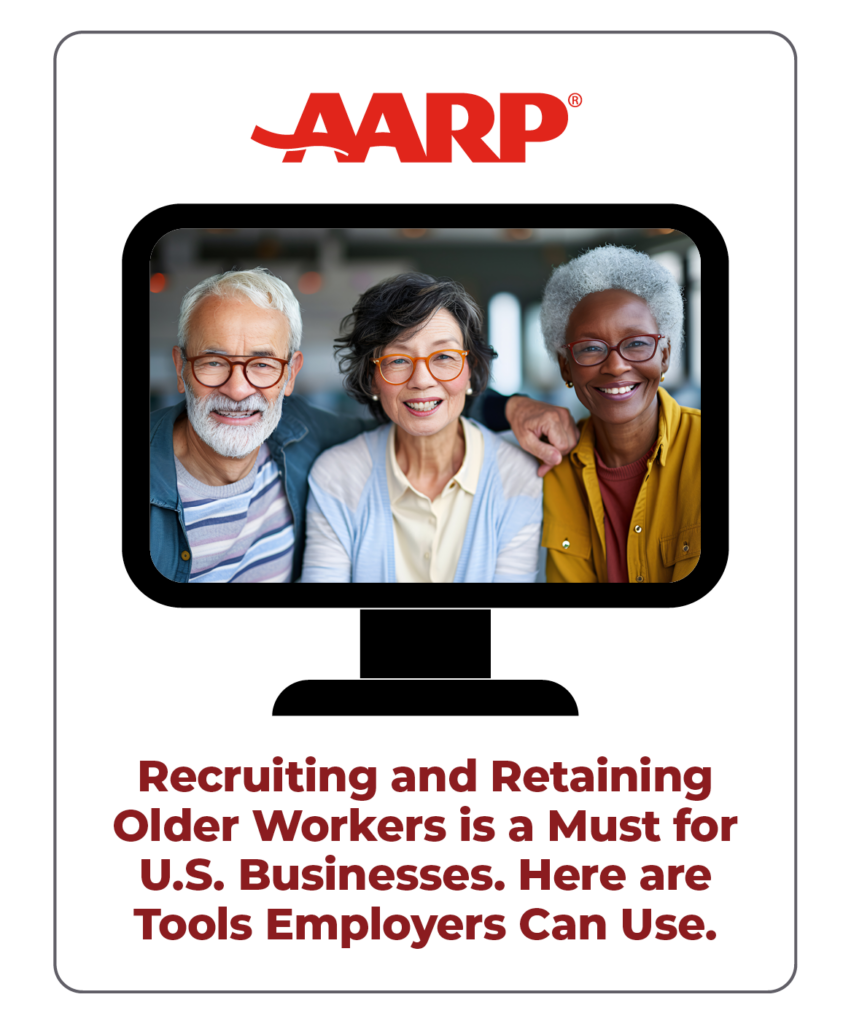
Recruiting and Retaining Older Workers is a Must for U.S. Businesses. Here are Tools Employers Can Use.
AARP
July 2024
Shifting demographics in the U.S. workforce indicate that businesses are probably going to need to recruit, train, and retain older workers to ensure their companies remain competitive. However, workplace surveys indicate that most firms are currently not prepared to find and welcome workers who are 50 years of age or older.
Fortunately, a broad array of evidence-based hiring and talent development strategies are at the ready for U.S. employers. These strategies draw from a recent and comprehensive review of employer practices and their influence on economic security and mobility for U.S. workers who experience structural disadvantages and exclusion from opportunity in the labor market.
Three key connected takeaways for employers to consider as they plan for ways to leverage this segment of the workforce are as follows:
• Engage directly with older employees in developing their digital skills.
• Seek out the social networks in which older workers operate to find the best recruiting matches.
• Lean into current or former employees and their online connections to identify these social networks.
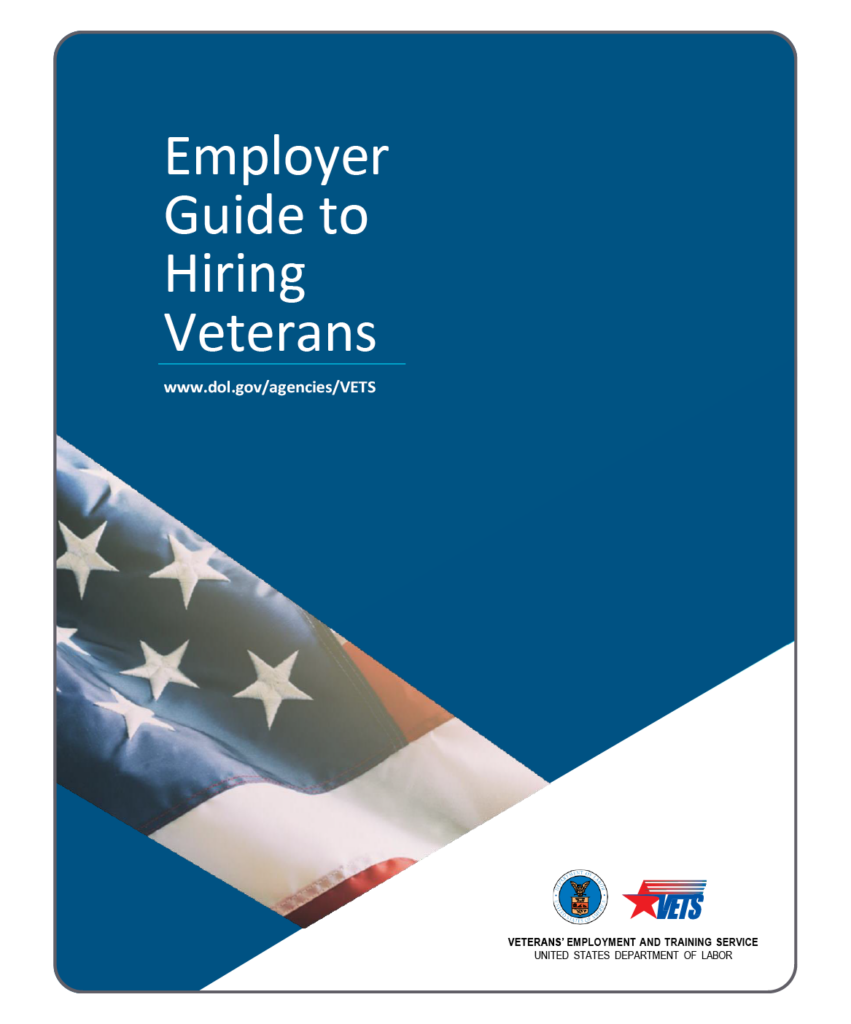
Employer Guide to Hiring Veterans
Employers recognize the value veterans bring to the workplace but often find it challenging to connect with separating service members and veterans seeking employment. Veterans are in high demand, so it requires dedicated efforts by employers to find and hire veterans.
This guide intends to:
• Provide accurate information about service member and veteran demographics.
• Share federal, state, and other resources with employers to facilitate veteran employment; and
• Make recommendations on how to attract, train, and retain veterans.
United States Department of Labor
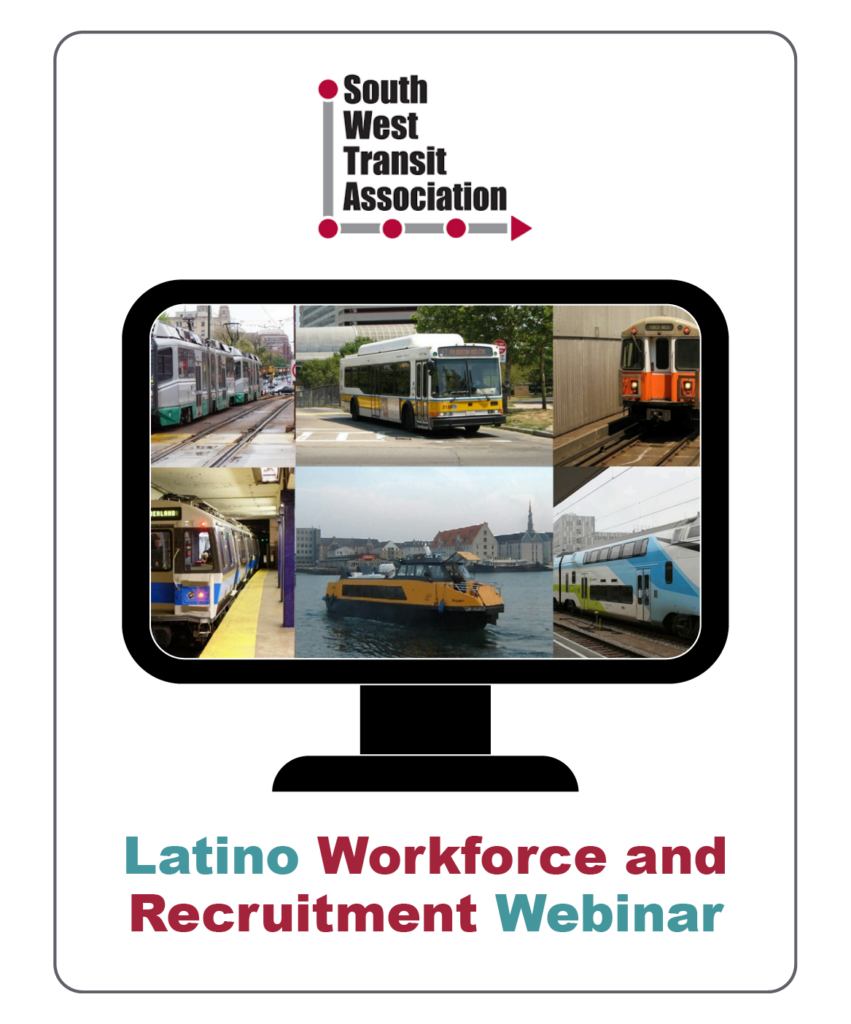
Latino Workforce and Recruitment Webinar
In this webinar, panelists explore crucial strategies for not only attracting but also retaining Latino demographics within your organization. The session delves into the latest industry trends, innovative development approaches, recruitment incentives, and cultural insights for engaging with all demographics effectively. Hear directly from the experts at Latinos In Transit as they discuss the opportunities available for employers seeking to tap into this rapidly growing demographic.
South West Transit Association
May 2024

Mississippi’s Developing Responsible Individuals with Valuable Education (DRIVE) Program
This TWC case study is about the Mississippi Developing Responsible Individuals with Valuable Education (DRIVE) Program, which uses Emergency Solutions Grants (ESG) from the U.S. Department of Housing and Urban Development, distributed by the Mississippi Home Corporation (MHC), to partners such as Grace House, Inc. and Community Development, Inc. (CDI). These partners use the funding in a variety of creative ways to provide housing and other supportive services to DRIVE participants while they complete training and certification for a commercial driver’s license (CDL). Partners also provide job assistance to participants, placing them and helping them succeed in local transit jobs. Learn more about the program, services offered, and how stakeholders leverage funding in the full case study.
Transit Workforce Center
May 2024
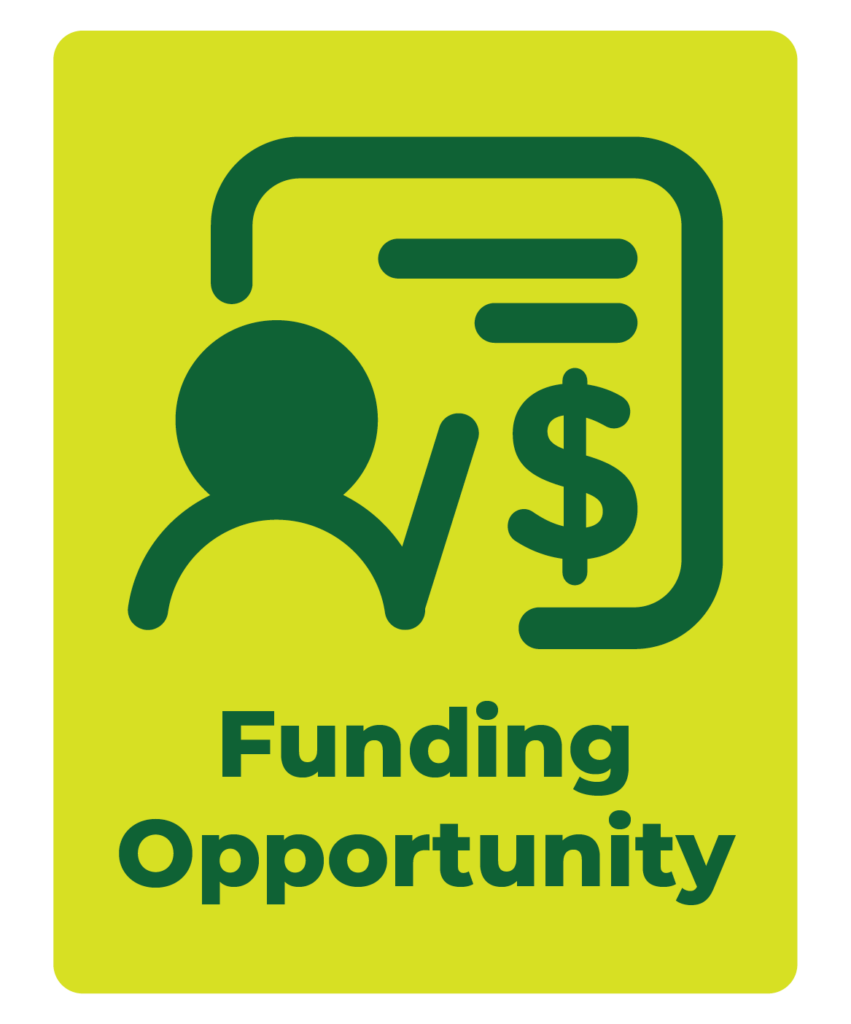
Workforce Opportunities for Rural Communities (WORC) Round 6: A Grant Initiative for the Appalachian, Delta, and Northern Border Regions
Administering Agency: Department of Labor, Employment and Training Administration
Posted Date: Apr 4, 2024
Closing Date for Applications: Jun 20, 2024, 11:59 pm Eastern Time
Estimated Total Program Funding: Total funds available: $49,200,000 — Grant award maximum: $1,500,000; Grant award minimum: $150,000
Geographic Scope: Appalachian, Delta, and Northern Border Regions
Description: The Employment and Training Administration (ETA), U.S. Department of Labor (DOL, or the Department), announces the availability of approximately $49,200,000 in grant funds authorized by the Workforce Innovation and Opportunity Act (WIOA) for the sixth round of Workforce Opportunity for Rural Communities (WORC) Initiative demonstration grants. The WORC Initiative provides grant funds to enable impacted communities to develop local and regional workforce development solutions aligned with existing economic development strategies and community partnerships to promote new, sustainable job opportunities and long-term economic vitality. Questions regarding this Funding Opportunity Announcement (FOA) may be emailed to DOL-ETA-DWG@dol.gov. We encourage prospective applicants and interested parties to use the Grants.gov subscription option to register for future updates provided for this particular FOA.
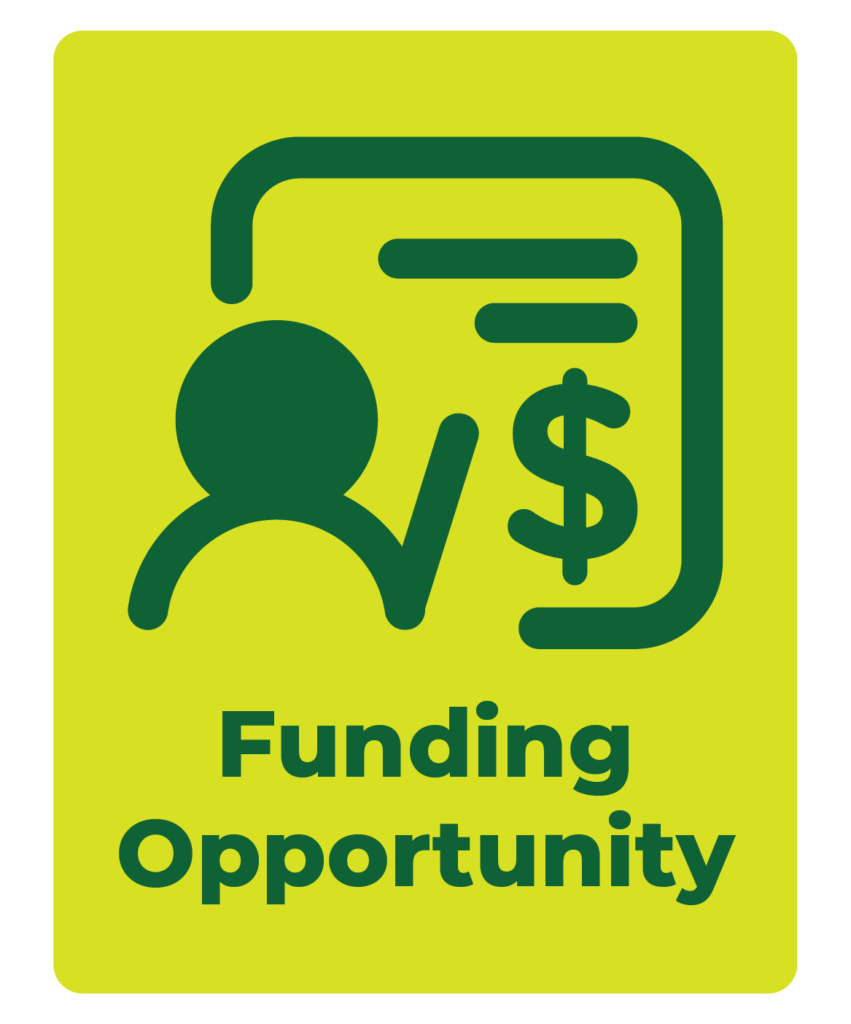
Women in Apprenticeship and Nontraditional Occupations (WANTO) Technical Assistance Grant Program
Administering Agency: U.S. Department of Labor, Womens Bureau
Posted Date: Apr 11, 2024
Closing Date for Applications: Jun 10, 2024
Funding Range: Total funds available: $6,000,000 — Grant award maximum: $750,000; Grant award minimum: $350,000
Geographic Scope: National
Description: This program aims to provide technical assistance (TA) to employers (which may include public sector entities) and labor unions in the United States and its territories to encourage employment of women in both apprenticeable occupations and nontraditional occupations (A/NTO), specifically in the following ways:
- Developing (establishing, expanding, and/or enhancing) pre-apprenticeship, youth apprenticeship, Registered Apprenticeship (as defined in Appendix B “Acronyms and Definitions”), or other nontraditional skills training programs designed to prepare women for careers in A/NTO;
- Providing ongoing orientations or other resources for employers, unions, and workers on creating a successful environment for women in A/NTO; and/or
- Setting up support groups, facilitating networks, and/or providing supportive services (as defined in section IV.E.3) for women in A/NTO to improve their retention.
Applicants may propose to provide technical assistance to support women’s participation and success in the full range of industries in which women are historically underrepresented or where women are disproportionately concentrated in the lower-wage occupations. Such industries include, but are not limited to; advanced manufacturing, construction, energy, health care, information technology, finance, and transportation. Applicants with experience working with or as an equity intermediary are encouraged to apply, as well as applicants with a proposed focus on expanding outreach/recruitment to historically underrepresented communities, including but not limited to women of color and women with disabilities, women at or below the federal poverty line, formerly incarcerated women, immigrant women, transgender women, and women who live in rural geographic areas
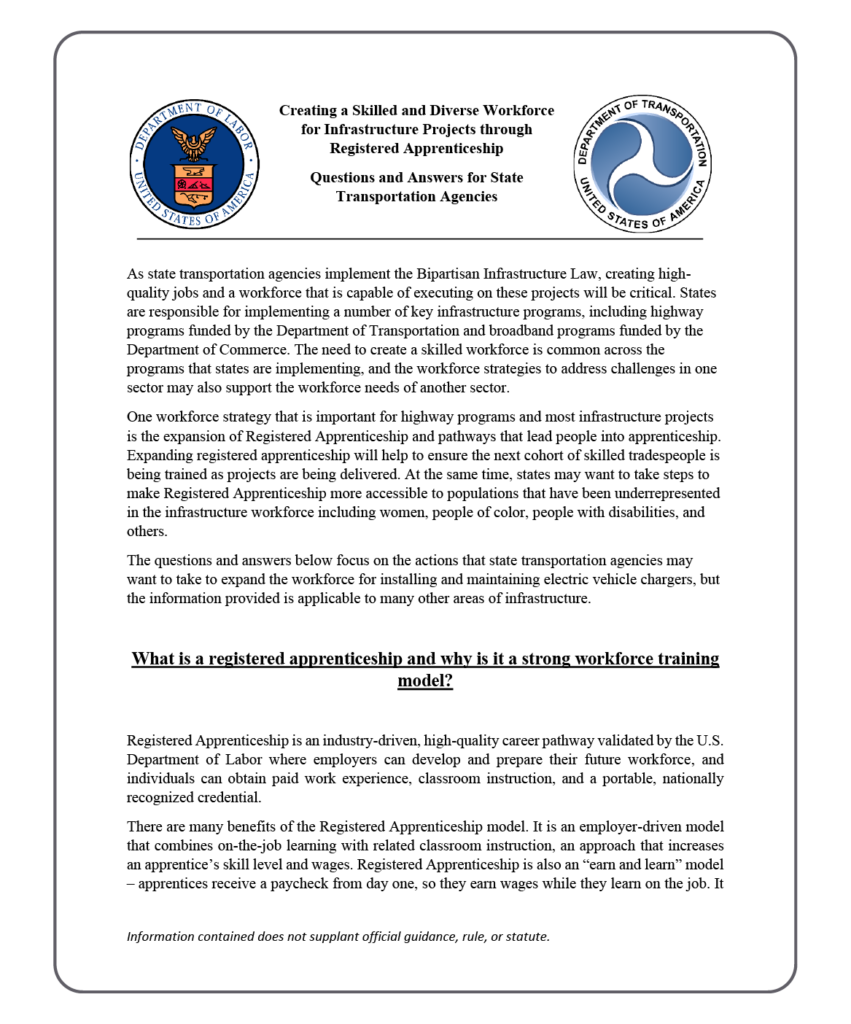
Creating a Skilled and Diverse Workforce for Infrastructure Projects through Registered Apprenticeship
The expansion of Registered Apprenticeship and pathways that lead people into apprenticeship is an important workforce strategy for many infrastructure projects. Agencies can take steps to make Registered Apprenticeship more accessible to populations that have been underrepresented in the infrastructure workforce including women, people of color, people with disabilities, and others.
The questions and answers in this resource focus on expanding the workforce for installing and maintaining electric vehicle chargers, but the information provided is applicable to many other areas of infrastructure and transportation.
Department of Labor, Department of Transportation
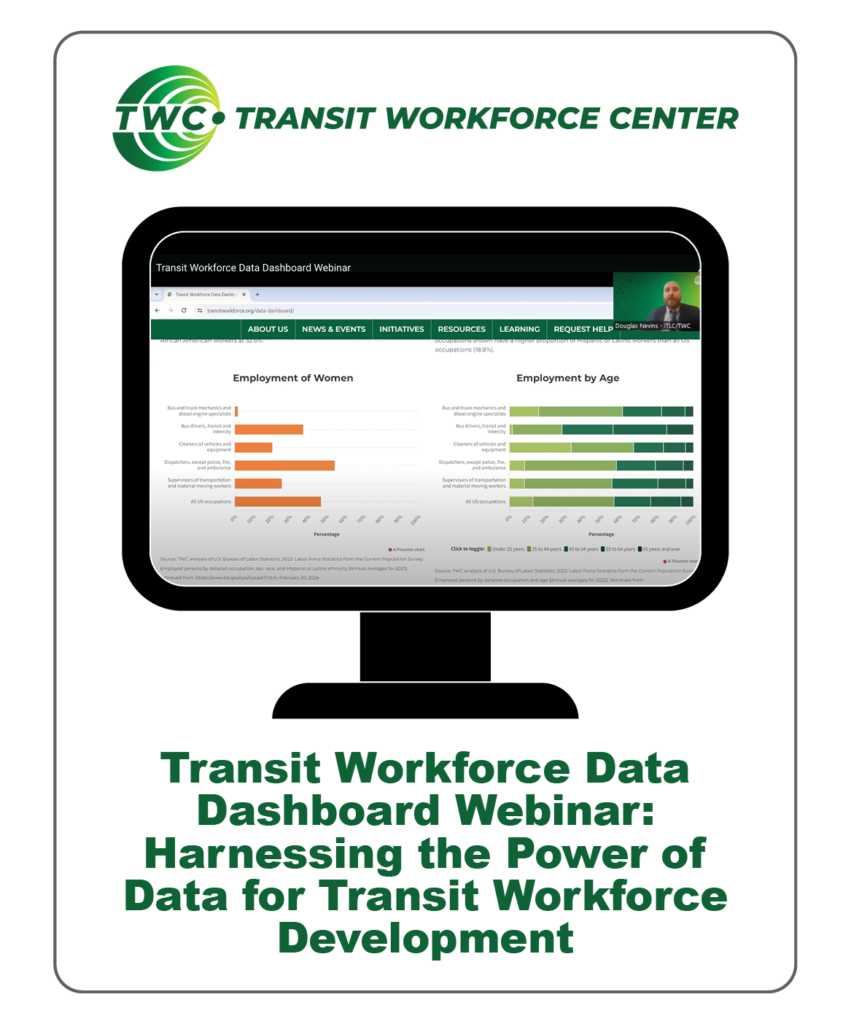
Transit Workforce Data Dashboard Webinar: Harnessing the Power of Data for Transit Workforce Development
TWC hosted a webinar titled “Transit Workforce Data Dashboard Webinar: Harnessing the Power of Data for Transit Workforce Development” on February 28, 2024. The Dashboard features innovative visualizations of transit and transportation workforce statistics and demographics from the National Transit Database (NTD) and Bureau of Labor Statistics (BLS). It can be used to highlight key issues, like the high proportion of transit workers nearing retirement age, the potential for greater participation of women in key transportation occupations, and the need to hire extensively in the coming decade. A new interactive page launched in February, allowing users to filter NTD employment data by agency.
TWC demonstrated the full dashboard, discussed lessons learned from working with NTD and BLS data, and opened up a Q&A for participants to ask questions or share their unique data needs.
Transit Workforce Center
February 2024
At the end of the webinar, TWC shared a survey to collect unique transit workforce data needs and feedback for potential additions to the Data Dashboard. The survey continues to accept responses and can be found below.
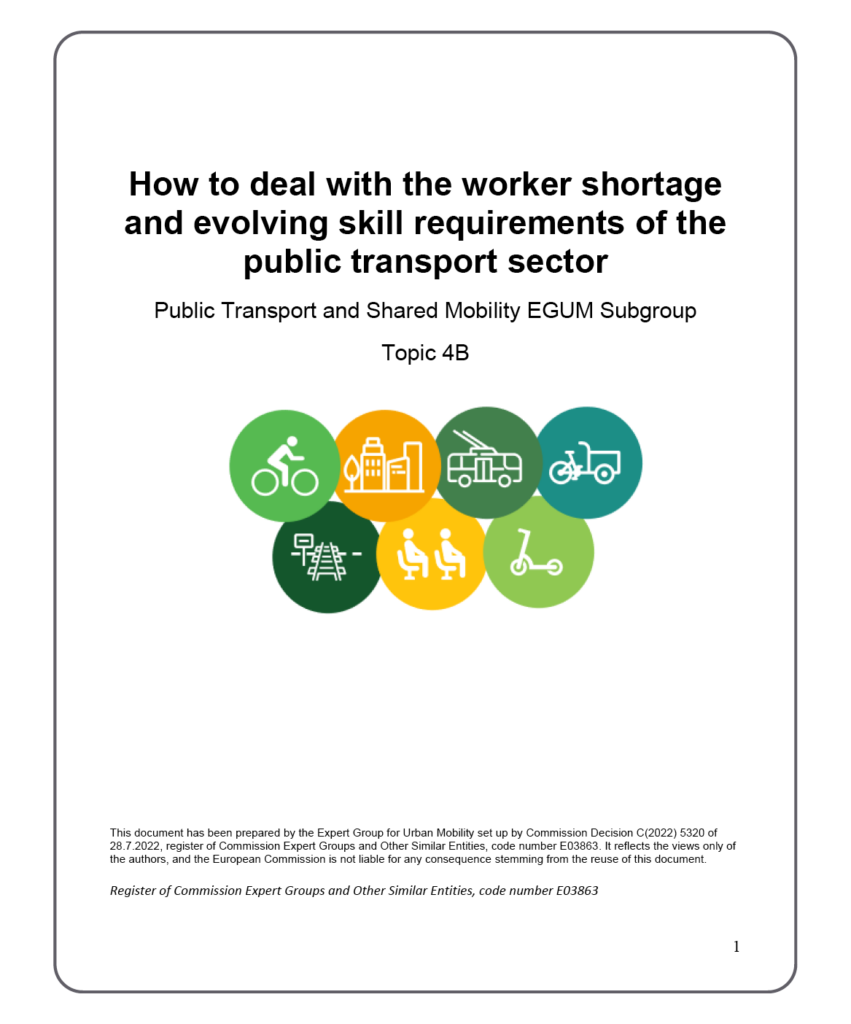
How to Deal with the Worker Shortage and Evolving Skill Requirements of the Public Transport Sector
This report provides a European counterpart to those produced within the United States on the transit workforce shortage. It gives an overview of the workforce shortage’s causes, as well as recommendations for addressing evolving skill requirements, diversifying the workforce, and more.
Expert Group on Urban Mobility, European Commission
February 2024
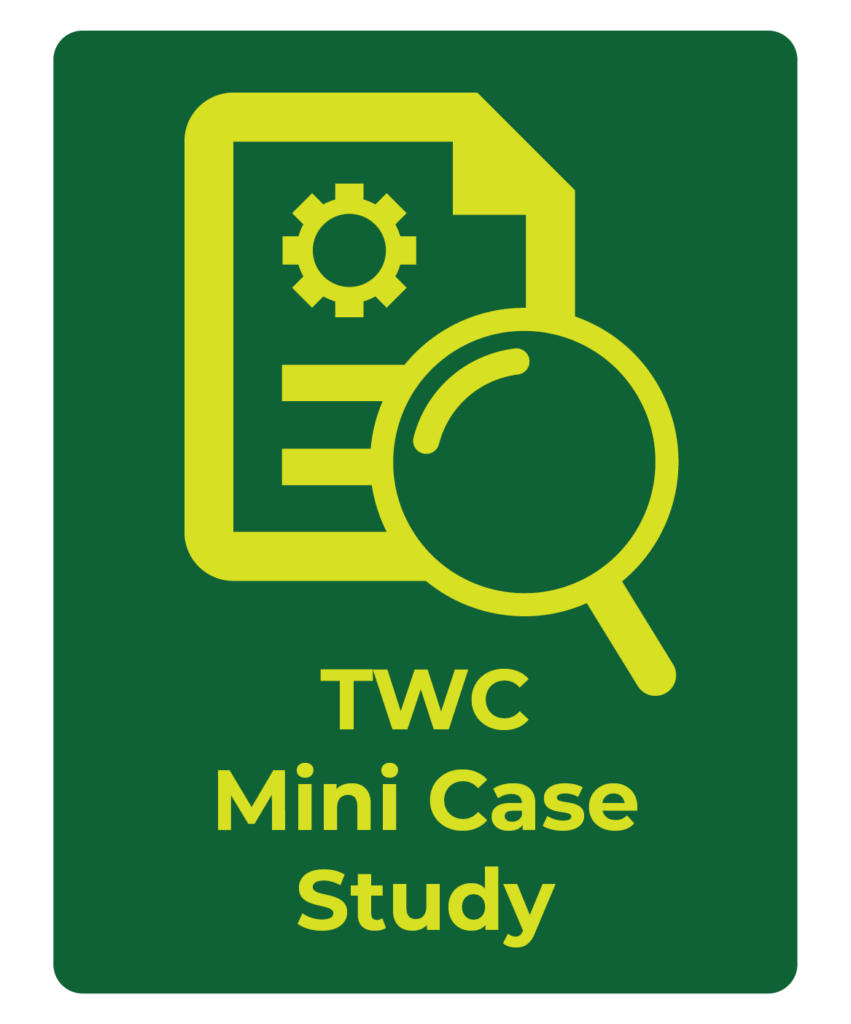
Case Study: Golden Gate Transit & Amalgamated Transit Union Local 1575
Marin County, California-based Golden Gate Transit (GGT) operates commuter bus lines in four Bay Area counties, including San Francisco. Like many agencies, GGT has struggled with operator recruitment and retention. To address these challenges, the agency and the union representing operators, Amalgamated Transit Union Local 1575, formed a labor-management partnership, the Workforce Investment Network (WIN). The WIN partnership has implemented bus operator mentorship, apprenticeship, and pre-apprenticeship programs; formed partnerships with educational institutions and community groups; made policy changes to promote diversity, equity, and inclusion; and identified opportunities to remove particular barriers to entry for job seekers.
Transit Workforce Center
February 2024
Read Rich Diaz’s Transit Career Story on the TWC Blog to learn more.
View the full case study below:
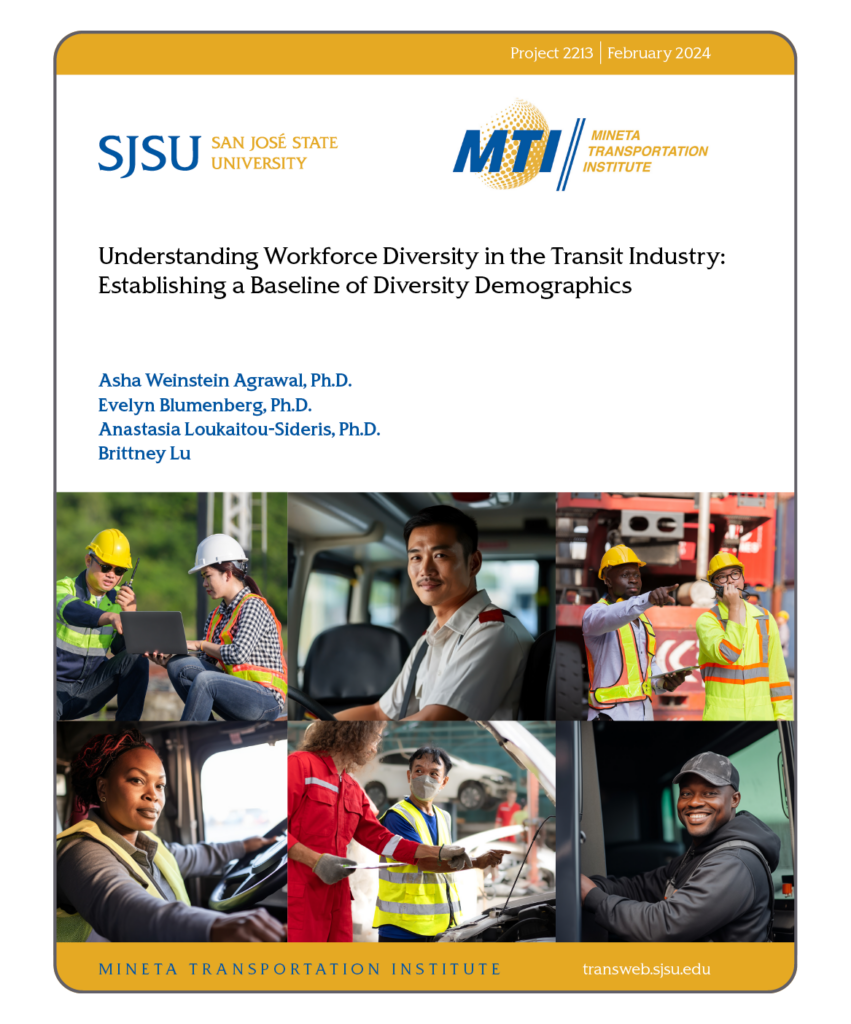
Understanding Workforce Diversity in the Transit Industry: Establishing a Baseline of Diversity Demographics
This study provides baseline data on the status of the racial/ethnic and gender diversity of the transit agency workforce in the U.S. and identifies potential barriers and promising practices for diversifying this workforce.
Mineta Transportation Institute
February 2024
The study updates those earlier studies with newer data drawn from five discrete research tasks:
- review of the scholarly and professional literature on the topic;
- review of the websites of the 50 largest transit operators;
- analysis of employee demographic data submitted by 152 transit operators as part of Equal Employment Opportunity (EEO) program plans;
- analysis of responses to an original survey sent to the human resources personnel of transit agencies (92 responses from staff at 68 agencies), and
- interviews with 12 professionals selected for their expertise in transportation workforce diversity monitoring, management, and/or advocacy.
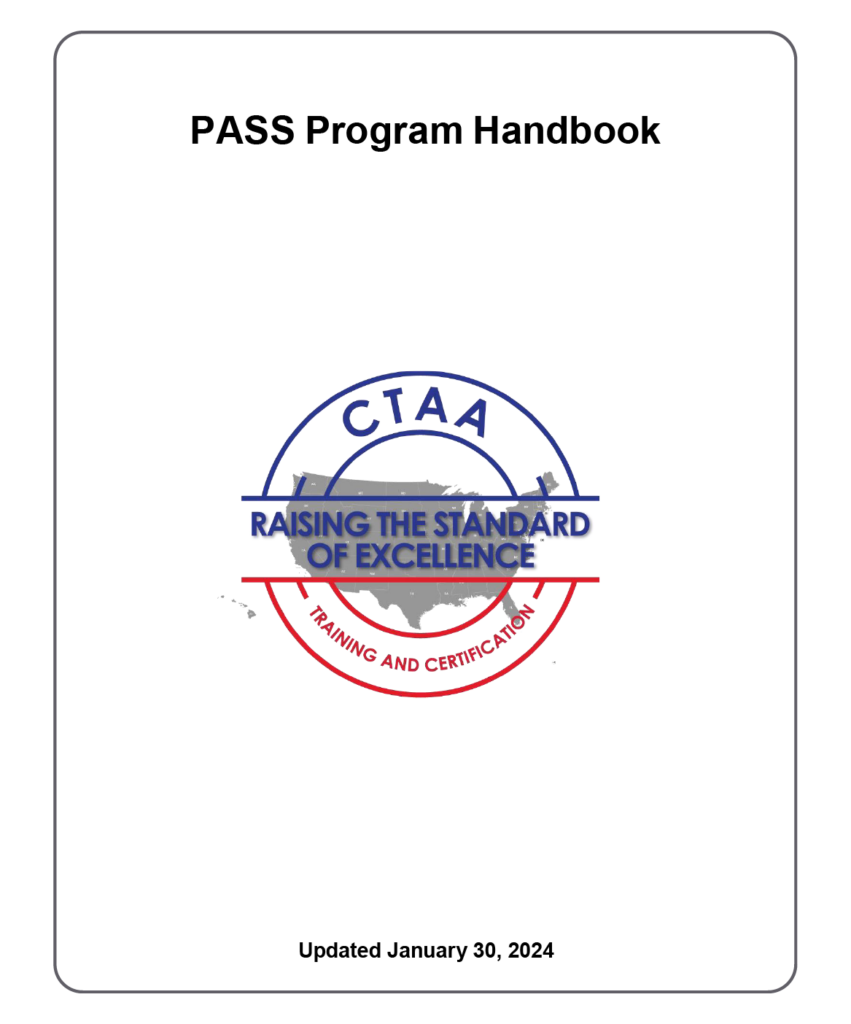
Passenger Assistance, Safety And Sensitivity (PASS) Program Handbook
CTAA’s Passenger Assistance, Safety and Sensitivity (PASS) driver training program provides resources and standards for operators to transport passengers in the most safe, sensitive and careful manner possible. PASS is ideal for non-emergency medical transportation (NEMT) trips, for ADA paratransit services, for specialized transit for older passengers, for human and social service riders — really any transportation operation where the passengers require extra care.
Community Transportation Association of America
January 2024
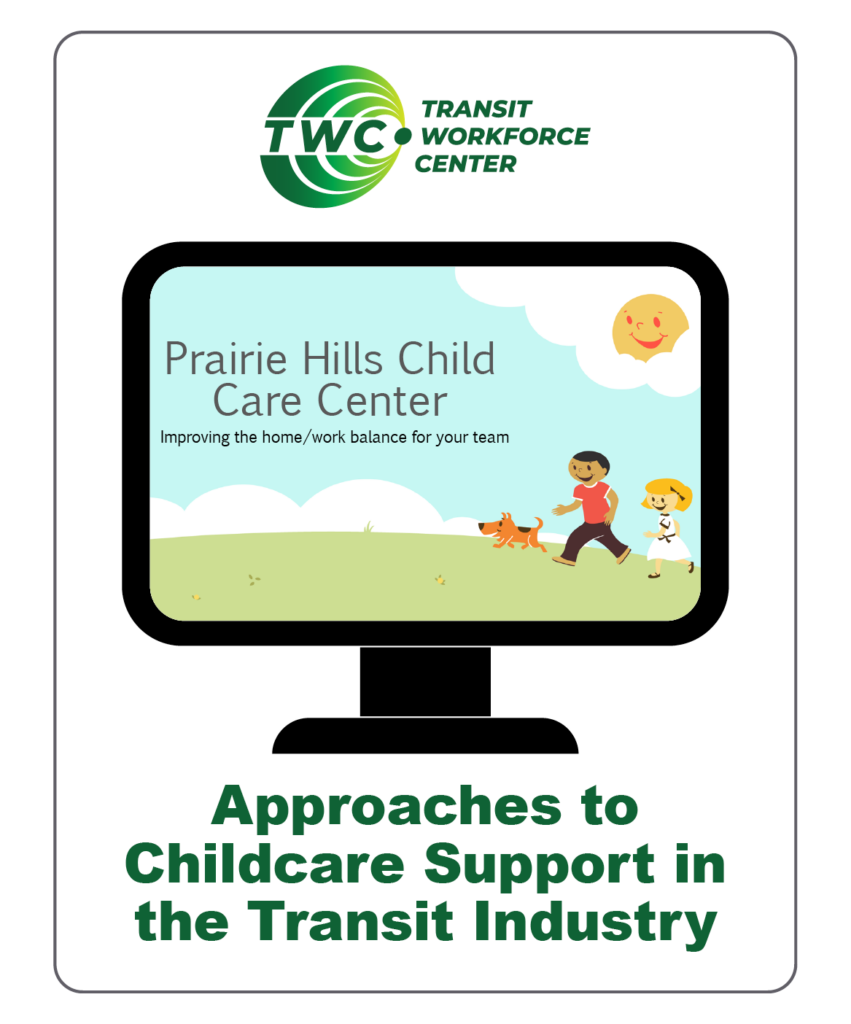
Approaches to Childcare Support in the Transit Industry
Across the nation, the lack of access to affordable and accessible childcare is often a major employment barrier for workers in the transit industry. TWC hosted a pivotal discussion on this issue in the webinar, “Approaches to Childcare Support in the Transit Industry”.
Hear from Barb Cline, Executive Director of Prairie Hills Transit (Spearfish, South Dakota), and Charles Jenkins, Director of the Transport Workers Union Local 100 – New York City Transit Training & Upgrading Fund, who share their approaches to creating childcare solutions tailored for their transit employees. They will delve into the inception of their programs, their ongoing hurdles, and the successes that have marked their journey.
Transit Workforce Center
November 2023
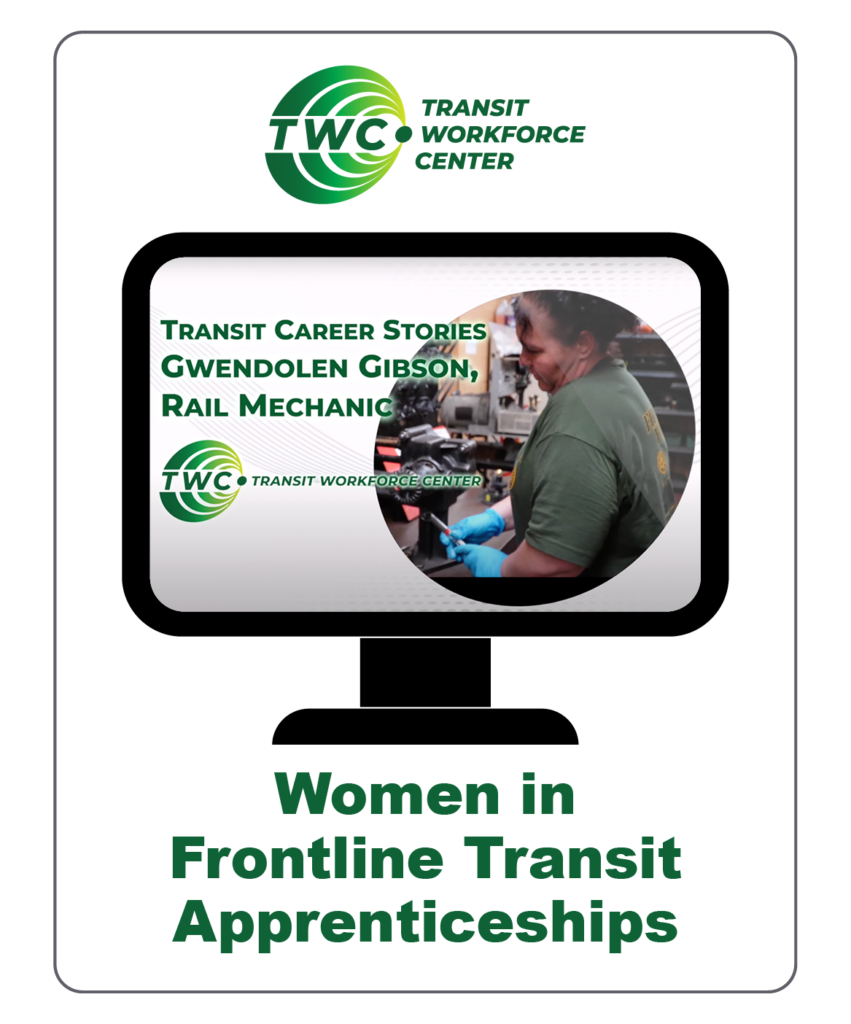
Women in Frontline Transit Apprenticeships
In honor of National Apprenticeship Week, TWC celebrated the tremendous progress made by transit agencies in implementing apprenticeship programs for various transit occupations. Women have long been under-represented in the most high-paying, highly skilled frontline transit occupations. The number of women in registered apprenticeship programs is increasing across industries, and public transit is no exception. Women from public transit agencies across the country have found rewarding careers with family-sustaining wages through apprenticeship.
This event featured a presentation from Liz Weiss, Deputy Director of the Working for America Institute along with a panel of women in registered apprenticeship programs from COTA/TWU Local 208 and MARTA/ATU Local 732.
Transit Workforce Center
November 2023
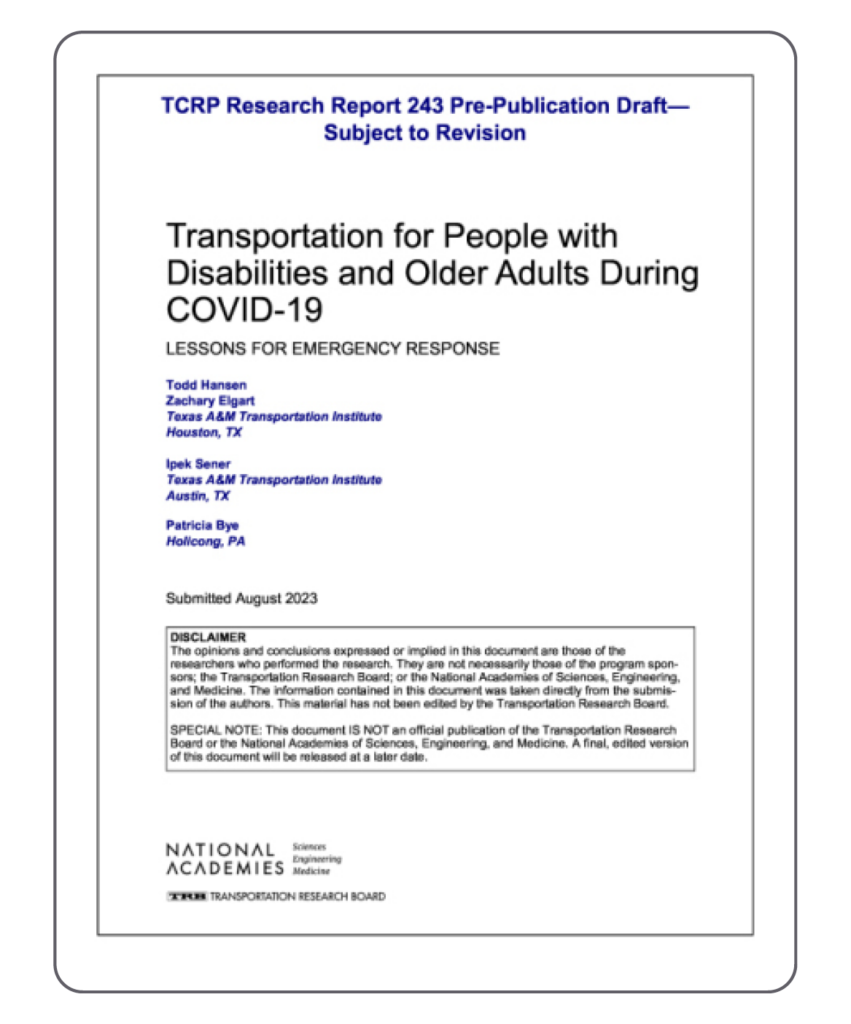
Transportation for People with Disabilities and Older Adults During COVID-19: Lessons for Emergency Response
This pre-publication report aims to provide transportation organizations (including transit agencies, specialized transportation providers, and other local government agencies and stakeholders) with helpful information and strategies on providing service for persons with disabilities and older adults in emergency situations.
Transportation Cooperative Research Program
October 2023
Contributor(s): National Academies of Sciences, Engineering, and Medicine; Transportation Research Board; Transit Cooperative Research Program; Todd Hansen; Zachary Elgart; Ipek Sener; Patricia Bye

Approaches to Childcare Support in the Transit Industry
Transit Workforce Center
September 2023
- There are many ways to support the childcare needs of employees; there is no one-size-fits-all model.
- The models examined in this case study include a voucher system, an on-site center managed directly by the agency, and a discounted center managed by a contractor with supplemental referral services.
- Challenges remain, including childcare affordability and availability.
- Still, these programs can boost morale and attendance among working parents and caregivers.
At New York City’s Metropolitan Transit Authority (MTA), the first sign of a problem was attendance. Los Angeles Metro experienced a similar phenomenon of worker absences, which grew worse during the COVID-19 pandemic. At Prairie Hills Transit in South Dakota, the agency (like many employers in the community) struggled just to get workers in the first place. In community after community, public transit is suffering from low employee availability, and a key driver of the workforce shortage is clear—a lack of affordable childcare.
The good news for the public transit industry is that a variety of models already exist that support the childcare needs of frontline workers. This case study describes three such models: a voucher system, an on-site center managed directly by the agency, and a discounted center managed by a contractor with supplemental referral services. Across the spectrum of agency sizes—from a small rural agency to an agency serving one of the world’s largest cities—transit providers have opportunities to support their workers, both as employees and as parents.
Please see the summary table at the end of the case study for an overview of each of these programs.
Background: The Urgency of Childcare Needs
The United States used to have one of the highest rates of working women among Organization for Economic Cooperation and Development (OECD) countries, but in recent years, the U.S. rate has declined. As parents struggle to find stable access to childcare, they are forced to limit their workforce participation, leave employment altogether, or pay an often-unsustainable portion of their income towards a childcare program. Using data from the National Survey of Children’s Health, the Center for American Progress (CAP) estimated that in 2016 nearly two million Americans made career sacrifices due to issues with childcare.
As the United States, and in particular the transit industry, faces a difficult and ongoing labor shortage, it is important for mothers to be able to participate in the workforce if they choose. Even though women are less present in the labor force, families are becoming increasingly dependent on the maternal income. Only about 30 percent of families with children rely solely on a father’s income; women are primary or equal earners in about two-thirds of families. Women of color with children are even more likely than white women to be in the labor force, be primary breadwinners, and be in low-earning jobs (NWLC).
Despite this necessity, childcare remains a determining obstacle. An analysis of the 2016 Early Childhood Program Participation Survey (ECPP) indicated that half of American families struggle to find adequate childcare, with cost most commonly reported as a barrier. Another CAP analysis found that over half of Americans live in childcare deserts (areas with few or no options for childcare). The maternal workforce participation rate is an average of three percent lower in these deserts than in areas with adequate childcare. Hispanic/Latino families are more likely to reside in childcare deserts and more likely to report location as an obstacle to obtaining childcare. The prevalence of location as an obstacle can be further explored with these interactive childcare desert maps.
Even small steps to alleviate childcare burdens can help parents join the workforce. A study of Washington, DC’s universal, full-day preschool program found that since the program’s inception, the rate of mothers participating in the city’s workforce increased by 12 percent. Subsidies to support parents in finding childcare assistance can have positive impacts on their workforce participation as well. A study of childcare and parent labor force participation found that just a 10 percent decrease in childcare costs could lead to a 0.5-2.5 percent increase in maternal employment. A paper from the National Bureau of Economic Research indicated that if childcare costs were capped at seven percent of income, the rate of low-income mothers in full-time jobs would increase by 18 percent and the overall maternal employment would increase by 10 percent, which would add 12 million mothers to the workforce. For individual families, gender parity, and the overall economy, these increases are important, and they are essential to mitigating the workforce shortage in the transit industry.
Childcare Examples in Public Transportation
Transport Workers Union (TWU) Local 100 – New York City Transit Child Care Fund (CCF)
In New York City, TWU Local 100 and NYC Transit came together to create the Child Care Fund (CCF), a financial assistance program designed to support the families of Local 100 members who need help paying for childcare expenses. In 2002, Local 100 proposed a new benefit for its members in the collective bargaining agreement: funds through CCF to support parents of young children in obtaining childcare. MTA management, concerned about the effects of worker absences on its operations, agreed to the new benefit. “Workers were doing the calculus of whether it’s worth it to spend X amount on childcare versus just staying home and not working and caring for the child instead. Childcare is very expensive,” said Charles Jenkins, Director of TUF. This no-win choice weighed particularly heavy on women. Jenkins recounted how historically, transit has been a predominantly male industry with few accommodations for women, even proper bathrooms, until recently. Long-standing worker shortages in public transit have led the industry to begin thinking differently.
CCF provides financial support to parents for either a year-round childcare program or for summer camps; the employee can choose. The employee also has the discretion to choose who cares for their child—CCF covers about forty percent of the cost of childcare in a licensed facility (up to $320 weekly), and about twenty percent (up to $160 weekly) if the provider is not licensed—for example, if the caregiver is a family member. If the employee chooses the summer camp option, fifty percent is covered (up to $1,000). The benefit is offered to all employees in good standing who have completed one year of employment, until the employee’s child reaches age 12.
The program is not without challenges. It is first-come-first-served, with limited funds, although most people who seek out the benefit do receive it. Some members report they didn’t know about the fund, and even with a subsidy, childcare remains expensive. Still, CCF’s support helps. “Our members are very thankful for the benefit,” Jenkins said, and the agency and union have found that attendance is high when adequate childcare is in place.
Prairie Hills Transit (Spearfish, South Dakota)
Over a thousand miles away and in a much more rural area, the childcare landscape looks different. Prairie Hills, SD, has struggled for years with a lack of childcare providers in the community. Around 2010, Prairie Hills Transit (PHT) Executive Director Barb Cline noticed that federal funds were available for the construction of new buildings. Thinking creatively, she pursued grants and loans from the U.S. Department of Agriculture for the purpose of constructing a childcare facility within the PHT campus. “We knew this was a community problem, bigger than our own staff,” Cline reported. With only about 50 employees, PHT’s staff didn’t have enough children for a center limited to employees, so the agency opened its doors to the wider community.
Today, this licensed, on-site childcare center can accommodate up to 41 children. To handle demand, PHT is expanding to a new rented location which can enroll another 25 or so children. Because childcare has a low profit margin, no external company would take on the contract, so PHT hired its own manager for the program. Now that the building has been constructed, the program sustains itself financially. Employees of PHT receive a thirty percent discount, while other parents in the community pay full price (though some use government benefits to pay and segmented payment plans are available). Children don’t age out formally, but most enrollees are age five or younger. PHT has found that male and female employees alike take advantage of the program. Recognizing that employees won’t be able to transport their children from school to after-school childcare in the middle of a shift, PHT obtained a separate bus with car seats to provide those trips themselves.
PHT reported several challenges it encountered as the program unfolded. Licensing requirements for childcare centers have gotten stricter and PHT has had to invest time to adapt. Another challenge for the agency has been the “human versus the financial”: if a parent only wants part-time childcare, the center wants to accommodate the family’s needs, but the accommodation results in the loss of a full-time spot and thus a loss of funds. Availability of childcare remains a challenge because demand is so high, even though PHT employees receive some degree of priority; “our waiting list is 12 pages long,” Cline said. Even with a subsidy, affordability is still a question for some families. However, employee turnover is low at PHT and childcare may be part of the reason.
PHT has realized that because of the geographic dispersion of employees and the low turnover of children in the center, some employees are not able to take advantage of the center’s offerings. As the program looks to the future, PHT is looking to build a second shared-use facility to expand capacity.
LA Metro (Los Angeles, CA)
Like so many other transit agencies, Los Angeles Metro found its workforce depleted as the COVID-19 pandemic progressed. The agency recognized that a lack of childcare delayed re-entry into the workforce.
LA Metro offers three options for their employees to find support The first is, through a memorandum of understanding, a partnership with Pathways LA to provide referral services to LA Metro employees seeking childcare. Pathways LA gives parents digestible information about childcare options and assistance navigating the possibilities available. LA Metro also utilizes its employee assistance program through ComPsych Corporation Guidance Resources, which connects employees to a Work-Life Specialist. This specialist provides personalized resources custom to the needs of the individual employees seeking childcare in their area. The third support is more recently established: LA Metro has leased a space it owns, beginning June 2023, to Pathways LA for a childcare center within walking distance from Metro’s central maintenance facility and headquarters. This arrangement was established through a competitive bid process. The center is not exclusive to LA Metro employees, but employees receive a 15% discount and get priority enrollment. The center serves children up to age 5 and offers everything from an infant center to an educational curriculum for older children to special needs programming. LA Metro has hired a coordinator to oversee the relationship between Pathways LA and Metro, which has been indispensable to facilitating a smooth partnership, the agency reported.
As childcare needs have evolved, LA Metro has persevered in seeking the best options for its employees within available resources. Before the Pathways LA partnership, LA Metro had partnered with a different third-party provider; with the new partnership, largely because of inflation, prices have risen and employees that transferred from one provider to the other were impacted by the change. Prices were already steep and employees felt the increase keenly. Another challenge has been the limitations of a single facility location: the fact that the center is close to LA Metro’s headquarters and central maintenance garage reduces travel and logistics for some parents, but not all Metro employees report to those locations. For LA Metro, a multi-pronged approach has been most successful.
Conclusion
Finding adequate childcare services is an imperative step in entering or re-entering the workforce, but it’s not easy for every parent. In the face of a widespread workforce shortage, if transit agencies are able to help parents with this step, it can help rebuild and maintain their workforce. These examples provide evidence that agencies of varied sizes across the county can find a childcare supportive service program that works for them. LA Metro found that neither subsidies nor self-administration of a childcare center was realistic for them, but partnerships with an established and trusted provider could further their employees’ access to childcare resources. On the other hand, Prairie Hills Transit, facing a childcare desert in their community, established their own center. Meanwhile, MTA and TWU Local found that cost, not availability, was the primary limiting factor for their employees, and they were able to address that challenge for many families. Other transit agencies can take similar steps, utilize their own unique resources, and learn from the challenges faced in these examples to facilitate access to childcare services for their employees, which in turn will contribute to a stronger and more reliable workforce.
Summary of MTA/TWU Local 100, Prairie Hills Transit, and LA Metro Childcare Programs
For more information on these programs, contact:
- Barb Cline, Prairie Hills Transit: bkcline@prairiehillstransit.com
- Jodi Stewart, LA Metro: stewartj@metro.net
- Shayna Gleason, TWC: sgleason@transportcenter.org
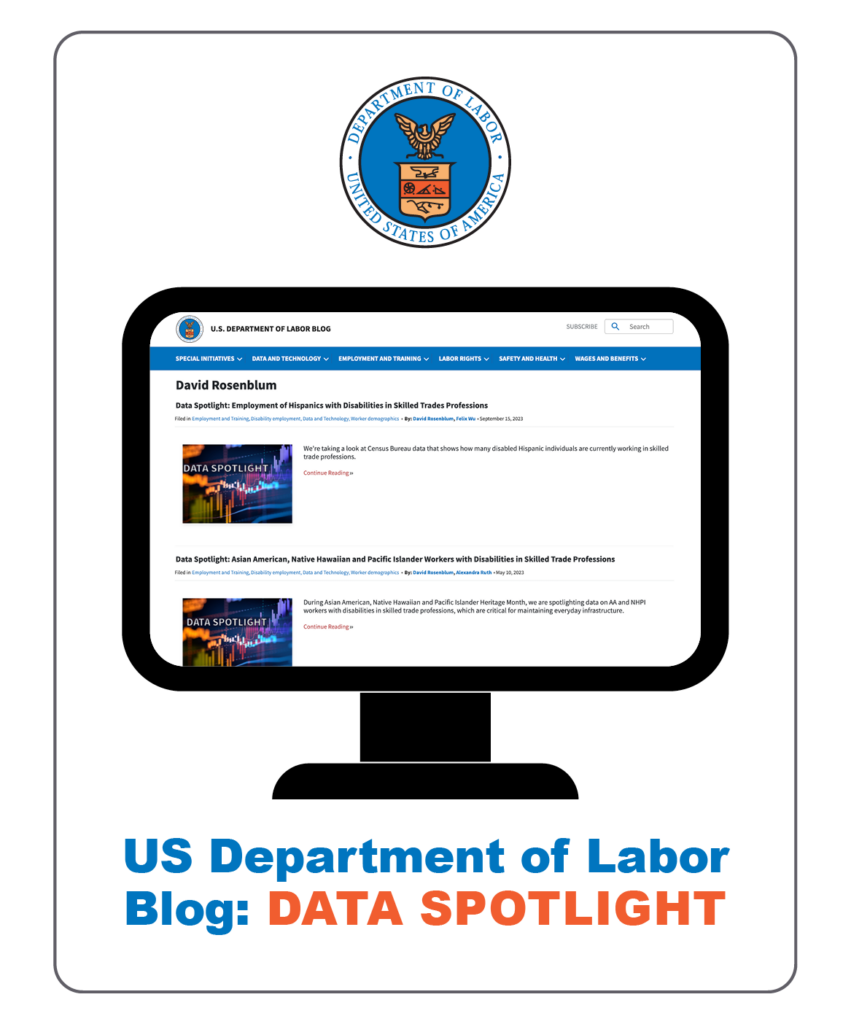
US Department of Labor Blog: Data Spotlight
This page on the US Department of Labor Blog features data spotlight articles by David Rosenblum which provide visualizations of Census Bureau data about different demographics in skilled trade professions.
US Department of Labor
September 2023
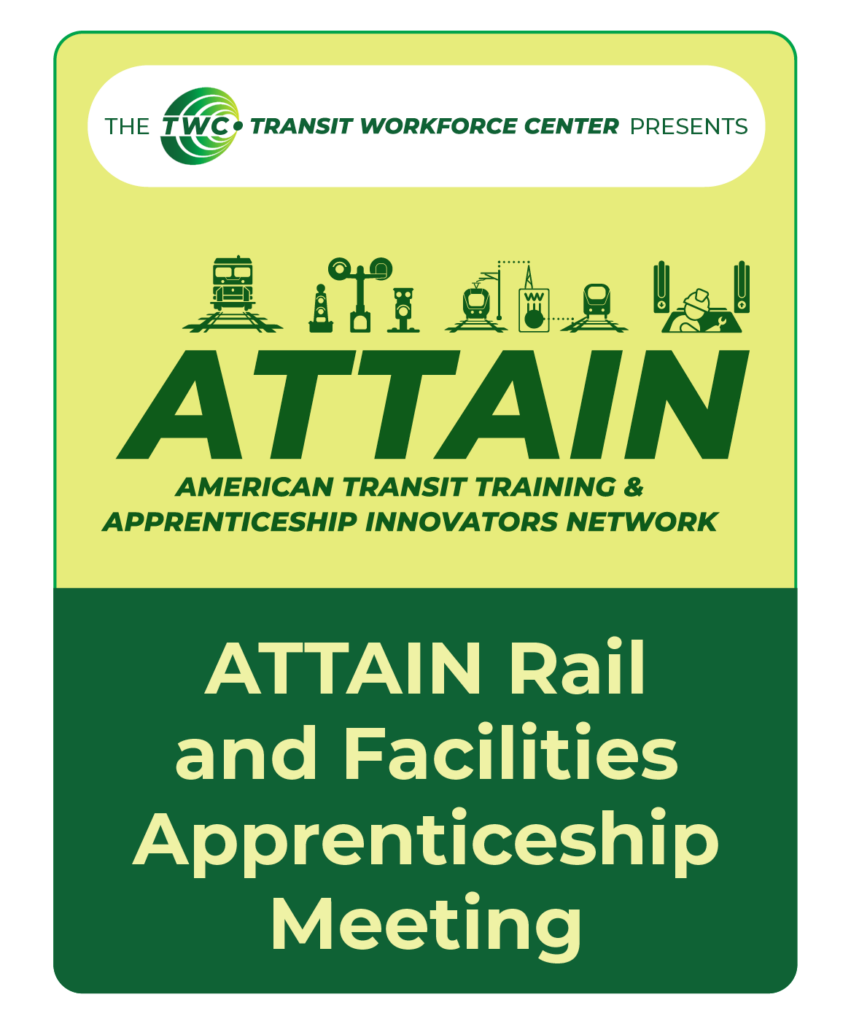
ATTAIN Rail and Facilities Apprenticeship Meeting
This recorded meeting of the ATTAIN Rail and Facilities Committee serves as a resource for transit industry stakeholders and includes presentations on apprenticeship and case studies of successful programs across the country.
Transit Workforce Center
September 2023
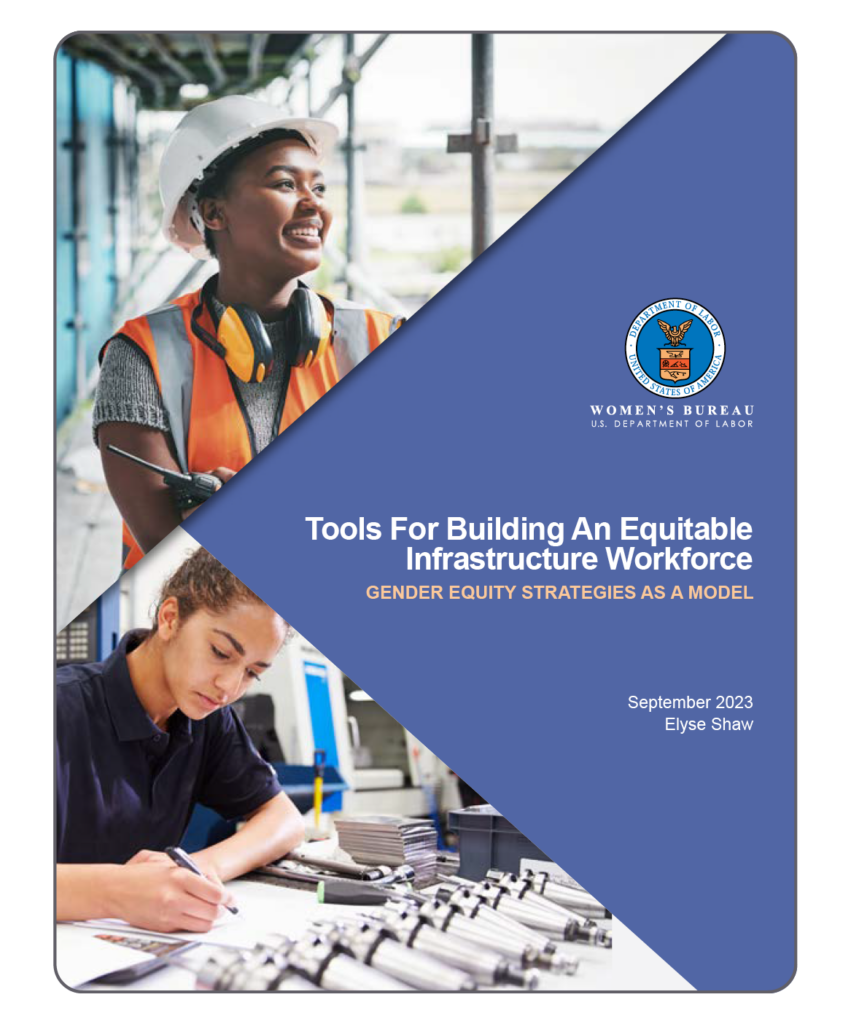
Tools for Building an Equitable Infrastructure Workforce
Department of Labor
September 2023
This toolkit provides guidance on strategies and best practices for recruiting and retaining women in construction, manufacturing, and clean energy jobs. The strategies describe how to make the intentional choice to build a diverse workforce, create targeted recruitment, address barriers of entry, and retain a diverse workforce.
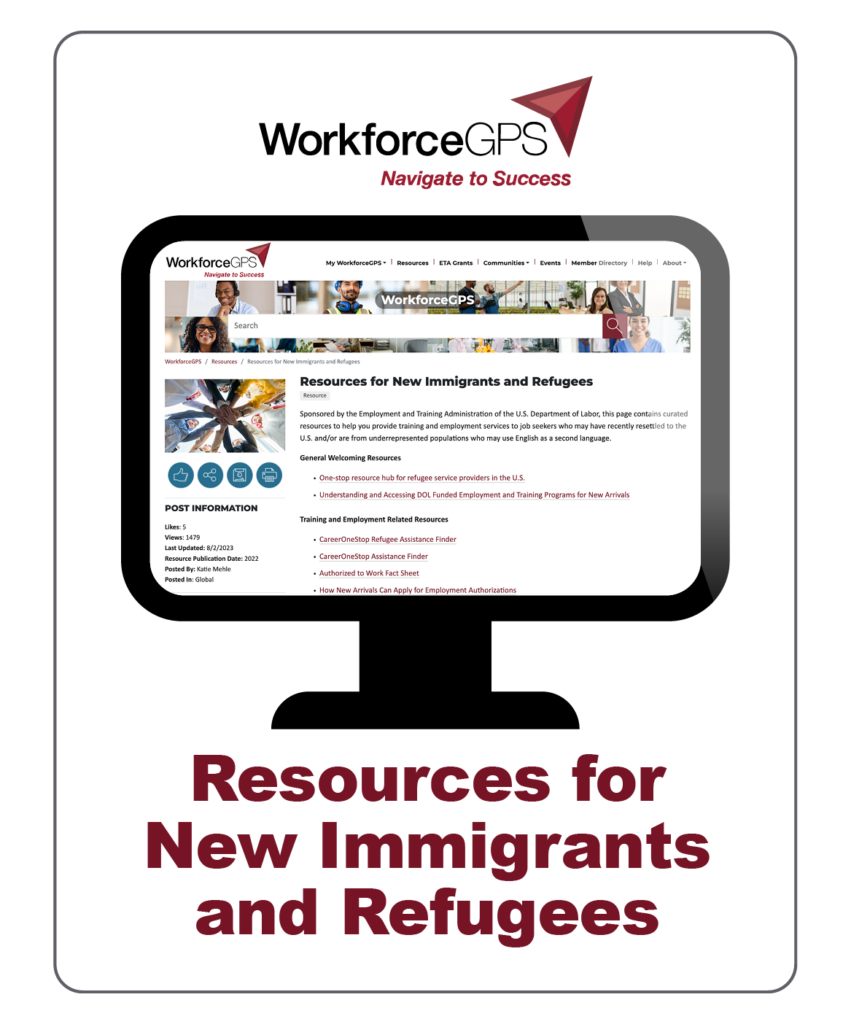
Resources for New Immigrants and Refugees
This WorkforceGPS page provides a variety of employment resources for new immigrants and refugees, including factsheets in different languages, information about funding and training programs, and other special services.
WorkforceGPS
August 2023
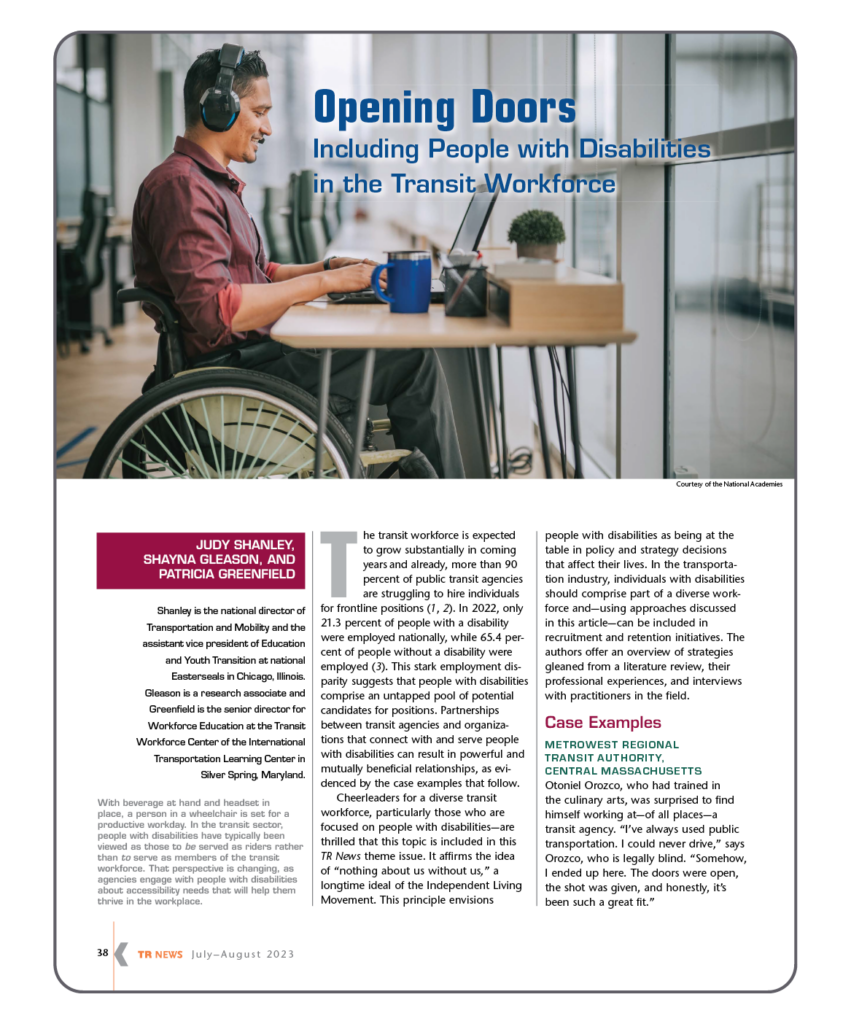
Opening Doors: Including People with Disabilities in the Transit Workforce
TR News
August 2023
In the transportation industry, individuals with disabilities should comprise part of a diverse workforce and can be included in recruitment and retention initiatives. “Opening Doors: Including People with Disabilities in the Transit Workforce” offers an overview of strategies and is one of the feature articles in the July-August 2023 edition (Issue 346) of TR News, TRB’s magazine.
Authors: Judy Shanley (National Center for Mobility Management), Shayna Gleason (Transit Workforce Center), and Patricia Greenfield (Transit Workforce Center)
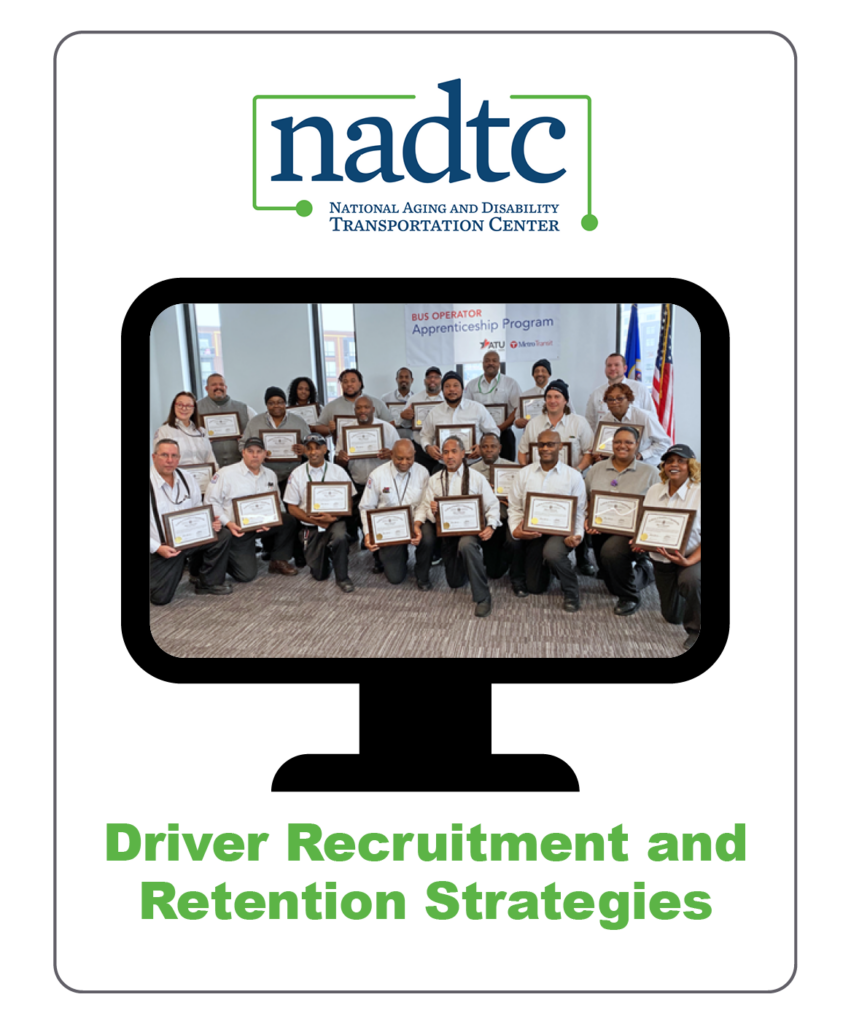
Driver Recruitment and Retention Strategies
This blog post from the National Aging and Disability Transportation Center discusses recruitment and retention strategies for transit agencies, particularly in regard to older and disabled workers in the face of industry-wide labor shortages. It includes examples of successful partnerships and effective mentoring programs.
National Aging and Disability Transportation Center
July 2023
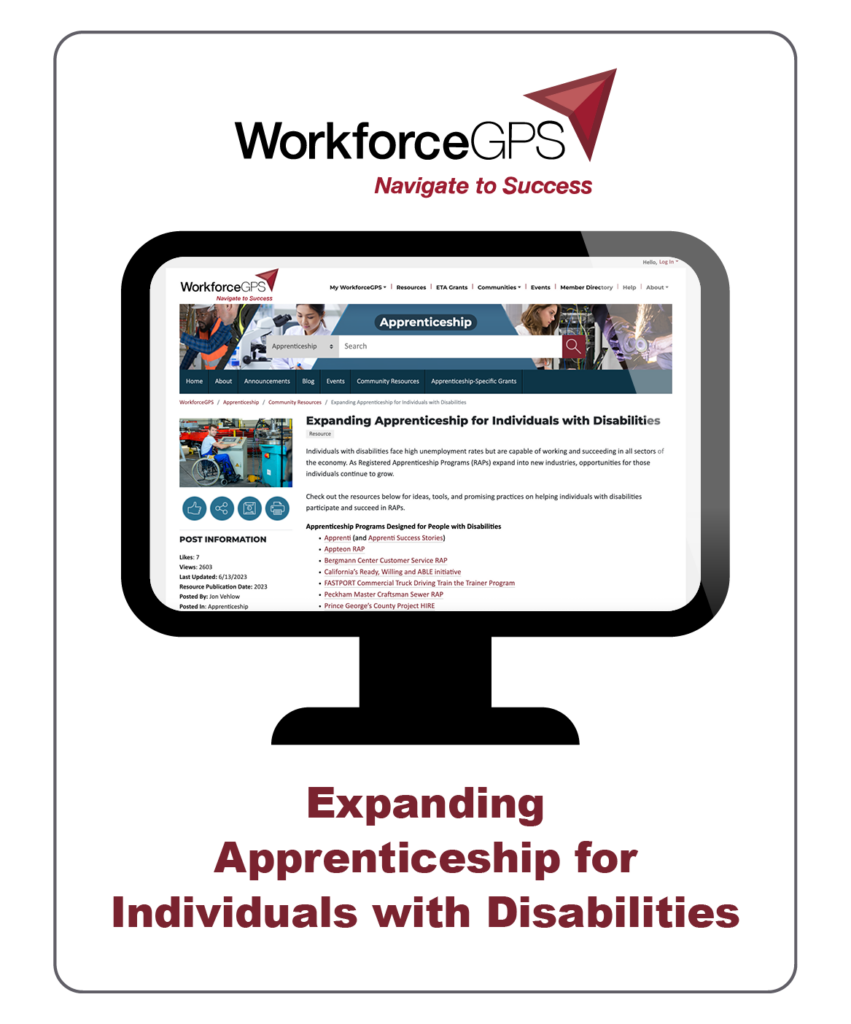
Expanding Apprenticeship for Individuals with Disabilities
This landing page features a variety of resources aimed at providing information, ideas, tools, and practices for supporting individuals with disabilities in apprenticeship programs. The resources include specific programs, toolkits and guides, outreach and background materials, and research.
WorkforceGPS
June 2023
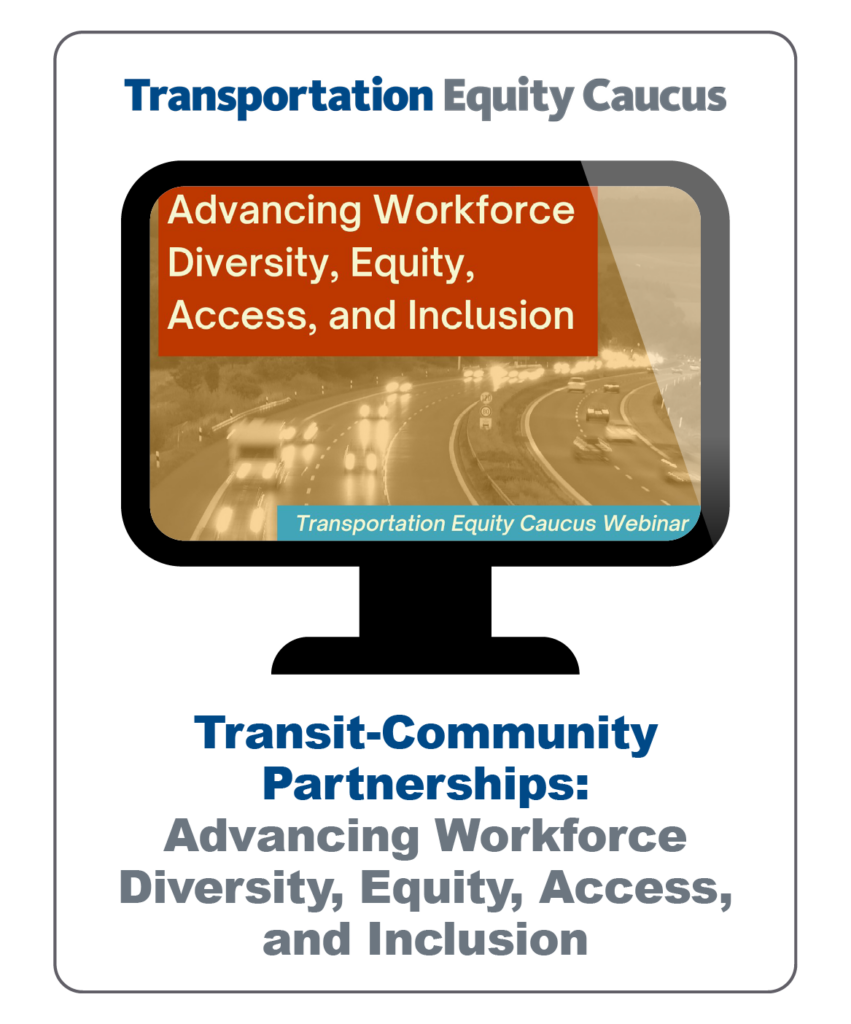
Transit-Community Partnerships: Advancing Workforce Diversity, Equity, Access, and Inclusion
In this webinar, hosted by the Transportation Equity Caucus and Transit Workforce Center, panelists with experience in community-based partnerships that embrace diversity, equity, inclusion, and access discuss a variety of ways community-based organizations, transit agencies, and unions can engage in creating a strong workforce that fully reflects their communities.
Transportation Equity Caucus
June 2023
Featured Speakers:
- Beth Berendsen, Policy Director, Chicago Women in Trades
- Rich Diaz, Bus Operator Mentor Lead, Amalgamated Transit Union Local 1575
- Aaron Koski, Senior Manager – Workforce Development, Metro Transit (MN)
- Anna Penland, Assistant Transportation Manager – OECC Coordinator, Metro Transit (MN)
- David Stephen, International Transportation Learning Center/Transit Workforce Center
- Chris VanEyken, Director, Research and Policy, TransitCenter

Notice of Funding Opportunity: DOL Building Pathways to Infrastructure Jobs Grant Program
Administering Agency: US Department of Labor
Posted Date: May 15, 2024
Closing Date for Applications: July 1, 2024, 11:59 pm Eastern Time
Funding Range: Estimated Total Program Funding: $35,000,000 — Award Ceiling: $5,000,000 — Award Floor: $500,000
Geographic Scope: National
Description: The purpose of the DOL Building Pathways to Infrastructure Jobs Grant Program is to fund public-private partnerships to develop, strengthen, and scale promising and evidence-based training models in H-1B industries and occupations critical to meeting the goals of the Bipartisan Infrastructure Law (BIL) and to maximize the impact of these investments.
Updated June 6, 2024 on TWC Resource Center. Please refer to the link below for the most up to date information from the funder.
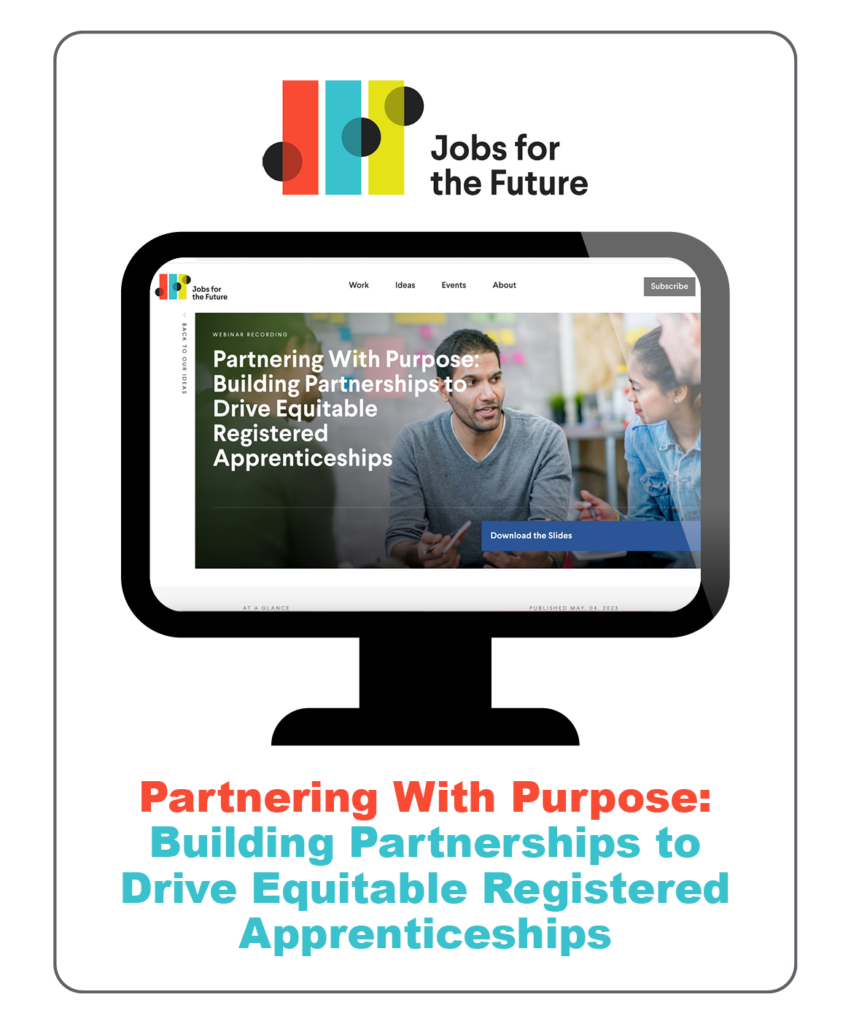
Partnering With Purpose: Building Partnerships to Drive Equitable Registered Apprenticeships
This webinar recording features successful partnership stakeholders discussing how to create and maintain partnerships to support equitable and effective registered apprenticeships. Leaders of apprenticeship partnerships discuss the steps they took to build strong relationships with fellow stakeholders and the factors that make their partnerships succeed.
Jobs for the Future
May 2023
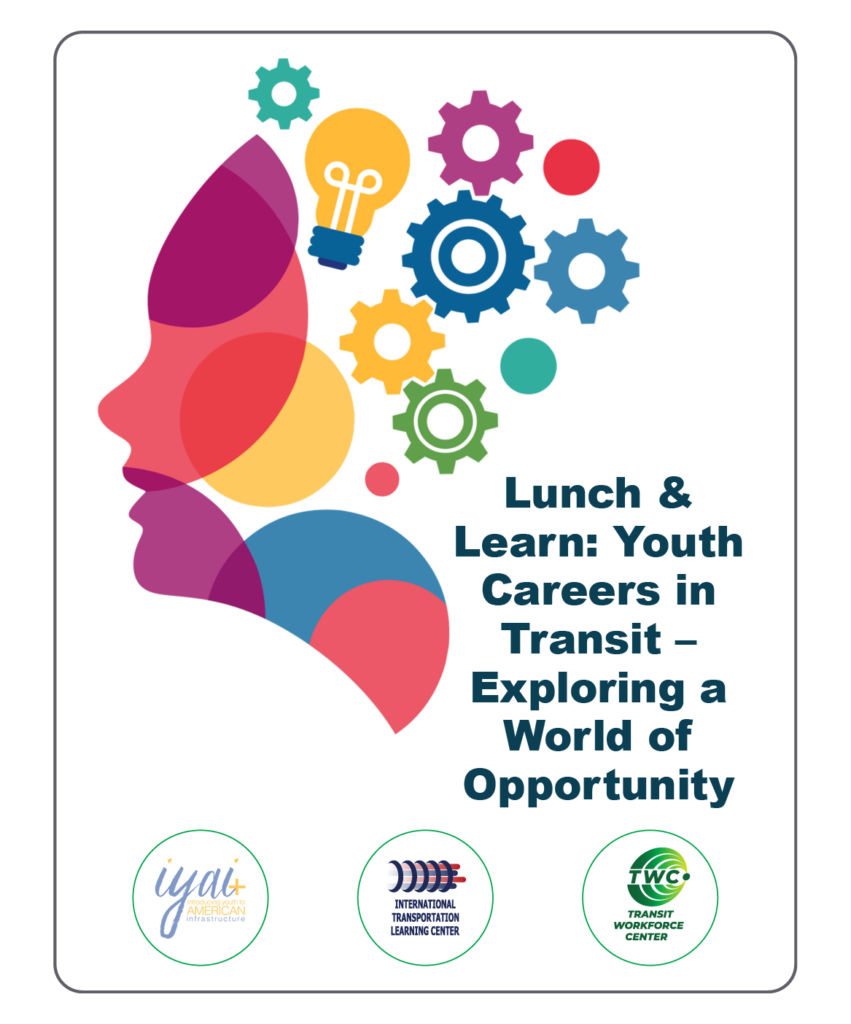
Lunch & Learn: Youth Careers in Transit – Exploring a World of Opportunity
This is Part 4 of Iyai’s 6-part 2023 Transportation/Mobility Career Awareness Lunch and Learn series. This webinar is co-sponsored with the International Transportation Learning Center / Transit Workforce Center. This webinar features presenters at various stages of their transit careers discussing their work and their own career pathways, engaging in an interactive discussion with the audience.
Iyai+; International Transportation Learning Center/Transit Workforce Center
May 2023
Program: Iyai’s Dr. Beverly Scott and TWC’s Shayna Gleason present an overview of the program series and career landscape, followed by participants in diverse positions talking about their work and careers. Speakers include:
- Marvin Alfred, President, Amalgamated Transit Union (ATU) Local 113 (Toronto);
- Kyisha Bond, mechanic apprentice, IndyGo (Indianapolis),
- Inez Evans, President and CEO, IndyGo (Indianapolis);
- Andrew Falotico, Health and Safety Representative, ATU Local 113 (Toronto);
- Desiree Patrice, Deputy Chief of Capital Transformation, MBTA (Boston).
After the presentations, Karen Philbrick from the Mineta Transportation Institute facilitates a conversation between the audience and presenters.
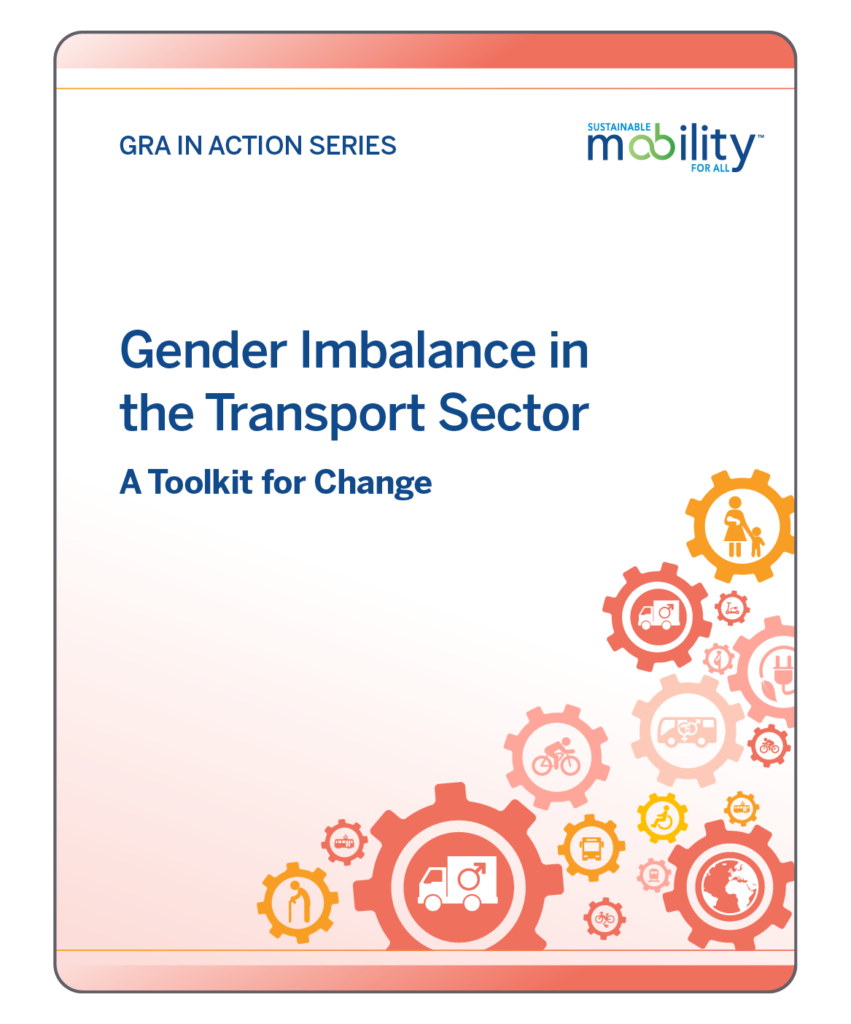
Gender Imbalance in the Transport Sector: A Toolkit for Change
This study builds upon findings from the SuM4All Global Roadmap for Action, which called for the transport sector to address key barriers inhibiting women from accessing decent work in the industry. It delivers a clear overview of the existing employment landscape in transport and recommends and guides positive action for practitioners across the sector. Informed by desk-based research, surveys, interviews, and case studies, the study examines the primary challenges for women entering, remaining in, and progressing in the transport sector worldwide, before presenting a toolkit, which lays out key recommendations for action.
Sustainable Mobility for All
May 2023
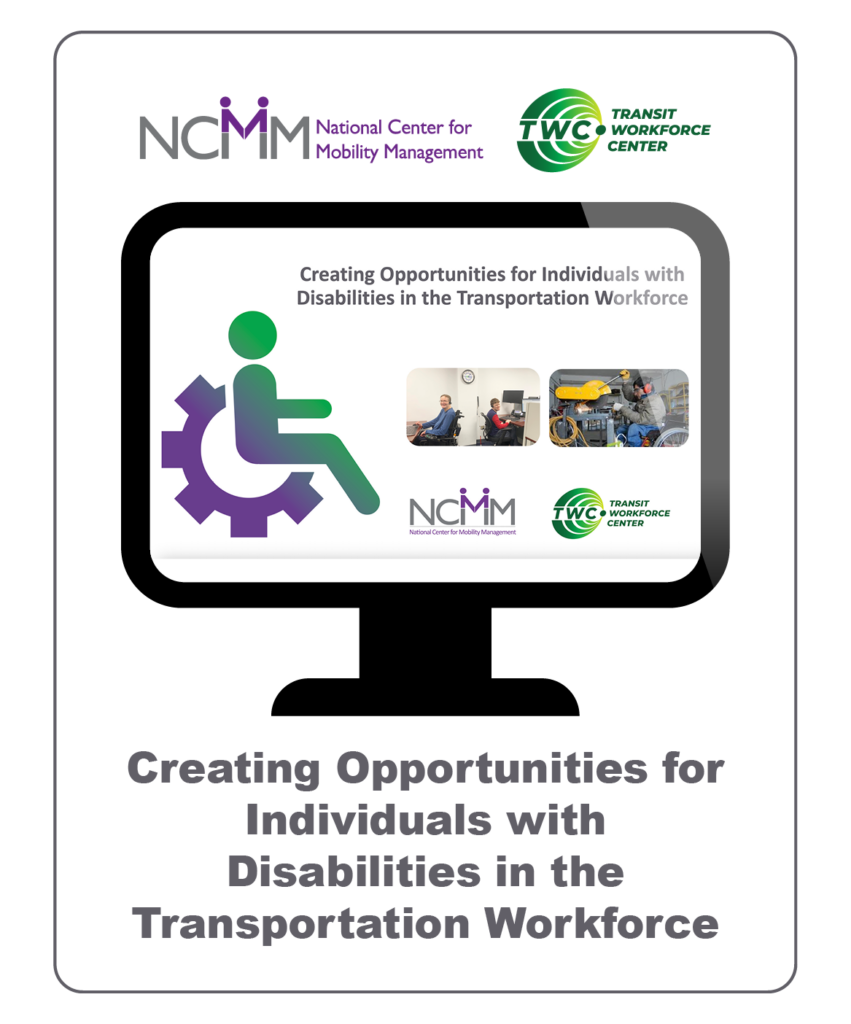
Creating Opportunities for Individuals with Disabilities in the Transportation Workforce
When transportation professionals are equipped with knowledge and skills about disability topics, they can help create welcoming and engaging employment settings for individuals with disabilities. This new NCMM/TWC learning module offers hiring professionals strategies to recruit and retain individuals with disabilities in the transportation workforce. Learn about partnerships, inclusive hiring, and accommodations to attract and retain employees with disabilities.
National Center for Mobility Management; Transit Workforce Center
May 2023
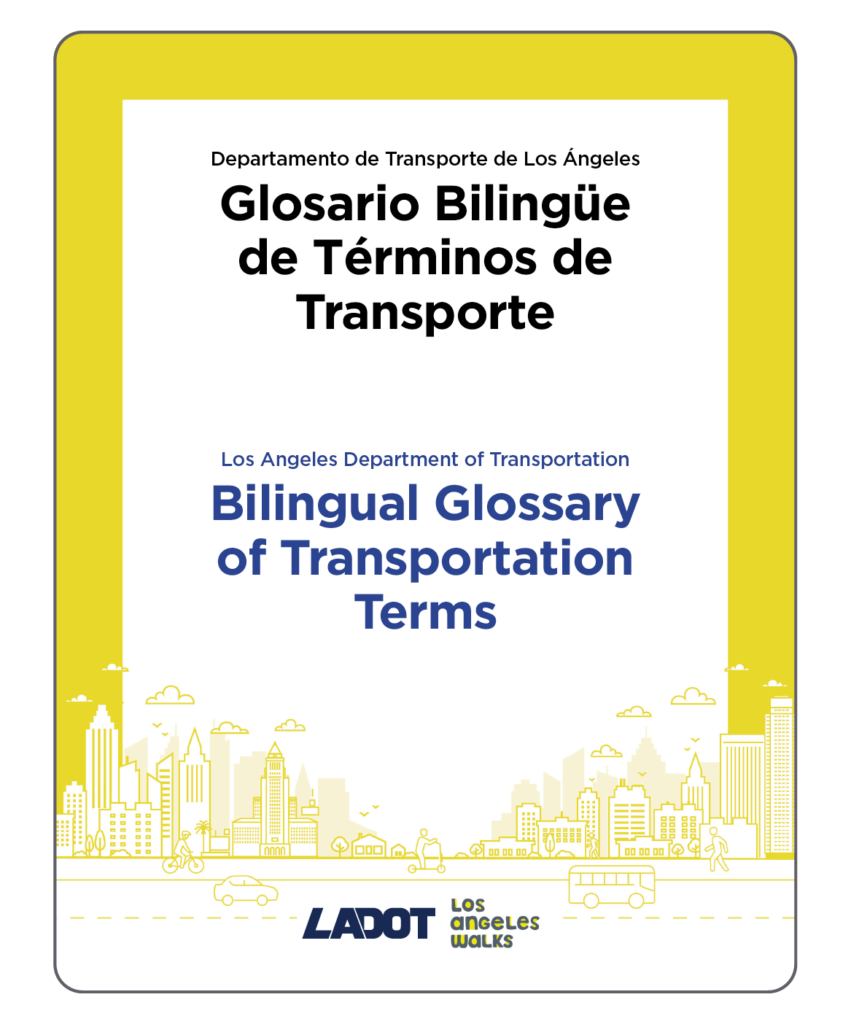
LADOT Bilingual Glossary of Transportation Terms
Los Angeles Department of Transportation
May 2023
In 2020-2022, LADOT collaborated with LA Walks, community members, transportation and planning practitioners, advocates and others to develop LADOT’s first Spanish glossary. The project includes over 100 transportation planning and community engagement terms to improve and standardize LADOT’s Spanish language communication, as well as empower Spanish speaking communities to advocate for transportation improvements.
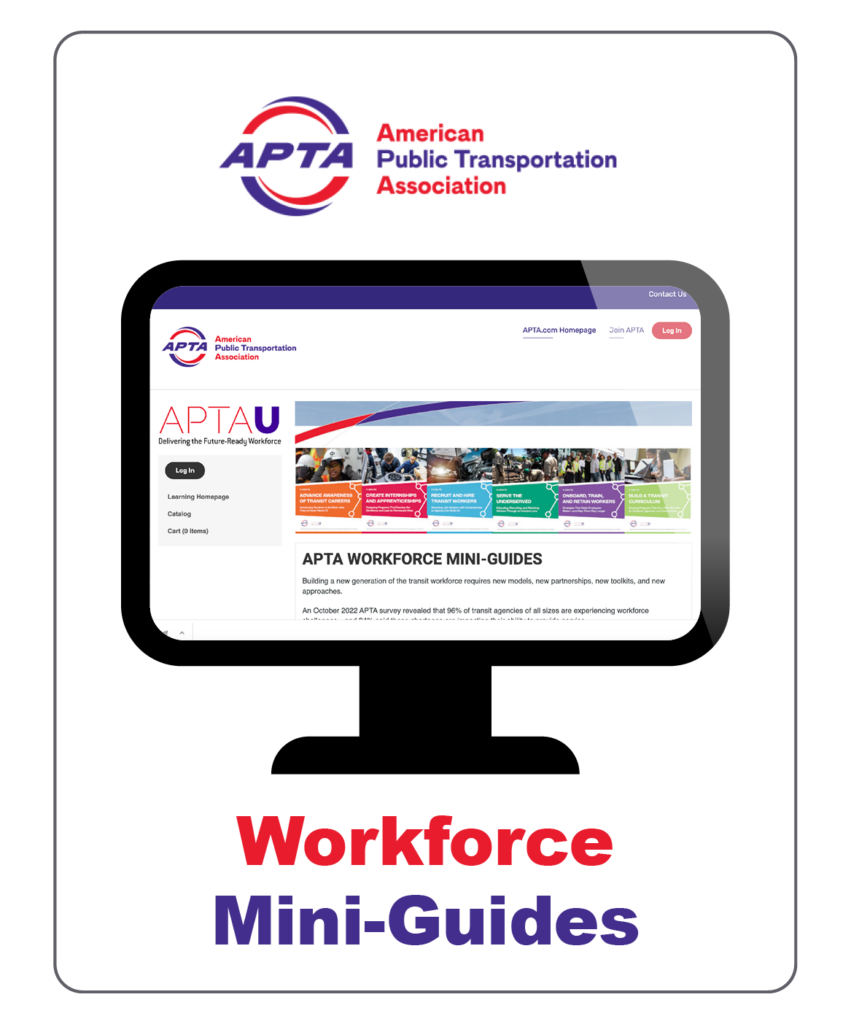
Workforce Mini-Guides
These six workforce development mini-guides are designed to help develop and implement successful strategies to address the critical workforce shortages seen across the public transportation industry. They cover these topics: advancing awareness of transit careers; creating internships and apprenticeships; recruiting and hiring transit workers; serving the underserved in the workforce; onboarding, training, and retaining workers; and building a transit curriculum.
American Public Transportation Association
April 2023
An October 2022 survey conducted by APTA revealed that 96 percent of transit agencies of all sizes are experiencing workforce challenges, and 84 percent said these shortages are impacting their ability to provide service. APTA developed these mini-guides building on their 2021 Transit Workforce Readiness Guide and combining industry insights and stories, case studies, lessons learned, and best practices.
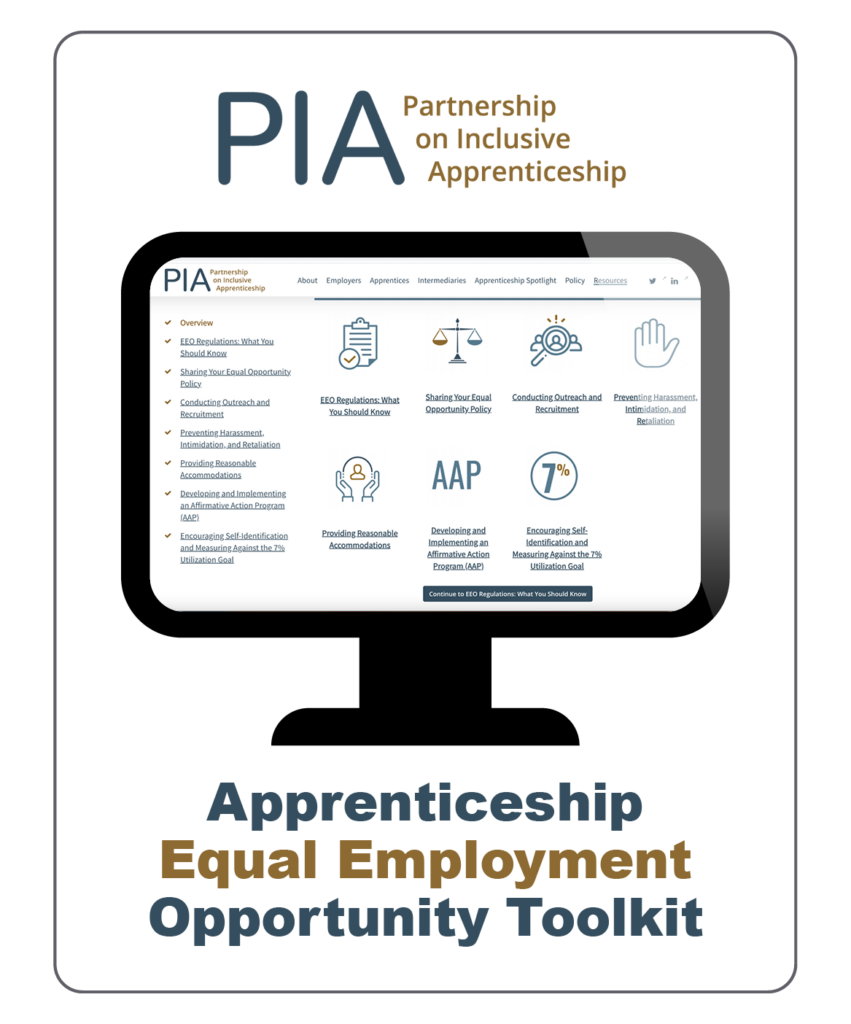
Apprenticeship Equal Employment Opportunity Toolkit
This toolkit provides advice on how to reach the Department of Labor utilization goal for sponsors of Registered Apprenticeship Programs to have individuals with disabilities make up at least 7% of people enrolled. It includes information about outreach and recruitment; preventing harassment, intimidation, and retaliation; providing reasonable accommodations; developing and implementing an affirmative action program, and encouraging self-identification.
Partnership on Inclusive Apprenticeship
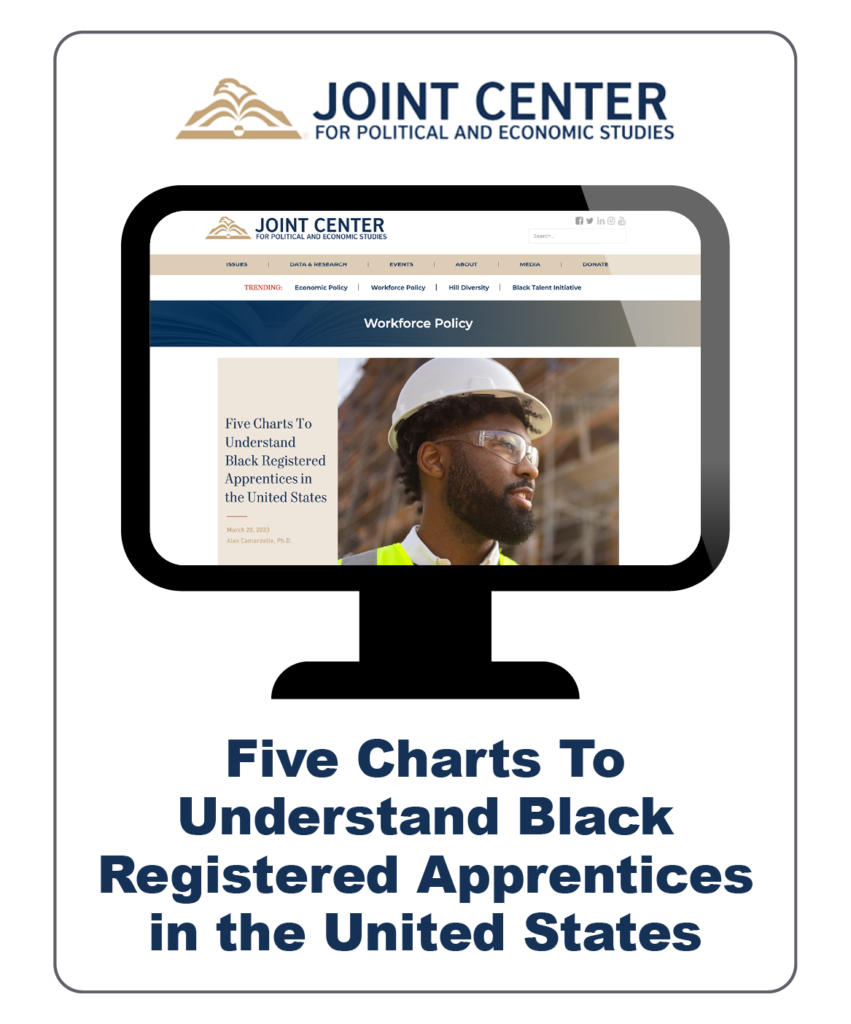
Five Charts To Understand Black Registered Apprentices in the United States
Joint Center for Political and Economic Studies
March 2023
The Joint Center’s issue brief, Five Charts To Understand Black Registered Apprentices in the United States, analyzes data reported in the Registered Apprenticeship Partners Information Database System (RAPIDS) from the U.S. Department of Labor to highlight structural barriers that Black apprentices face. To achieve racially equitable outcomes in apprenticeship programs, policymakers and apprenticeship coordinators must understand these challenges.
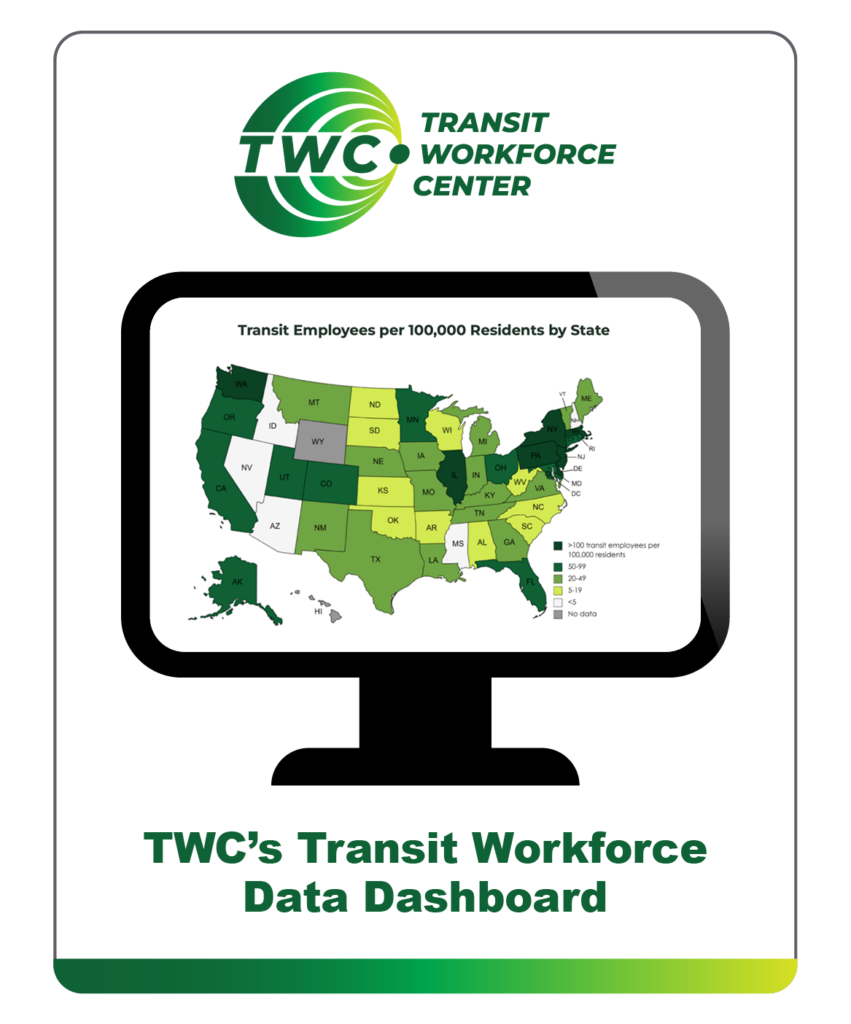
TWC’s Transit Workforce Data Dashboard
Launched in March, 2023, the Transit Workforce Data Dashboard presents quantitative, descriptive data about the composition of the transit workforce and trends in transit employment using a series of charts and graphics. This information is relevant for industry discussions in a range of contexts, including: strategic workforce planning in recruitment, retention, and other areas; examining and addressing opportunities and challenges related to diversity, equity, inclusion, and access; and identifying training and funding needs.
Transit Workforce Center
March 2023
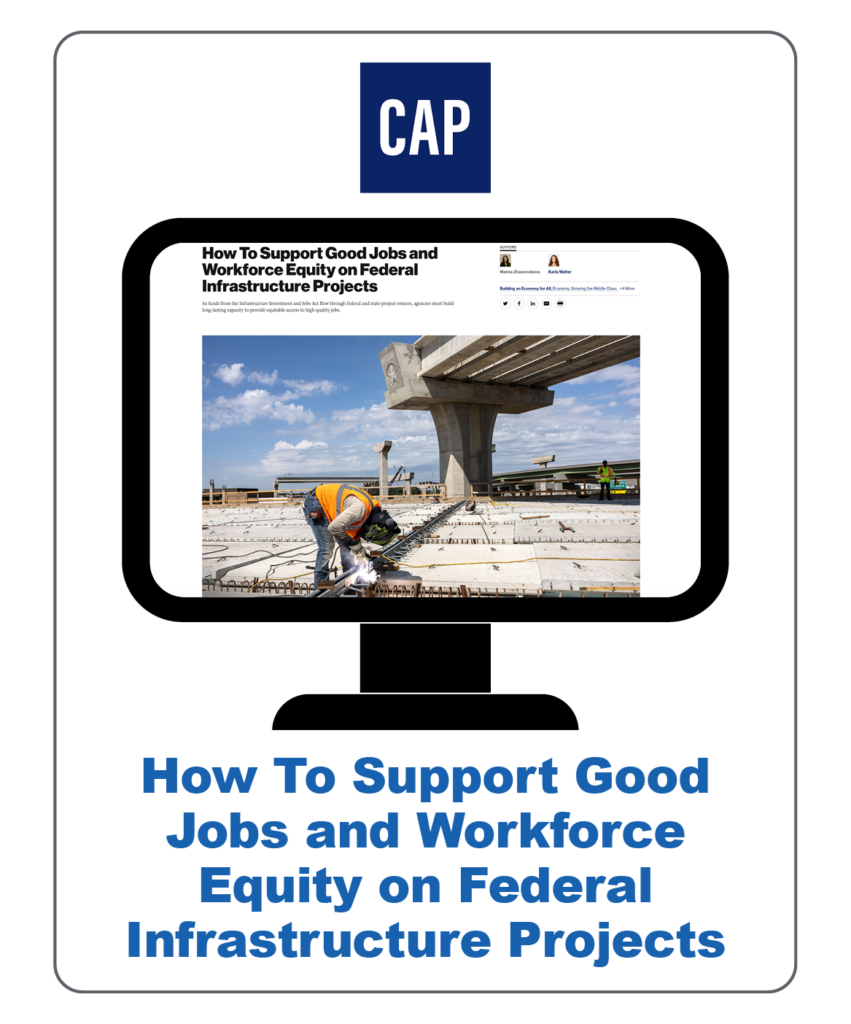
How To Support Good Jobs and Workforce Equity on Federal Infrastructure Projects
Center for American Progress
March 2023
This report from CAP describes strategies to ensure that the Infrastructure Investment and Jobs Act (IIJA) spending meets workforce equity and quality goals:
- Include clear, robust workforce standards in procurement communication and evaluation.
- Build agency capacity to collaborate and prioritize workforce standards.
- Provide technical assistance to achieve desired policy results.
- Measure and report workforce outputs and outcomes.
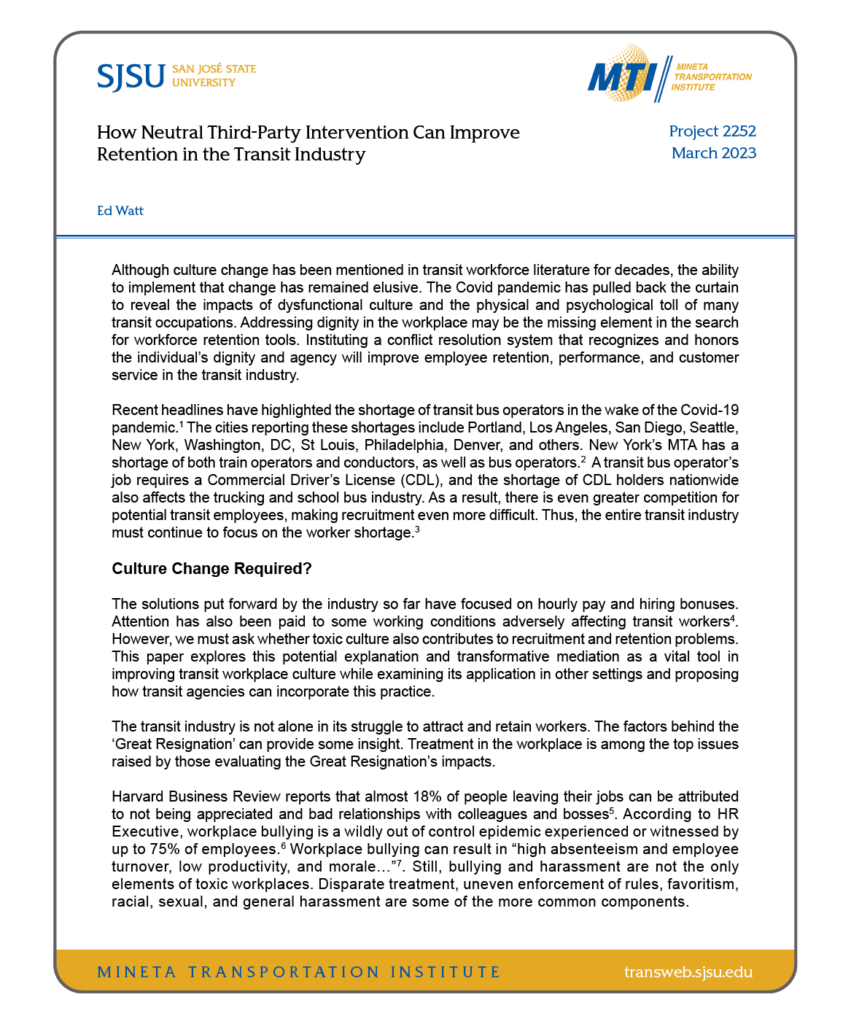
How Neutral Third-Party Intervention Can Improve Retention in the Transit Industry
This study proposes methods that follow transformative mediation in order to improve hiring and retention at transit agencies and other companies by providing an organizational culture that respects each person’s dignity, identity, and opinions.
Mineta Transportation Institute
March 2023
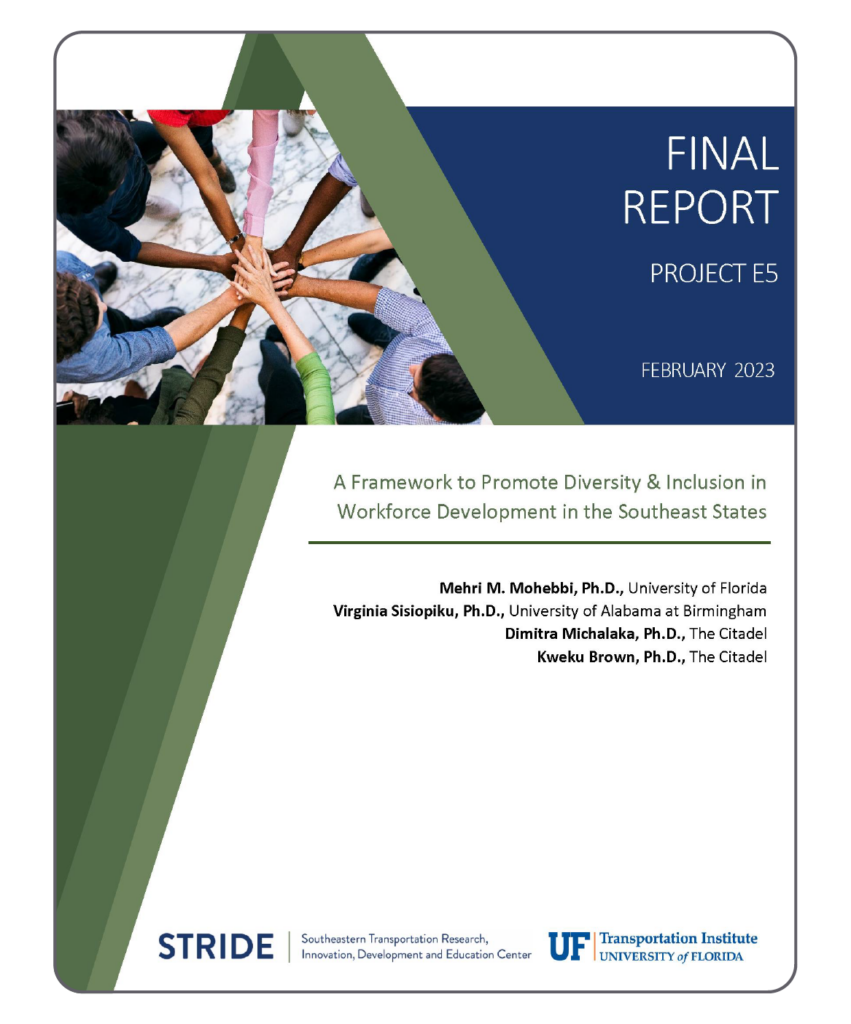
A Framework to Promote Diversity and Inclusion in Workforce Development in the Southeast States
This project developed a framework for creating an inclusive and functional workforce environment for transportation agencies in the southeast region. The project identifies existing gaps, predicts future needs, and captures the role transportation agencies, research centers, DOTs, and professional organizations can play to recruit, train, and maintain a diverse and inclusive workforce.
Southeastern Transportation Research, Innovation, Development and Education Center
February 2023
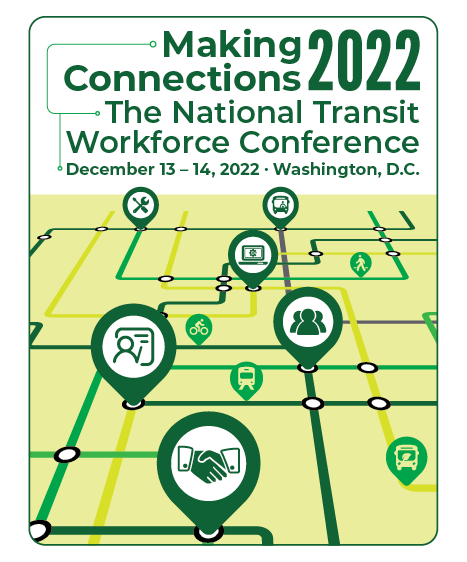
Making Connections 2022 – Conference Overview and Videos
The Transit Workforce Center hosted Making Connections 2022: The National Transit Workforce Conference in Washington, D.C. on December 13-14, 2022. This conference brought together participants from urban, suburban, rural, and tribal public transportation and industry stakeholders in plenaries, workshops, networking, and ongoing dialogue. Discussions and sessions featured topics including recruitment and retention, training, mentoring and apprenticeships, new technologies, preparing today’s and tomorrow’s workforce, and advancing diversity, equity, inclusion, and access.
Transit Workforce Center
December 2022
TOPICS: Apprenticeship , Career Pathways , Diversity, Equity, Inclusion, and Access , Hiring and Recruitment , Labor-Management Partnerships , Making Connections Conference , Mentorship , Program Evaluation and ROI , Retention , Safety and Health , Trainer and Mentor Development , Training , Zero Emission Buses
Session materials from Making Connections 2022 are hosted on the TWC Resource Center. Please click here to view all related materials. A PDF copy of the conference schedule is linked below.
Opening Video:
Recap Video:
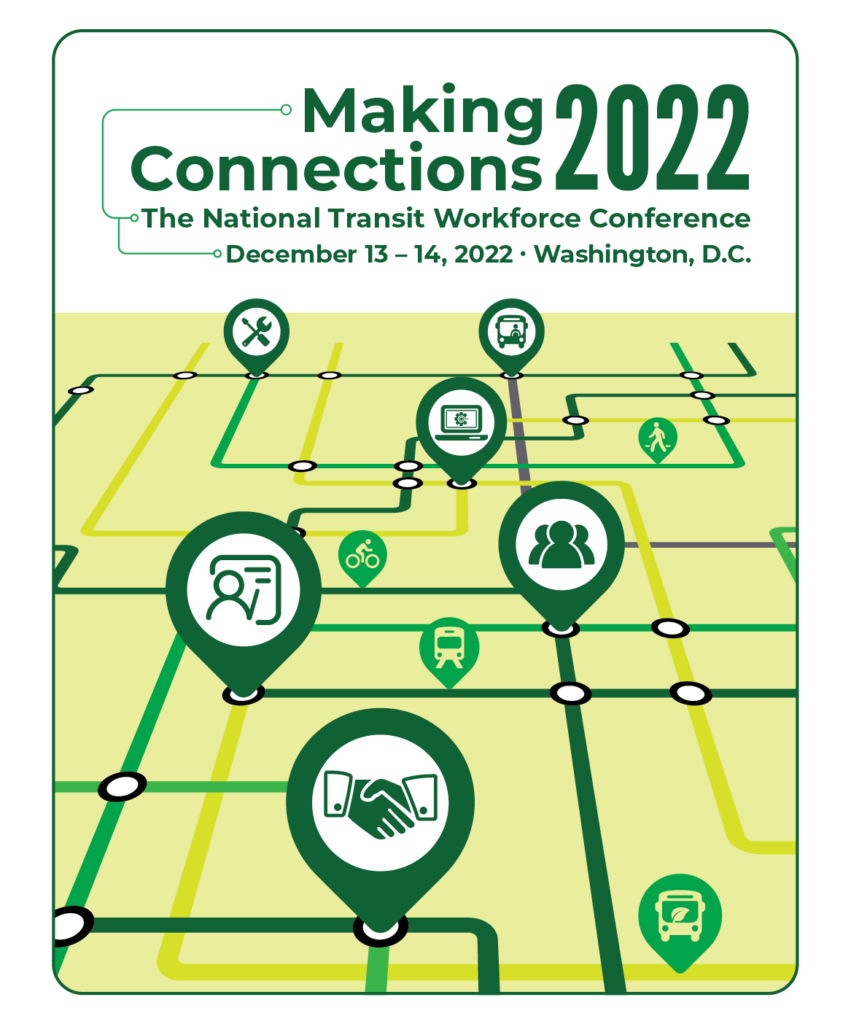
Making Connections 2022 – Out of the Box Strategies: Using Partnerships to Strengthen Recruitment, Retention and the Advancement of Diversity, Equity, Inclusion and Access
This session about DEIA advancement was presented as part of TWC’s Making Connections 2022 transit workforce conference in December, 2022.
Transit Workforce Center
December 2022
Session Summary: This session featured cutting-edge partnership strategies that advance diversity, equity, inclusion, and access while strengthening recruitment and retention. Representatives from transit labor and management, education, and national and local transit supporters and stakeholders provided a range of perspectives, while discussing innovative programs and initiatives along with their positive outcomes.
Moderator
- Jess Guerra: Executive Director, Transportation Workforce Institute – Los Angeles Trade Technical College
Speakers
- Mona Babauta: Deputy General Manager – Golden Gate Transit
- Rich Diaz: Golden Gate Transit Mentor Coordinator – Amalgamated Transit Union Local 1575
- Meghna Khanna: Senior Director, Systemwide Team, Mobility Corridors – Los Angeles County Metropolitan Transportation Authority
- Judy Shanley: Director – National Center for Mobility Management; Assistant Vice-President, Education & Youth Transition Programs, Easter Seals Director – National Center for Mobility Management
- Tracy Spikes: Workforce Development Program Manager – Central Ohio Transit Authority
- John Tkach: Executive Director – Keystone Development Partnership
- Jarvis Williams: President – Transport Workers Union Local 208

Making Connections 2022 – Mentoring: A Great Route to Frontline Workforce Development
This session about mentoring was presented as part of TWC’s Making Connections 2022 transit workforce conference in December, 2022.
Transit Workforce Center
December 2022
Session Summary: This session explored how transit agencies can use structured mentoring programs and mentor training as an effective approach to deal with the challenges of recruiting, supporting, training, and retaining drivers and technicians. Current and former mentors and mentor program coordinators from labor and management discussed the fundamentals of mentoring, the mentoring process and its impact on employees and agencies, along with the varied ways mentoring can and should be an integral part of any training or apprenticeship program.
Moderator
- Stu Bass: Principal – Progress Worx; Founding Director – Keystone Development Partnership
Speakers
- Raul “Kiko” Diaz: Senior Assistant Business Manager – San Diego Metropolitan Transit System/IBEW Local 465
- Rich Hibbs: Co-Director – California Transit Works
- Dionna McCane: Mentorship and Apprenticeship Coordinator – IndyGo
- Ibrahim Ouattara: Workforce Development Manager – IndyGo
- Troy Thornton: Mentor/Bus Operator – Golden Gate Transit/Amalgamated Transit Union Local 1575
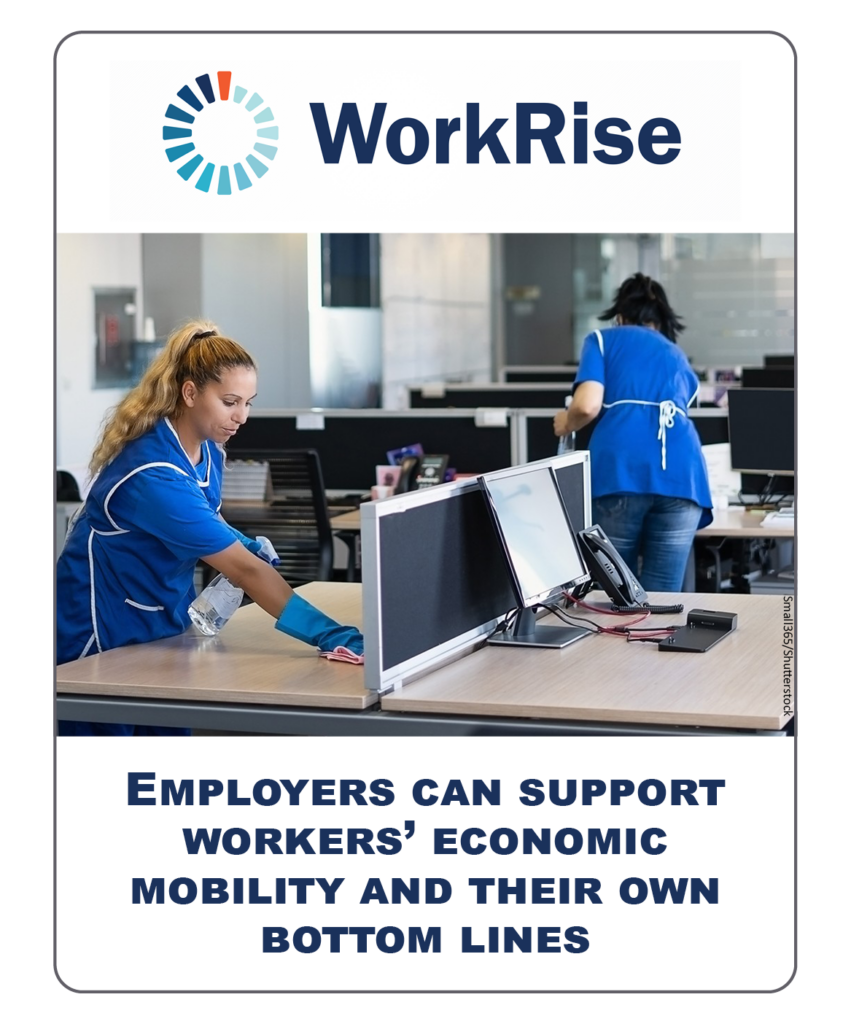
Employers can support workers’ economic mobility and their own bottom lines
This article provides a concise description of several strategies employers can use to create clear advancement pathways in their workplaces, which will help attract and retain quality candidates. It discusses research around what modern-day employees are looking for in a workplace and a position. It also links to a related article, which provides an overview of the framework created by Jobs for the Future (JFF) to describe the components of a good job.
WorkRise
November 2022
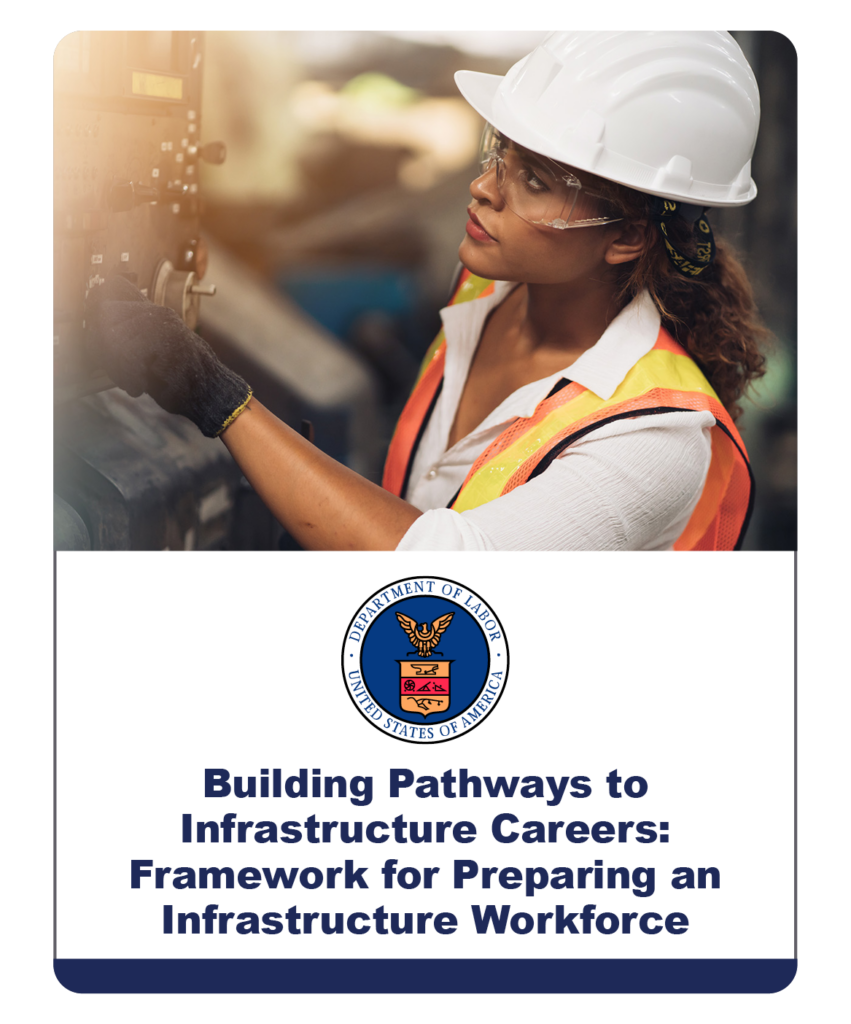
Building Pathways to Infrastructure Careers: Framework for Preparing an Infrastructure Workforce
This resource provides a framework for all workforce stakeholders, including infrastructure project leads, to engage the public workforce system in implementing the Bipartisan Infrastructure Law with strong workforce commitments and proven strategies that produce high-quality education, training, and employment opportunities for all workers.
U.S. Department of Labor, Employment and Training Administration
October 2022
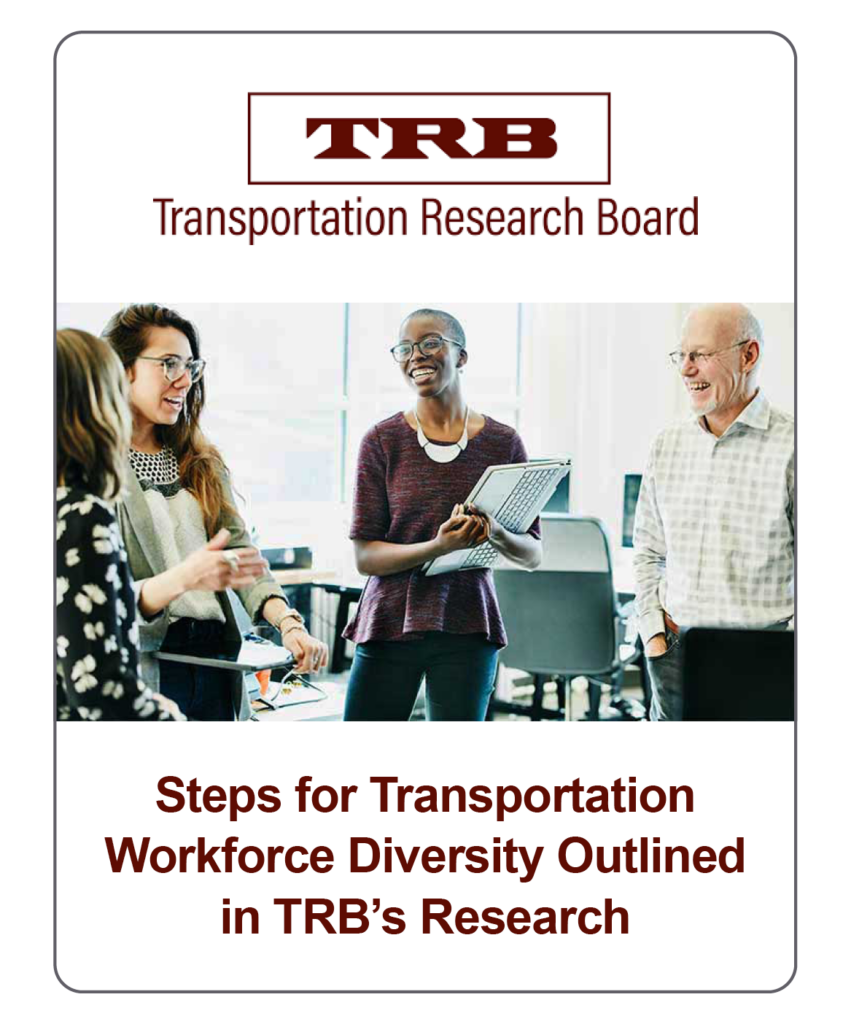
Steps for Transportation Workforce Diversity Outlined in TRB’s Research
This blog post highlights resources for improving inclusion and diversity in the transportation workforce.
Transportation Research Board
October 2022
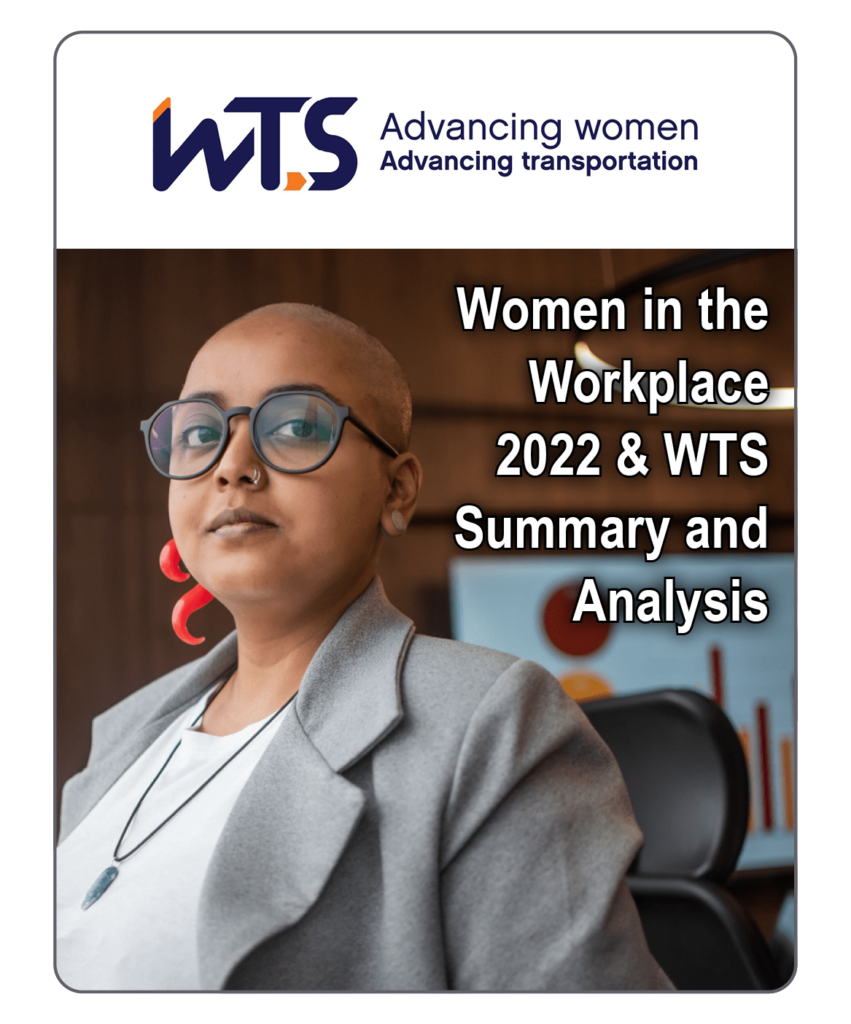
Women in the Workplace 2022
Women in the Workplace is the largest study on the state of women in corporate America. In 2015, LeanIn.Org and McKinsey & Company launched the study to give companies insights and tools to advance gender diversity in the workplace. The summary from WTS International outlines the report’s implications for the transportation workforce.
LeanIn.Org; McKinsey & Company; WTS International
October 2022
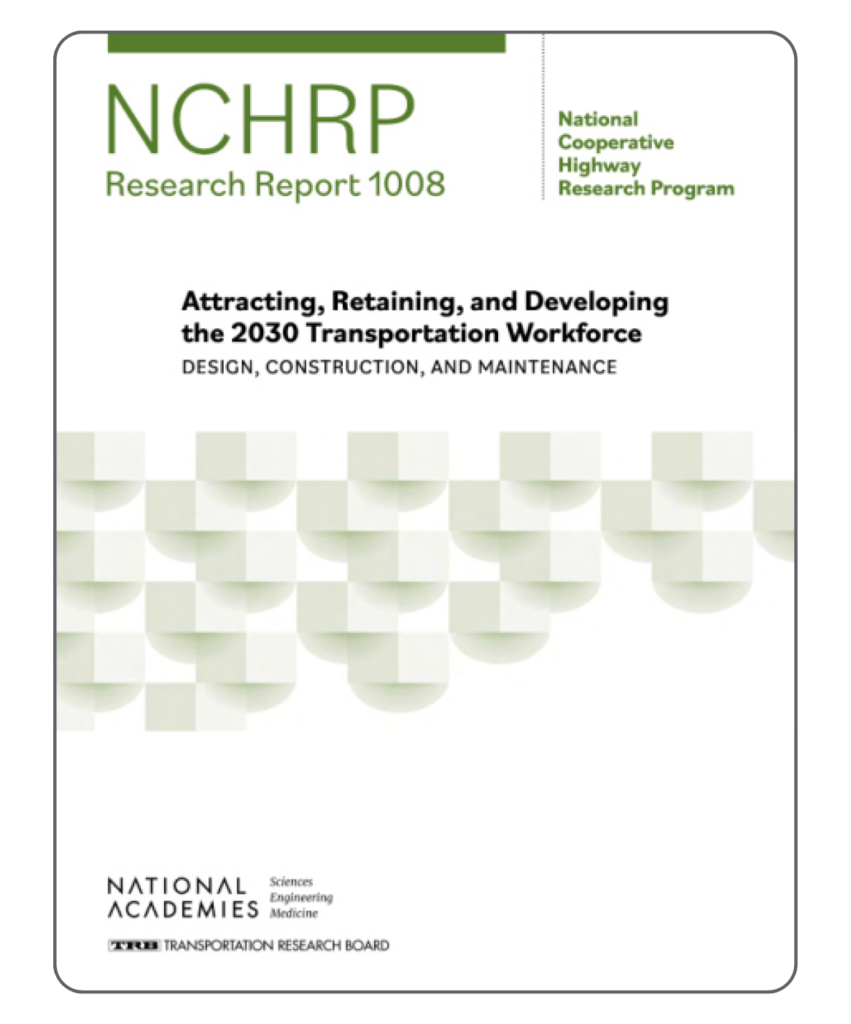
Attracting, Retaining, and Developing the 2030 Transportation Workforce
This report provides a guide with specific strategies and action plans to help agencies identify and address workforce needs through 2030 and beyond.
National Cooperative Highway Research Program
October 2022
State departments of transportation are responsible for providing a safe, efficient, and effective transportation system of infrastructure and services. To meet these responsibilities, transportation agencies need a highly skilled workforce with the expertise required to identify and address current transportation needs while also being prepared to address the challenges of the future.
Contributor(s): National Academies of Sciences, Engineering, and Medicine; Transportation Research Board; National Cooperative Highway Research Program; Candace Blair Cronin; Allison Alexander; Grace Arnold; Juan Carlos Batarse; Kelly Dray; Sasha Iliev; Jessica Jenkins; Erik Smallwood; Rachel Smart; Jake Streng; Mara Campbell; Susan Gallagher; Tyler Reeb; Tom O’Brien; Glenn McRae
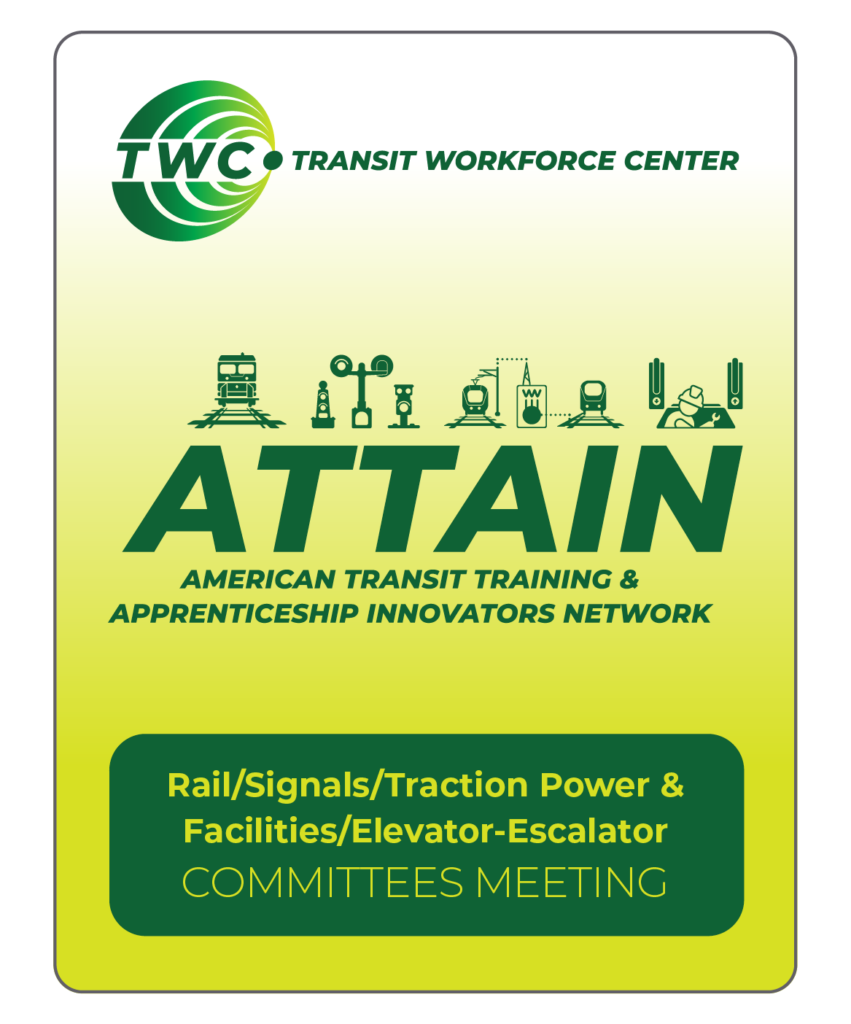
ATTAIN Rail/Signals/Traction Power and Facilities/Elevator-Escalator Committees Meeting
This recorded meeting of the ATTAIN committees for Rail/Signals/Traction Power and Facilities/Elevator-Escalator serves as a resource for transit industry stakeholders and includes presentations on apprenticeship and case studies of successful programs across the country.
Transit Workforce Center
September 2022
The American Transit Training and Apprenticeship Innovators Network (ATTAIN), run by the Transit Workforce Center (TWC), is a peer network created for transit agencies and labor unions to explore new apprenticeship programs or enhance existing programs for their frontline workforce.

Recruiting Seniors and Retirees at Cape Cod Regional Transit Authority
Cape Cod Regional Transit Authority; Transit Workforce Center
September 2022
Cape Cod Regional Transit Authority (CCRTA) in Massachusetts serves 15 towns within a 400 square miles area in an area where the population triples in the summer with seasonal residents. CCRTA runs seven year-round fixed route lines, several on-demand and hybrid on-demand services, and three summer shuttle services. In 2021, CCRTA served approximately 2.5 million people with 98 drivers.
Faced with driver shortages, CCRTA and Amalgamated Transit Union Local 1548 worked together and negotiated driver raises and $1,000 bonuses paid after 90-days. In addition, a six-step salary scale to reach the top pay grade was reduced to two steps. Drivers can now reach the top pay level within two years.
Barnstable County’s senior population is among the largest per capita in the country, and CCRTA has instituted hiring initiatives aimed toward the senior and retiree population. In connecting with this population, CCRTA has taken a variety of actions, including:
- Reaching out through Cape Cod Elder Services to communicate CCRTA’s interest in hiring seniors. CCRTA’s Human Services Transportation Manager sits on this organization’s board, facilitating ongoing contact.
- Targeting recruitment of retiring teachers, firefighters, police, and school bus drivers. Cape Cod RTA staff visited schools, fire houses, police stations, and municipal offices to share recruitment information.
- Visited each town on Cape Cod, talked with local retirement agency officials, and posted and mailed banners and notices.
- Overall increase in the agency’s traditional and social media presence generally, including advertising explicitly aimed at seniors, including on social media. Developed advertising, messaging, and imagery to make seniors and retirees feel welcome. To see samples of advertising, visit Cape Cod RTA Jobs on Facebook, the ad on their website’s front page, and see the video, featuring older drivers, on the CCRTA career page.
- Emphasizing the short time it takes to reach the highest salary level, a compelling message for seniors and retirees, who often value salaries more than benefits, as well as the ability to reach the highest level within their time at the agency.
- Offering various employment options, including full-time and part-time, and seasonal. The agency has found that individual needs lead to varied choices; they estimate their senior employees have split 50-50 in what scheduling option they choose.
- Providing full CDL training, testing and additional agency-specific training for all employees without CDLs. The agency pays for all training.
- Offering options for non-CDL drivers, who operate smaller vans. The agency encourages the CDL route because it gives drivers more flexibility in shifts and allows them to work and get paid at a higher rate.
- Currently exploring working with the Barnstable County Retirement Commission to arrange for a notice about CCRTA employment options to be part of the Commission’s information packet when an employee puts in for retirement.
CCRTA values its older workforce and their commitment to the job; through its efforts, it has been able to hire a dozen seniors and retirees as drivers. The agency notes that with this population, it is reasonable to expect excellent attendance, while also allowing for the potential of more short-term disability and time for medical appointments. COVID-19 saw CCRTA lose about half of its senior workforce, given seniors’ sensitivity to exposure. However, CCRTA is renewing its recruitment efforts in this area through the various methods noted.
For more information, contact:
Penny Grossman, H.R. Manager – Pgrossman@capecodrta.org – 508-385-1430, ext. 106
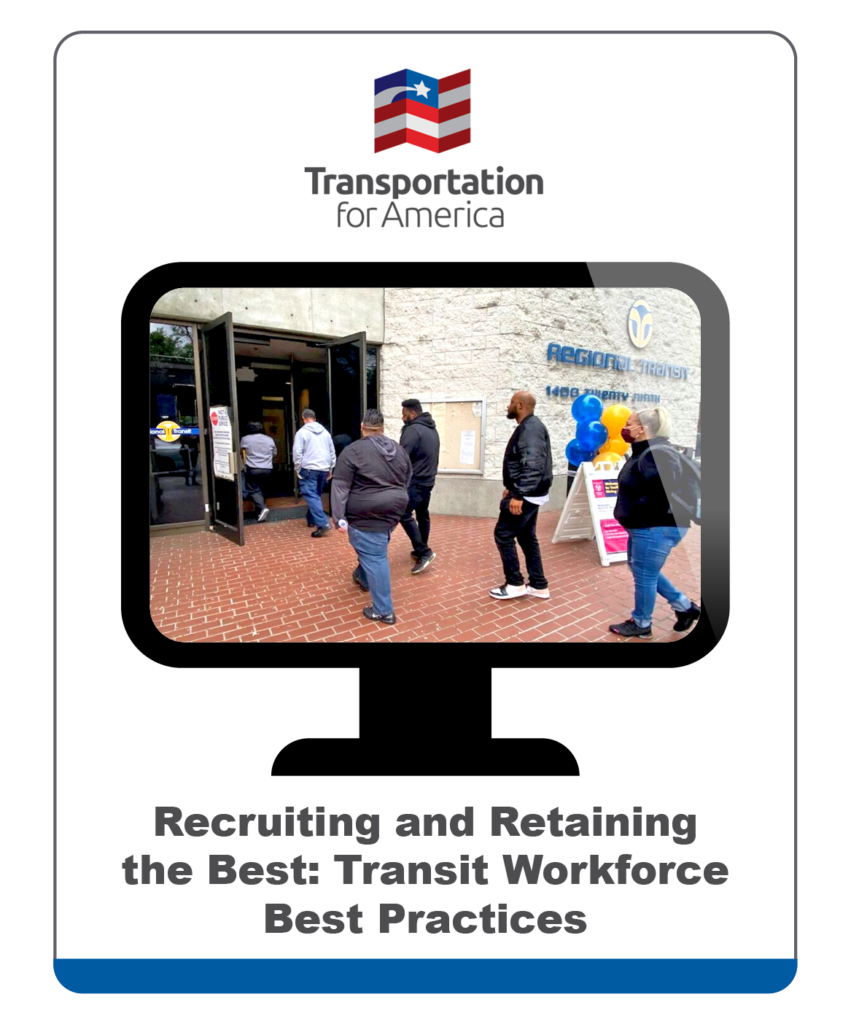
Recruiting and Retaining the Best: Transit Workforce Best Practices
This blog post from Transportation for America details successful strategies and best practices employed by transit agencies to empower their operator and maintenance workforces.
Transportation for America
September 2022

Wire Women: Lighting it Up
This illustrated publication tells the stories of women who are undertaking apprenticeship to become union electricians. This resource could be used by transit agencies, unions, or apprenticeship programs as promotional material or for educational purposes.
Sharon Szymanski
September 2022
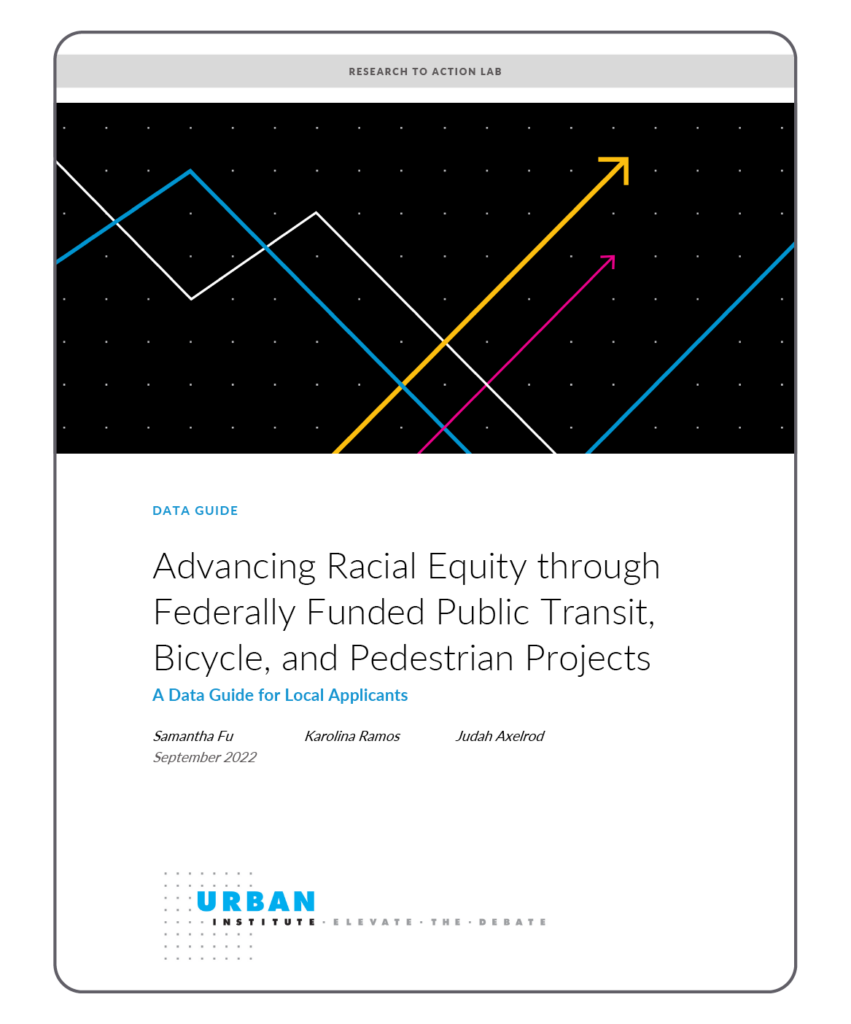
Advancing Racial Equity through Federally Funded Public Transit, Bicycle, and Pedestrian Projects
This report provides data sources and tools to quantify racial equity and environmental justice in transportation-related projects. It also describes how the data can be used to speak to the equity priorities of grants available through the Infrastructure and Investment Jobs Act.
Urban Institute
September 2022
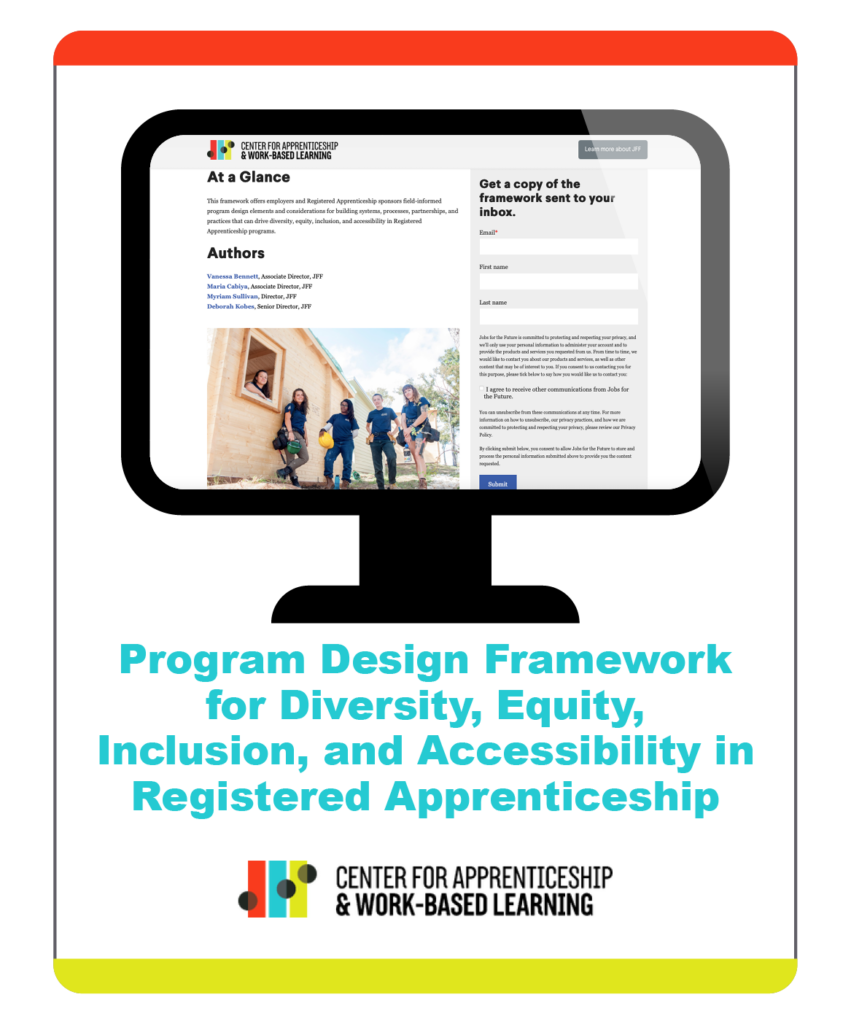
Program Design Framework for Diversity, Equity, Inclusion, and Accessibility in Registered Apprenticeship
This framework offers employers and Registered Apprenticeship sponsors field-informed program design elements and considerations for building systems, processes, partnerships, and practices that can drive diversity, equity, inclusion, and accessibility in Registered Apprenticeship programs.
Jobs for the Future Center for Apprenticeship & Work-Based Learning
September 2022

Second Chance Transit Programs
Several transit agencies across the country have established Second Chance programs to support formerly-incarcerated individuals as they reenter the workforce; these programs set pathways into frontline transit positions, often focusing on driver recruitment. These initiatives involve active collaboration between transit agencies and departments of corrections. Agencies have also worked with other partners, including their local unions, state and local workforce development agencies, ex-offender support programs, and local community organizations.
August 2022
Basic descriptions of some current state and local programs can be found at the links below.
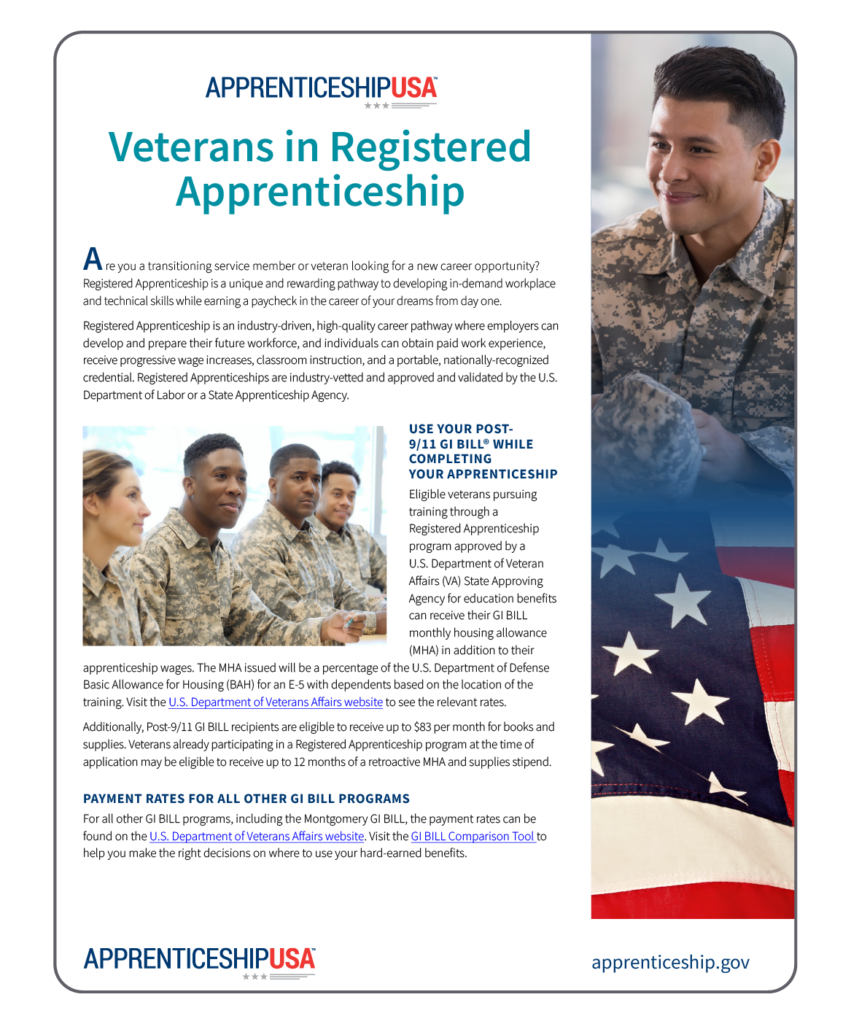
Veterans in Registered Apprenticeship
This fact sheet provides an overview of how veteran-specific public benefits can be applied to support a veteran’s completion of a registered apprenticeship program. It also provides links to resources for more detailed information on apprenticeship resources for service members, employment resources for veterans, and more.
ApprenticeshipUSA
August 2022
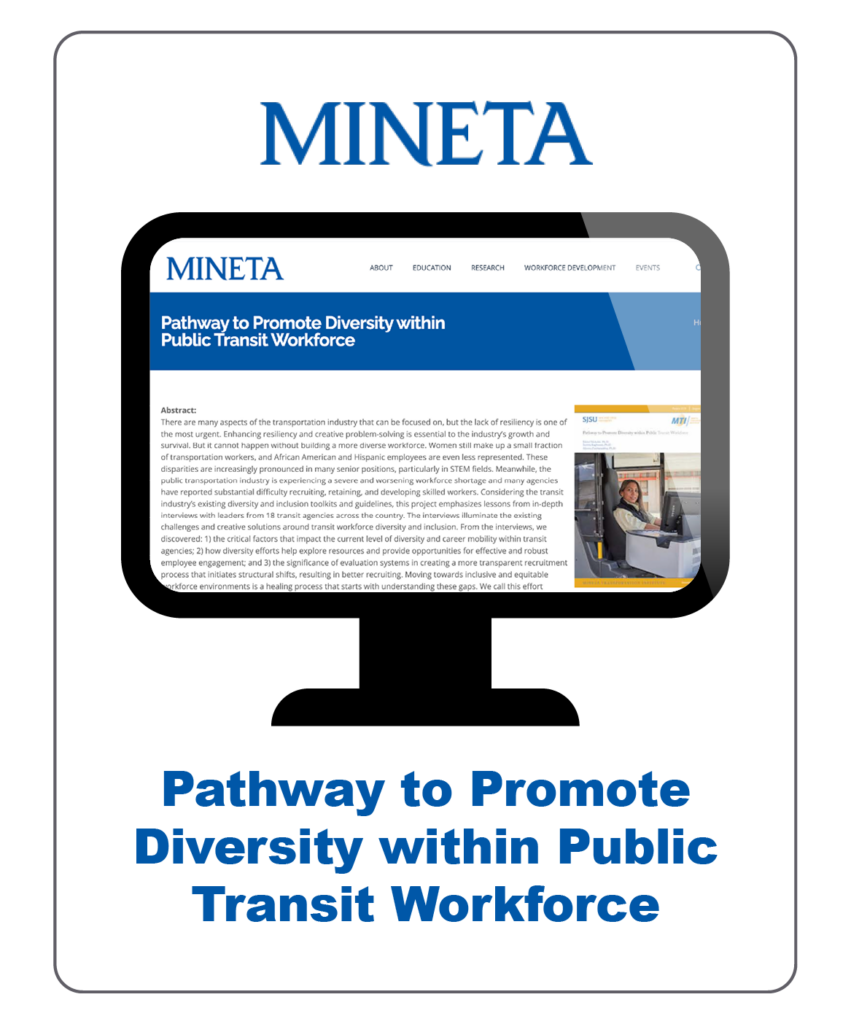
Pathway to Promote Diversity within Public Transit Workforce
Considering the transit industry’s existing diversity and inclusion toolkits and guidelines, this project emphasizes lessons from in-depth interviews with leaders from 18 transit agencies across the country. The report highlights: the critical factors that impact the current level of diversity and career mobility within transit agencies; how diversity efforts help explore resources and provide opportunities for effective and robust employee engagement; and the significance of evaluation systems in creating a more transparent recruitment process that initiates structural shifts, resulting in better recruiting.
Mineta Transportation Institute
August 2022
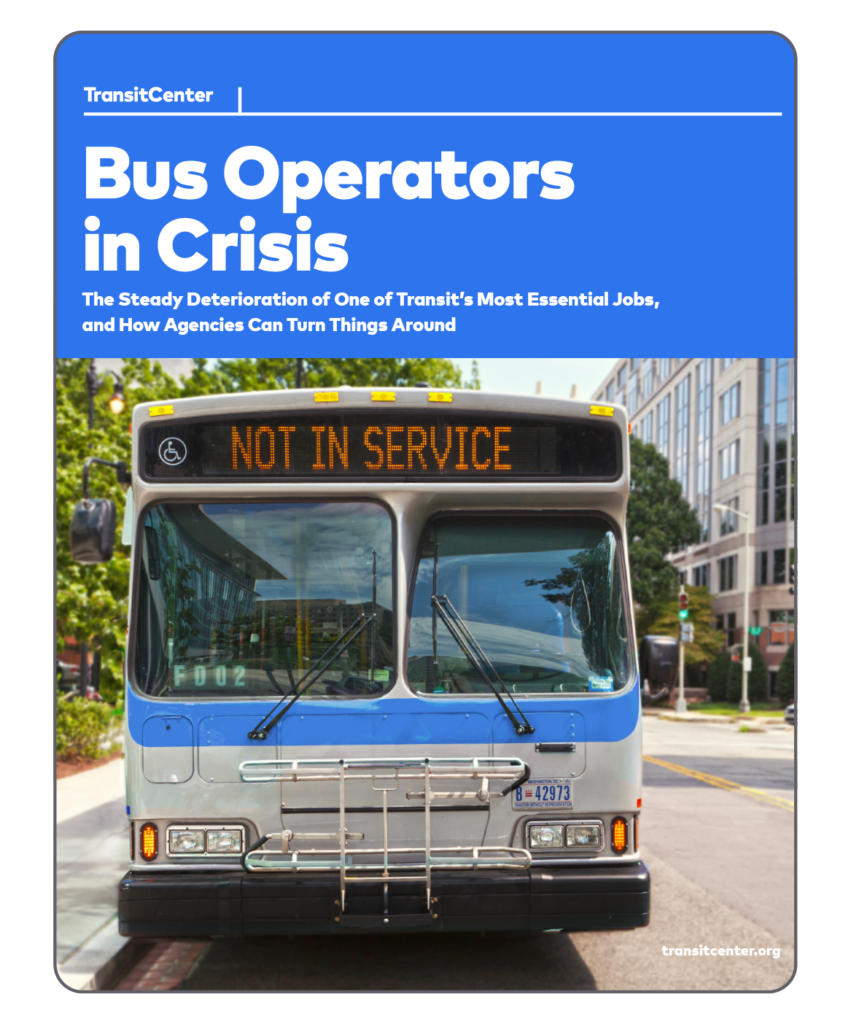
Bus Operators in Crisis
TransitCenter’s report, entitled Bus Operators in Crisis: The Steady Deterioration of One of Transit’s Most Essential Jobs, and How Agencies Can Turn Things Around, analyzes the nationwide phenomenon of bus operator shortages and advocates for enhanced job quality in the occupation. It details the challenges American operators are facing, and offers solutions that transit agencies can take to solve issues locally, as well as steps that state and the federal governments can take to provide agencies with necessary support.
TransitCenter
July 2022
This resource also includes a link to a webinar hosted in July, 2022 presenting information from the report and slides from the webinar.
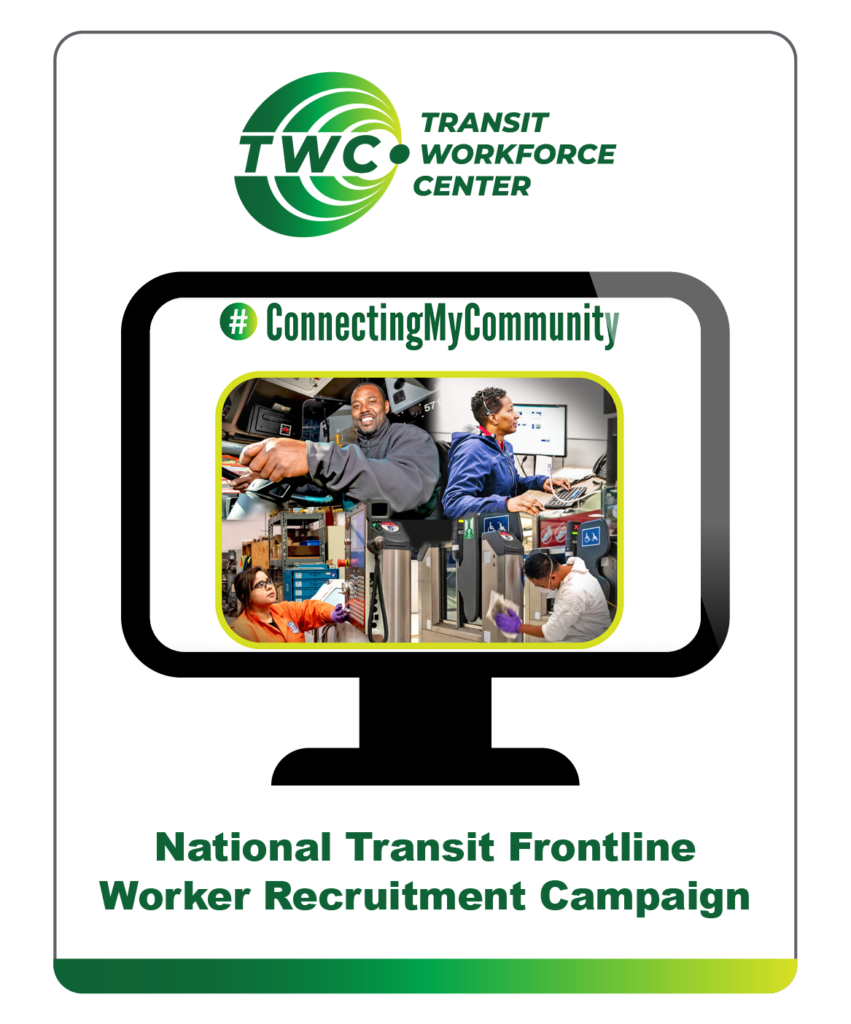
National Transit Frontline Worker Recruitment Campaign
Across the United States, whether large, small, urban, rural, or tribal, transit agencies are facing the challenge of recruiting and retaining drivers, mechanics, and technicians who can operate and maintain the buses of our public transit systems. To help support local transit efforts, TWC is developing the #ConnectingMyCommunity national frontline worker recruitment campaign, coordinated with the Federal Transit Administration (FTA) and industry, labor, and community partners from around the country.
Transit Workforce Center
July 2022
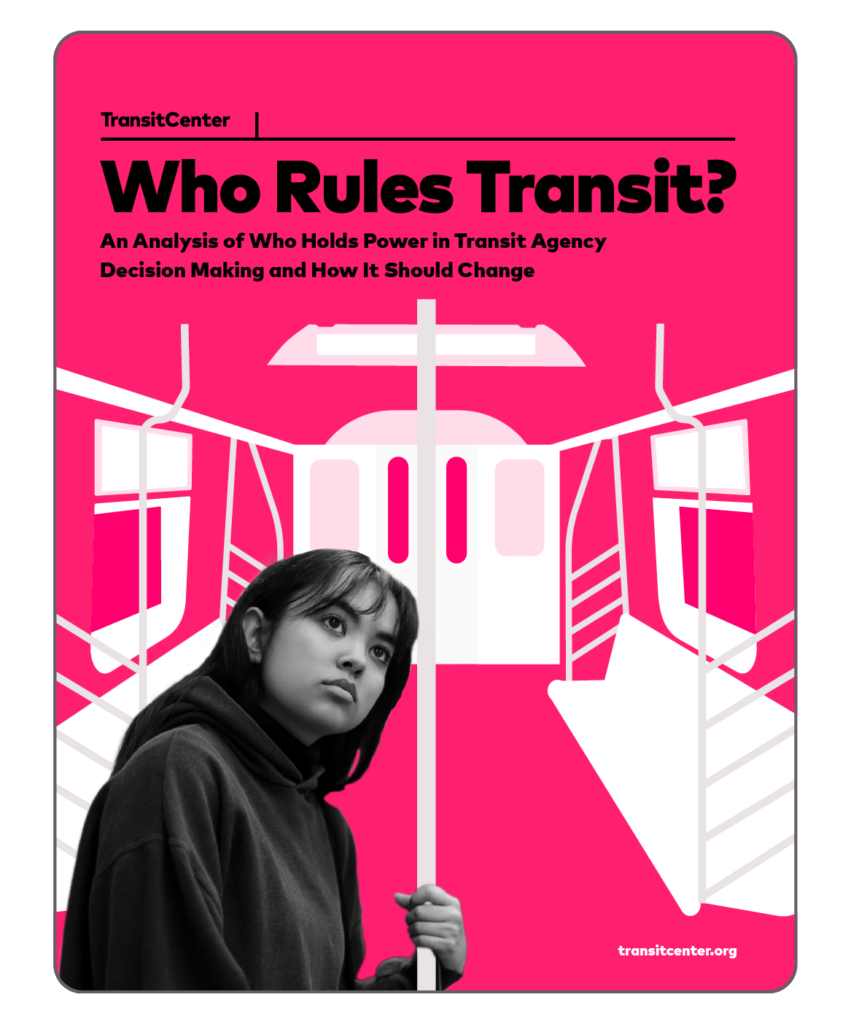
Who Rules Transit?
This report examines who makes key decisions at transit agencies and who is affected by these decisions. The report provides case studies of agencies that have taken steps to give transit riders and workers more power in the decision-making process.
TransitCenter
April 2022
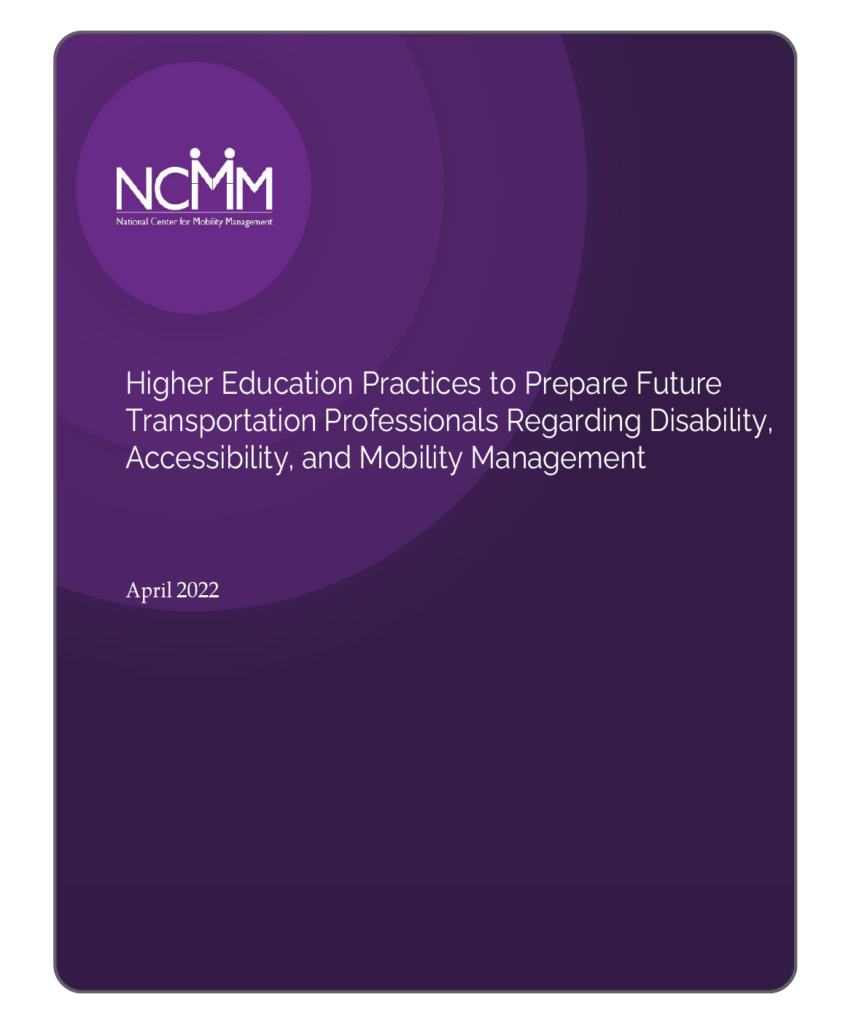
Higher Education Practices to Prepare Future Transportation Professionals Regarding Disability, Accessibility, and Mobility Management
This National Center for Mobility Management (NCMM) Information Brief provides the results of a NCMM study regarding mobility management, disability, and accessibility content in higher education preparation programs. This brief offers recommendations regarding how to integrate such content, as well as information on the recruitment and retention of individuals with disabilities in the transportation industry.
Please click the link below to view NCMM’s Mobility Management in Practice Series; this brief is listed among several 2022 publications.
National Center for Mobility Management (NCMM)
April 2022
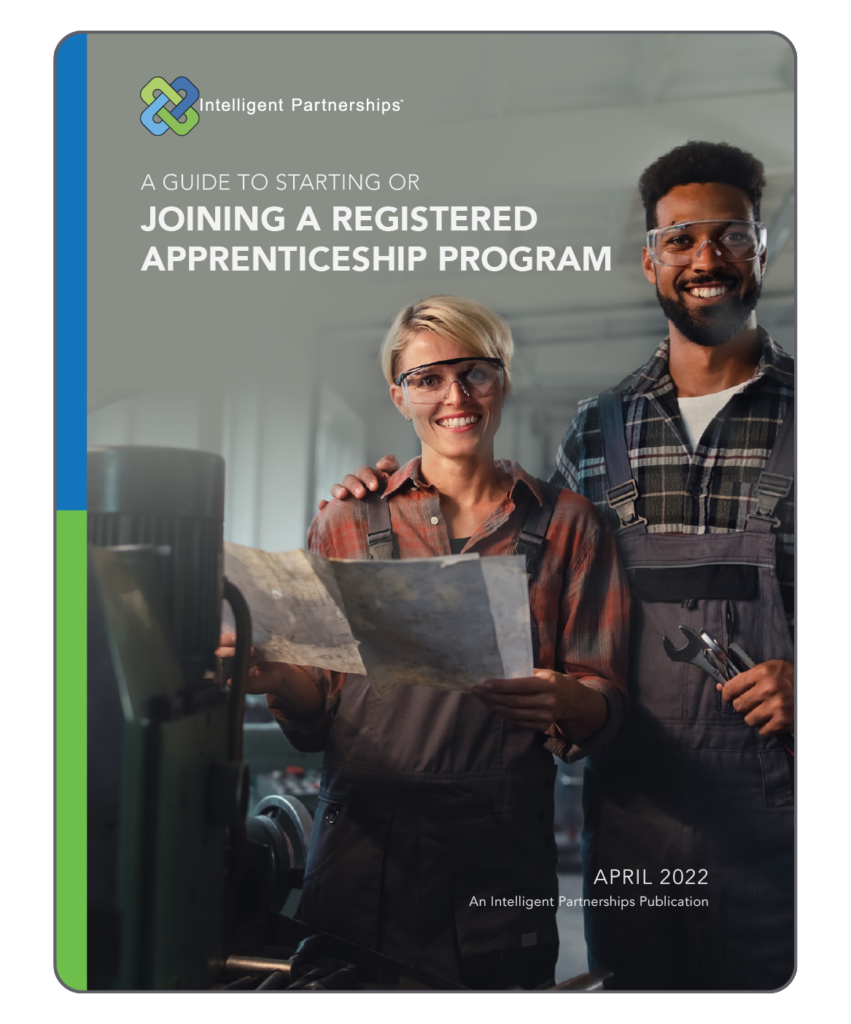
A Guide to Starting or Joining a Registered Apprenticeship Program
This publication provides an overview of registered apprenticeship, the benefits of registered apprenticeships to the employer, and the basic steps to get started.
You can also consult with your state office on registered apprenticeship for technical assistance and support for questions on the apprenticeship model, guidance on each phase of developing a program, connections to training providers, and advice on available funding sources to support apprenticeships: https://www.apprenticeship.gov/about-us/state-offices
Intelligent Partnerships
April 2022
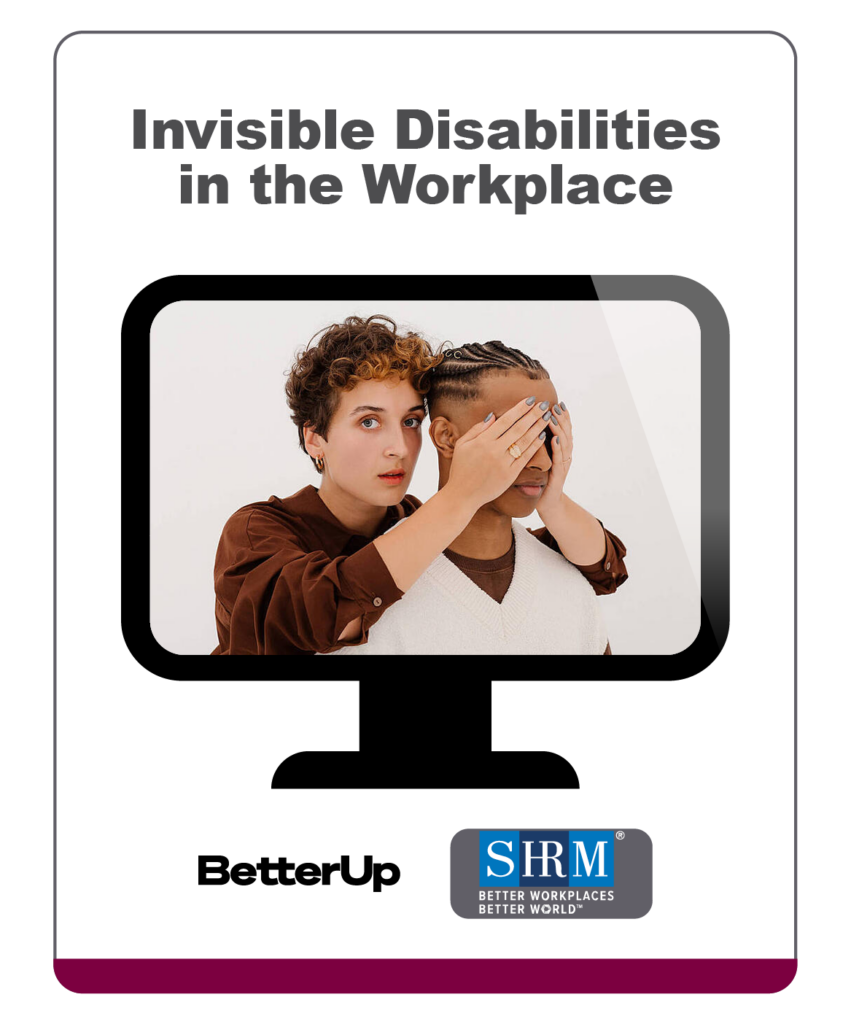
Invisible Disabilities in the Workplace
These two resources provide insight for employers into what “invisible” or “hidden” disabilities are, how to provide opportunities for employees to voluntarily disclose them, and how to support individuals with such disabilities to be successful in the workplace.
BetterUp; SHRM
February 2022
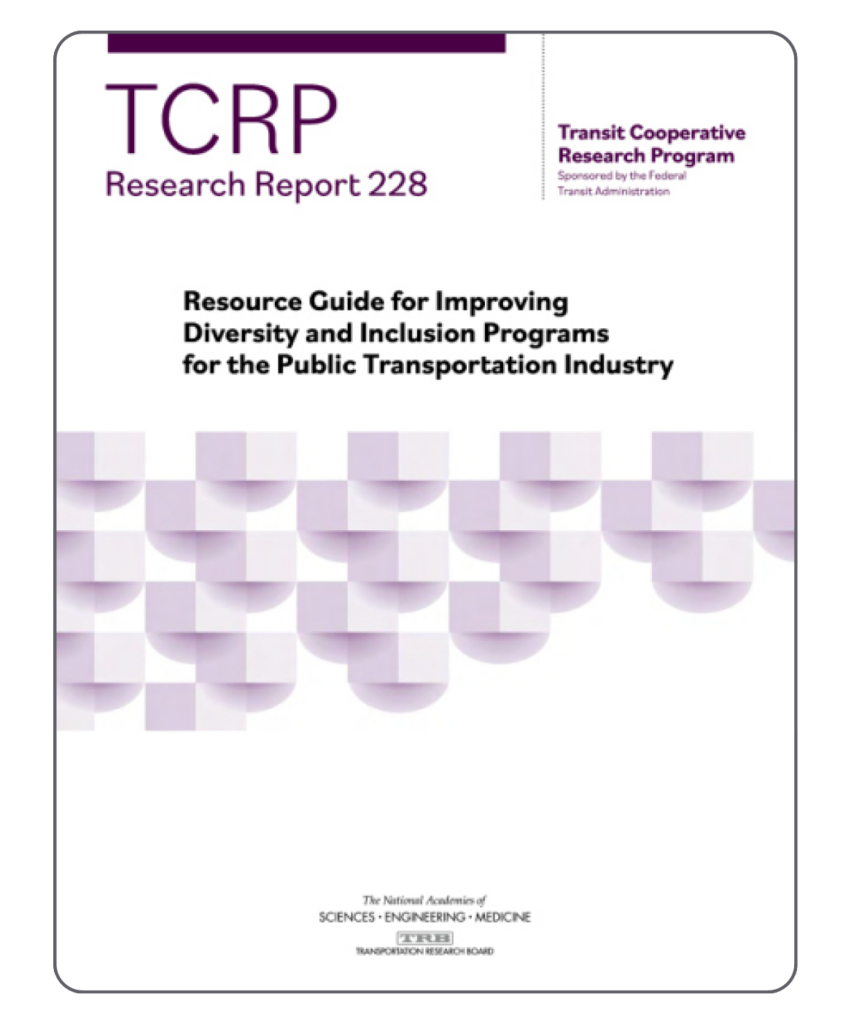
Improving Diversity and Inclusion Programs in Public Transportation
This webinar provides an overview of current diversity and inclusion efforts utilized by large, medium, and small public transportation agencies in the United States. Presenters highlight how agencies embed equity in operations and discuss policies that impact employees, local businesses, and community members. They also discuss a diversity and inclusion toolkit, which can be adapted to fit the contexts of any transit agency. At the end of this webinar, you will able to:
-Identify how to develop benchmarks to measure diversity, equity, and inclusion
-Determine methods for transit agencies to improve equity
The webinar features research from TCRP Research Report 228: Resource Guide for Improving Diversity and Inclusion Programs for the Public Transportation Industry.
Transportation Research Board
February 2022
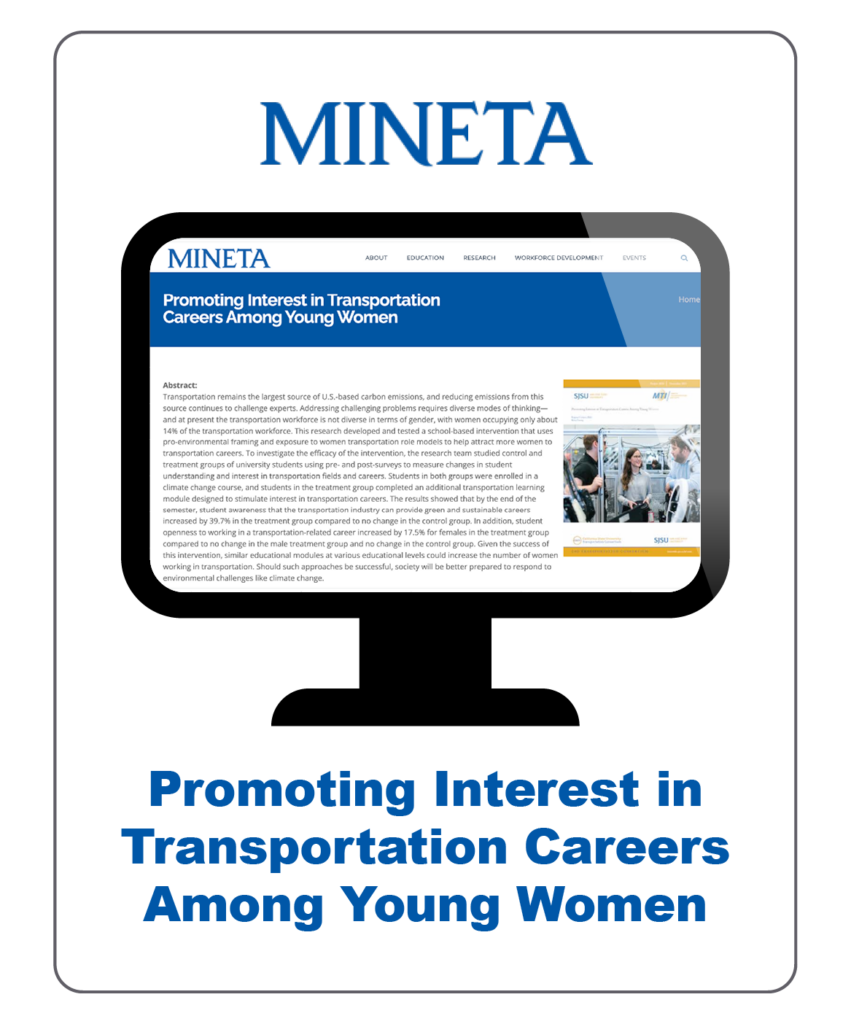
Promoting Interest in Transportation Careers Among Young Women
This research developed and tested a school-based intervention that uses pro-environmental framing and exposure to women transportation role models to help attract more women to transportation careers. The paper explains how this method increased student awareness that the transportation industry can provide green and sustainable careers, particularly for female students.
Mineta Transportation Institute
November 2021
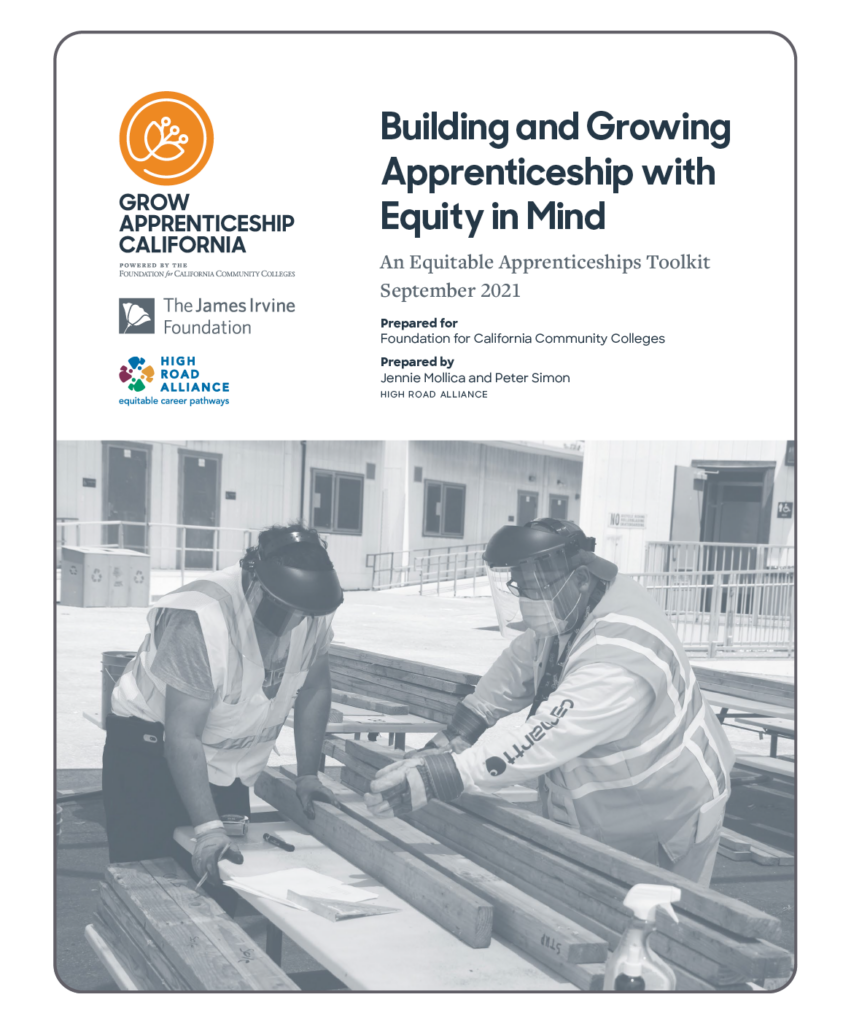
Building and Growing Apprenticeship with Equity in Mind
This toolkit was created to help those whose work involves designing and running pre-apprenticeship and apprenticeship programs to intentionally encourage and support the inclusion of apprentices who reflect the full
diversity of our communities — in terms of race, ethnicity, gender, primary language, disability, age, sexual orientation, and other factors.
High Road Alliance
September 2021
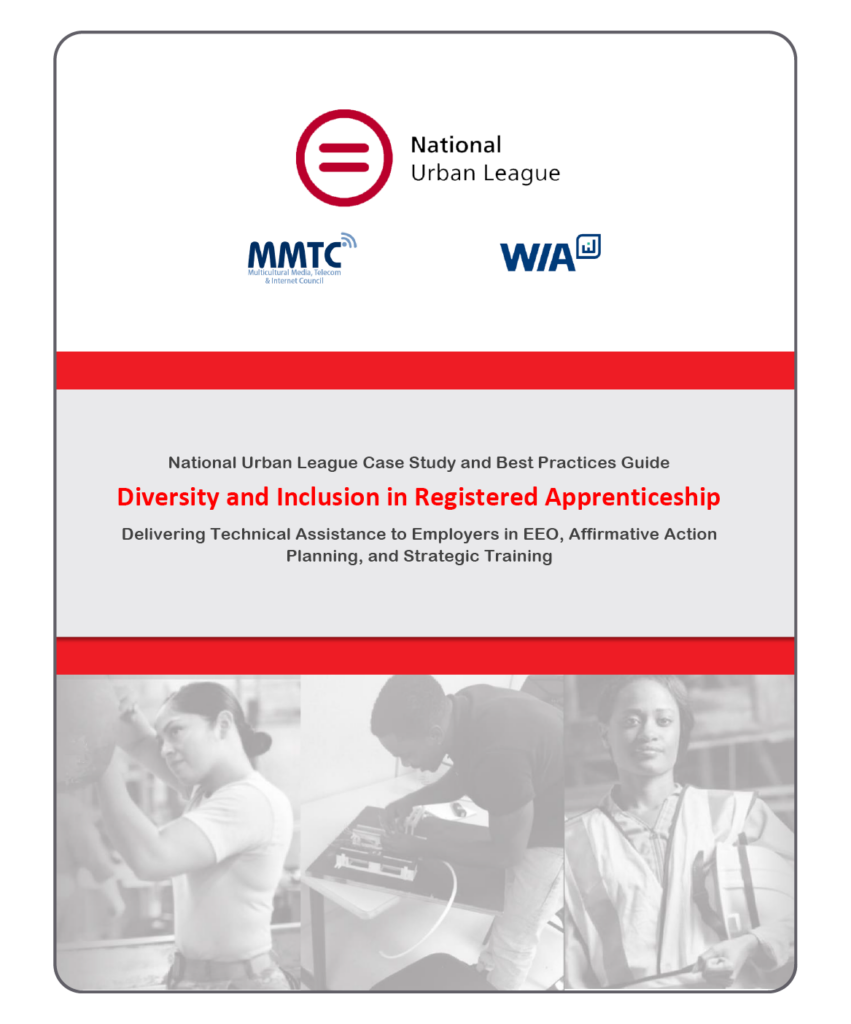
Diversity and Inclusion in Registered Apprenticeship
This case study examines the NUL Consortium’s strategies for providing technical assistance to employers as they seek to promote and diversify their Registered Apprenticeship programs. It includes a best practices toolkit detailing EEO compliance, affirmative action planning, and NUL’s employer DEIA training. It seeks to serve as a replicable guide for industry, equity, and opportunity partners, community-based organizations, and other groups or individuals with similar goals.
National Urban League
July 2021
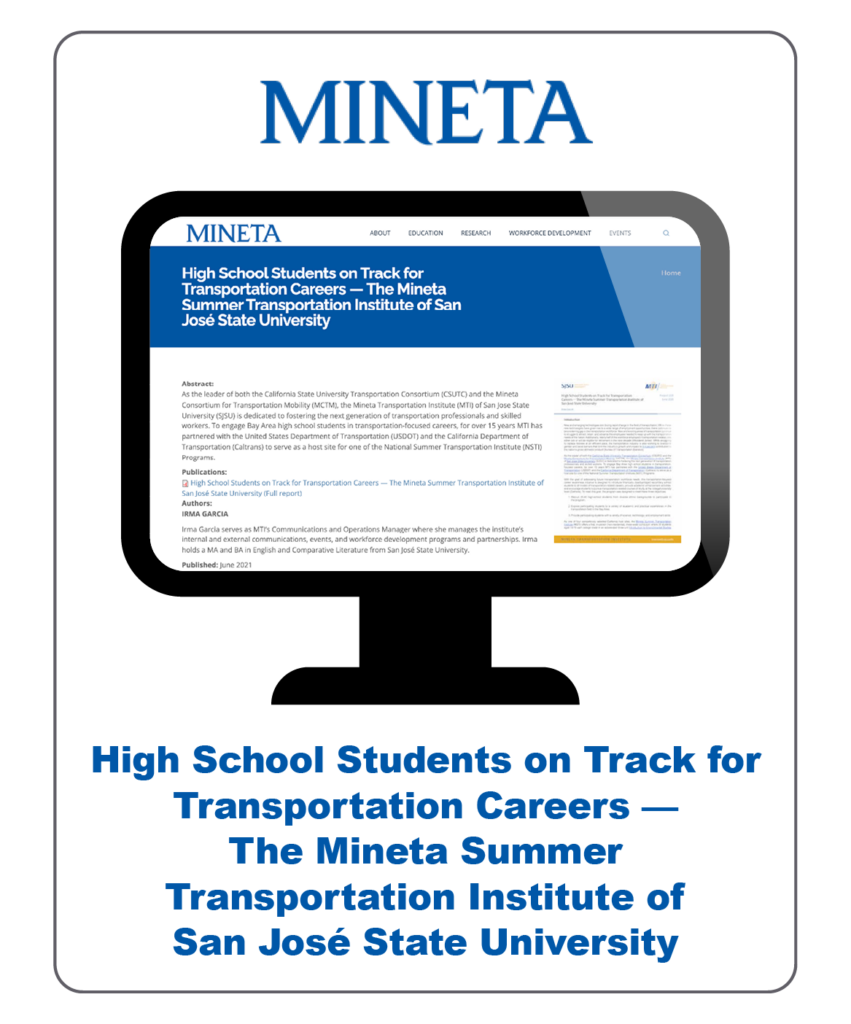
High School Students on Track for Transportation Careers
Mineta Transportation Institute
June 2021
This report provides an overview of the Mineta Summer Transportation Institute, one of the National Summer Transportation Institute (NSTI) Programs, which recruits high-school students from diverse ethnic backgrounds, exposes them to a variety of academic and practical experiences in the transportation field in the Bay Area, and provides participating students with a variety of science, technology, and employment skills. The report shares program history, demographics, activities, etc.
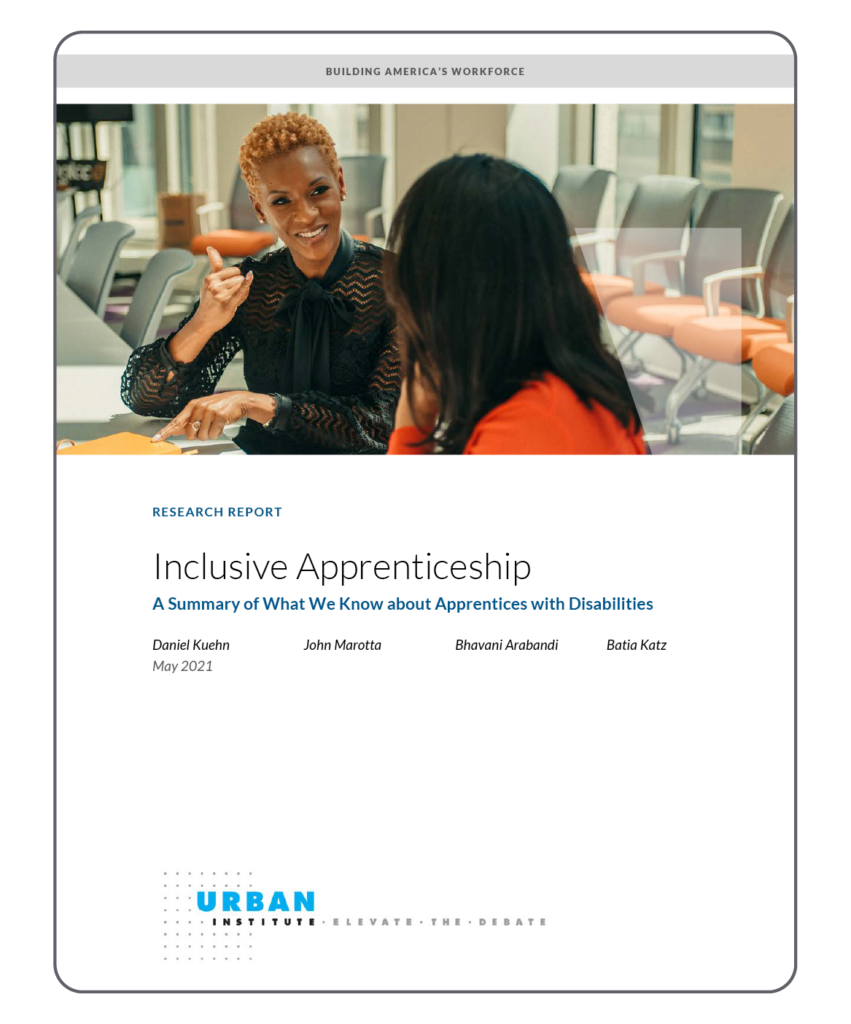
Inclusive Apprenticeship: A Summary of What We Know about Apprentices with Disabilities
This report summarizes current information on experiences of people with disabilities in apprenticeship, drawing on the research literature, interviews with experts on inclusive apprenticeship, and administrative and survey data. This report’s goal is to synthesize information about inclusive apprenticeship and provide insights about best practices to deepen both researchers’ and practitioners’ understanding.
Urban Institute
May 2021
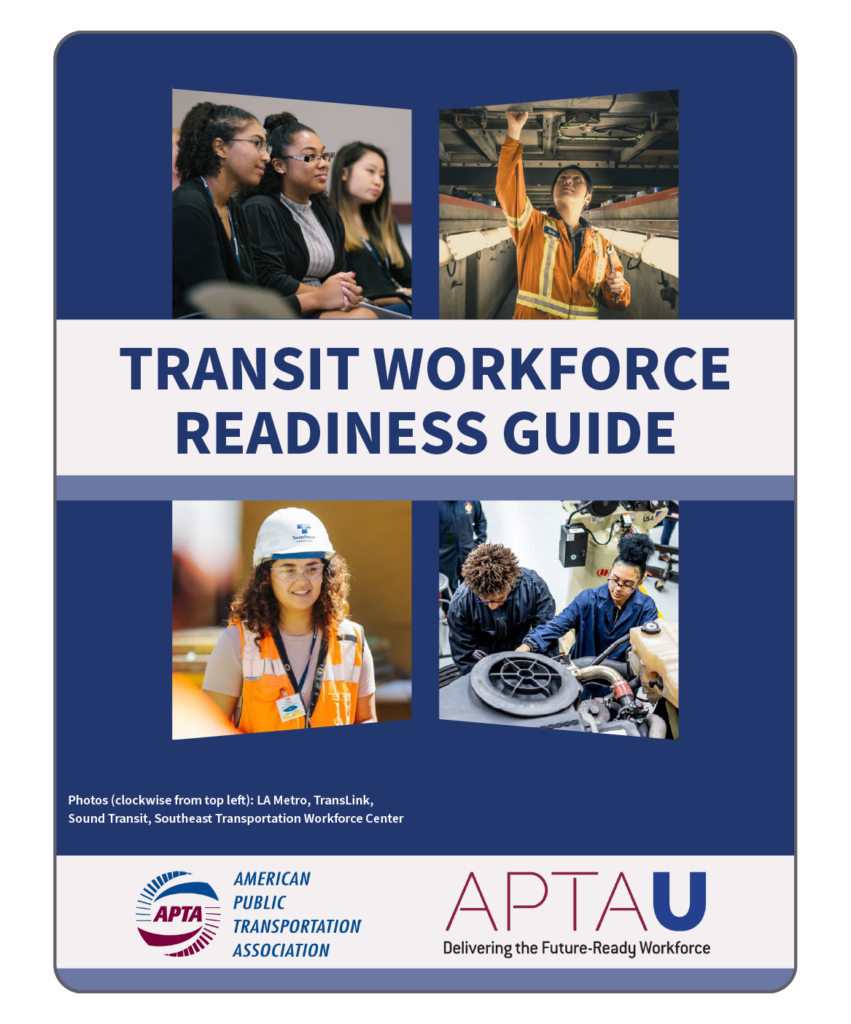
APTA Transit Workforce Readiness Guide
APTA’s Transit Workforce Readiness Guide is a highly interactive and easy-to-use online resource for executives and their staff to assist organizations in building a more diverse talent pipeline by attracting high school students, especially those coming from underserved communities, into entry-level transit positions.
American Public Transportation Association
March 2021
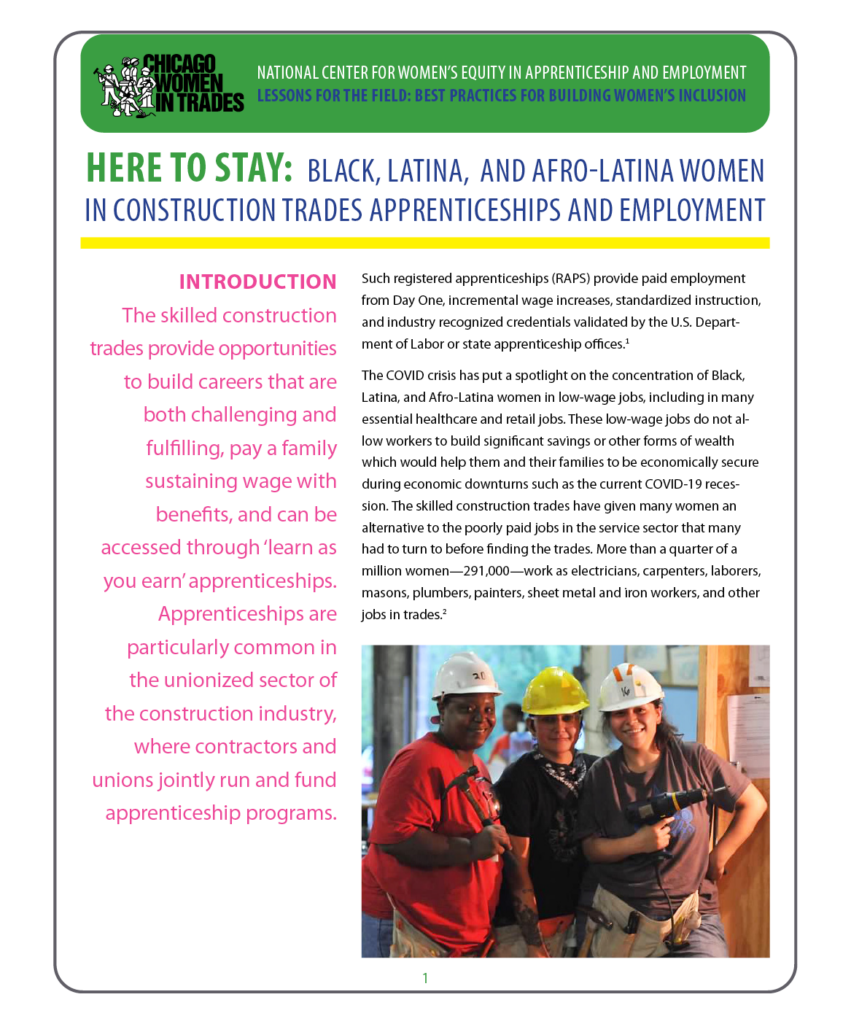
Here to Stay: Black, Latina, and Afro-Latina Women in Construction Trades Apprenticeships and Employment
Chicago Women in the Trades; Institute for Women's Policy Research
March 2021
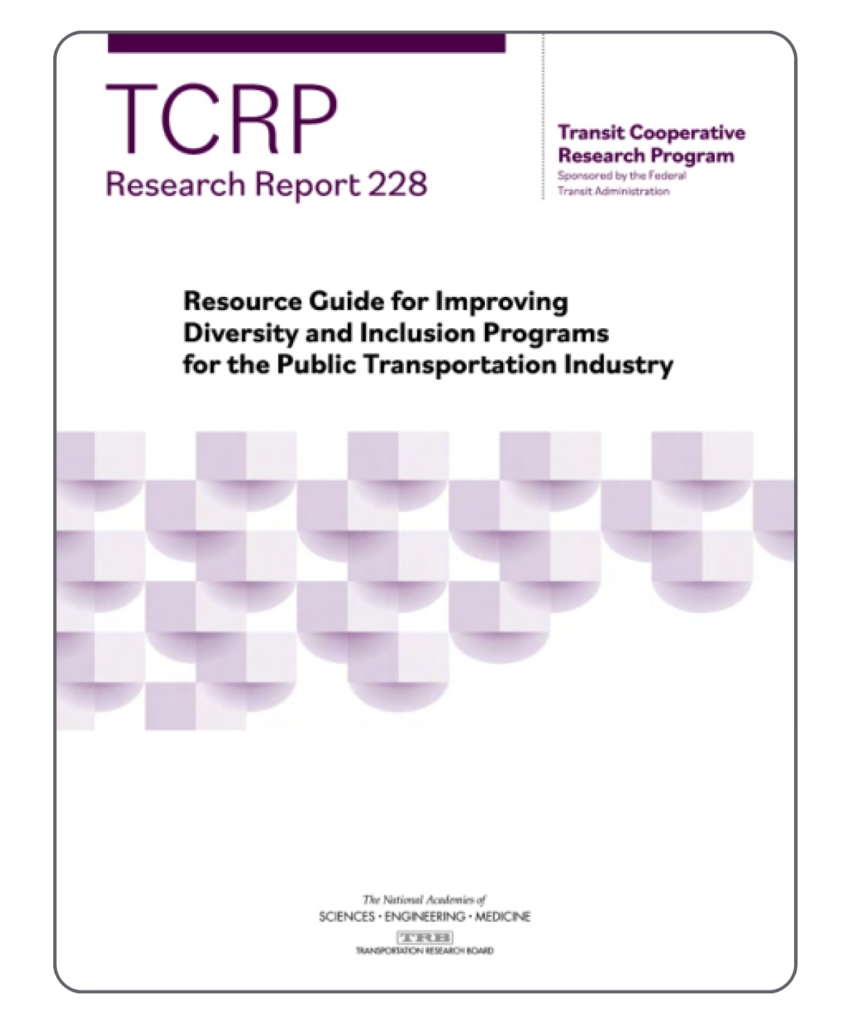
Resource Guide for Improving Diversity and Inclusion Programs for the Public Transportation Industry
This TCRP Research Report 228 examines industry diversity programs, including how inclusion has been incorporated, and what policies, plans, and practices have been successfully implemented.
Transit Cooperative Research Program
January 2021
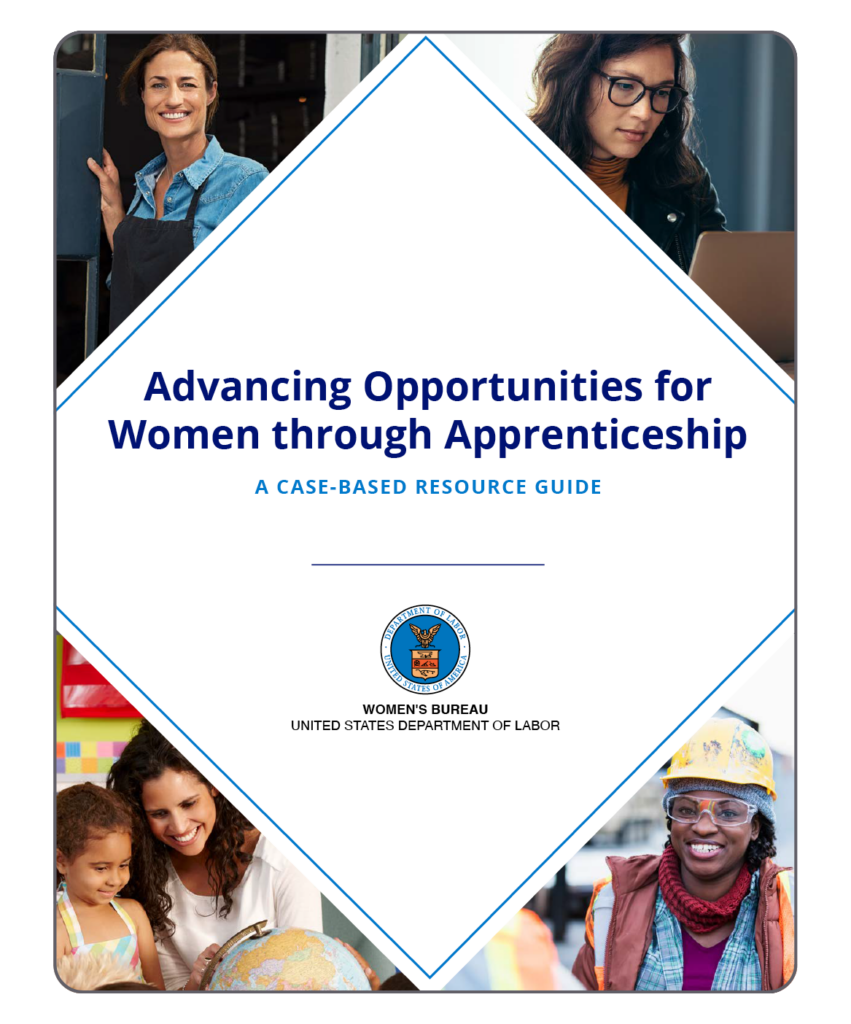
Advancing Opportunities for Women through Apprenticeship: A Case-Based Resource Guide
The Advancing Opportunities for Women through Apprenticeship case-based resource guide provides a framework for meaningful expansion of apprenticeship programs for women. The guide includes case studies on four high-quality, women-inclusive pre-apprenticeship and apprenticeship programs in a range of industry sectors.
Department of Labor
The case studies were developed through on-site visits to the program locations; interviews with program staff, partners, and current and former participants; and a review of program materials and data. They provide information and insights related to partnership development, program design, and outcomes that outline how pre-apprenticeship and apprenticeship programs can help women access family-sustaining jobs and quality career pathways. The guide identifies common strategies across the four programs to help others learn how to create programs that successfully open pathways to in-demand jobs for women through apprenticeships.
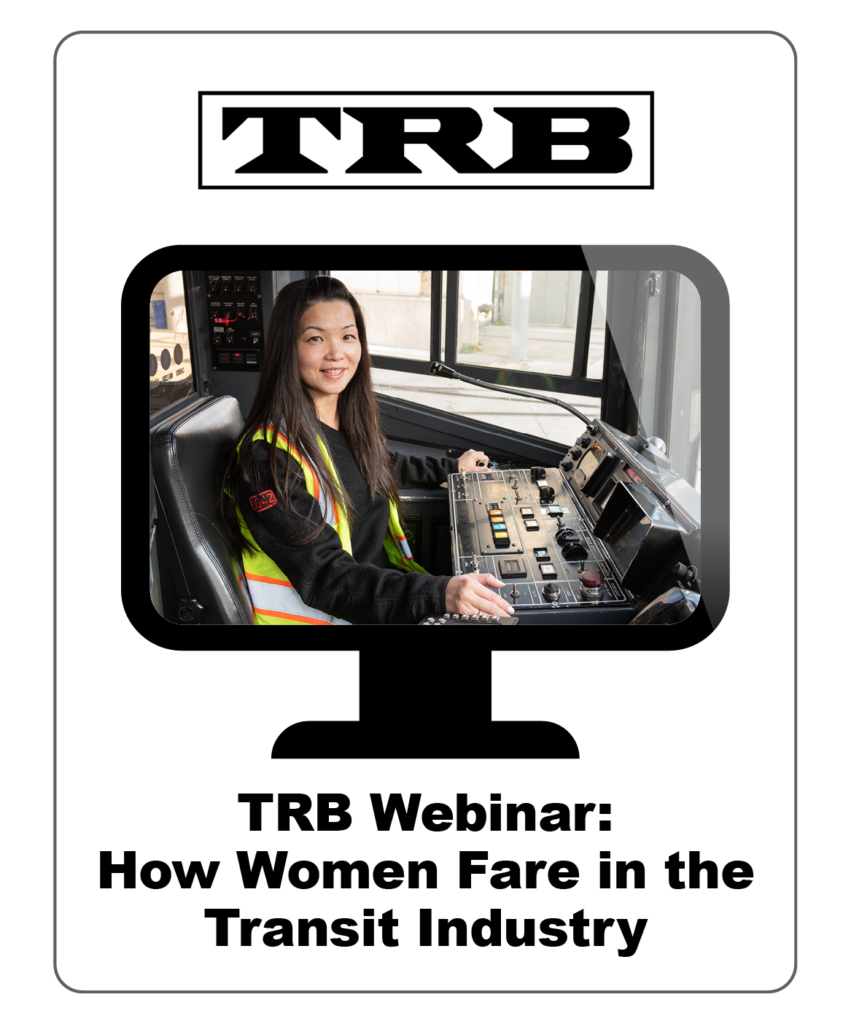
How Women Fare in the Transit Industry
This webinar provides an overview of the barriers and solutions to including more women in the transit industry. Panelists discuss strategies to support women in transit and share examples of transit agencies that have effectively implemented programs to attract, retain, and advance women in the industry.
Transportation Research Board
September 2020
The webinar draws on research from TCRP Synthesis 147: Attracting, Retaining, and Advancing Women in Transit.
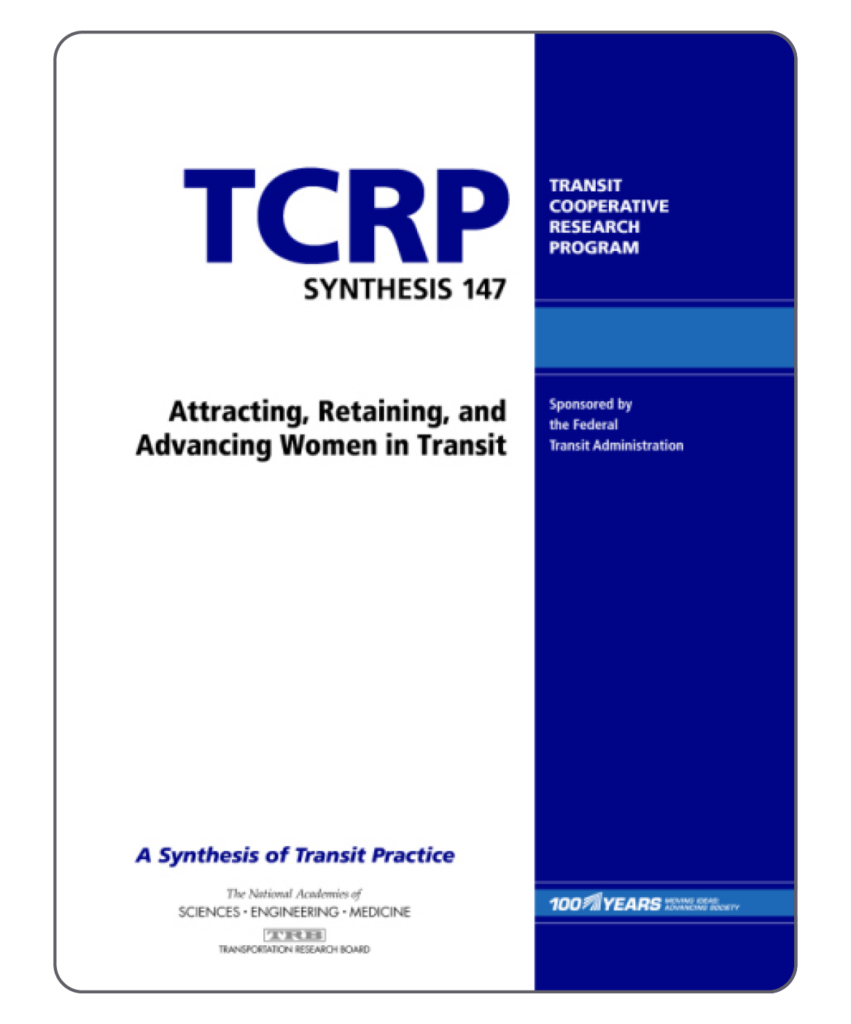
Attracting, Retaining, and Advancing Women in Transit
This TCRP report explores the strategies that have been deployed in transit and other related industries in order to attract, retain, and advance women in a variety of roles. It includes a survey of current representation of women, barriers faced, and diversity initiatives in the transportation industry, as well as case studies from several major transit agencies.
Transit Cooperative Research Program
January 2020
Contributor(s): National Academies of Sciences, Engineering, and Medicine; Transportation Research Board; Transit Cooperative Research Program; ICF Allison Alexander
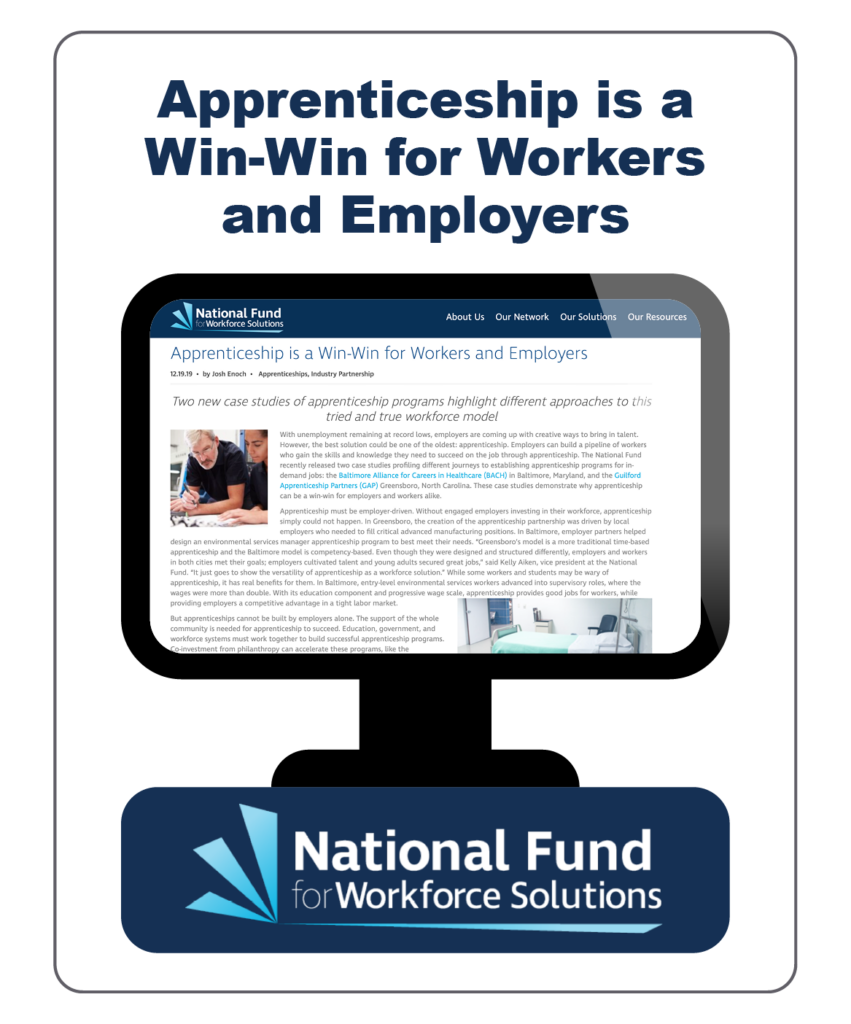
Apprenticeship is a Win-Win for Workers and Employers
These two case studies provide an analysis of apprenticeship programs at Baltimore Alliance for Careers in Healthcare (BACH) in Baltimore, Maryland, and the Guilford Apprenticeship Partners (GAP) in Greensboro, North Carolina. The case studies highlight the different approaches each organization used for their apprenticeship programs.
National Fund for Workforce Solutions
December 2019

Emerging Leaders Presentation: Recruiting & Retaining Bus Operators
This slidedeck, from the APTA Emerging Leaders Program class of 2019 presentations, provides an overview of research and transit agency case studies to capture key themes on the topics of bus operator recruitment and retention.
American Public Transportation Association
December 2019
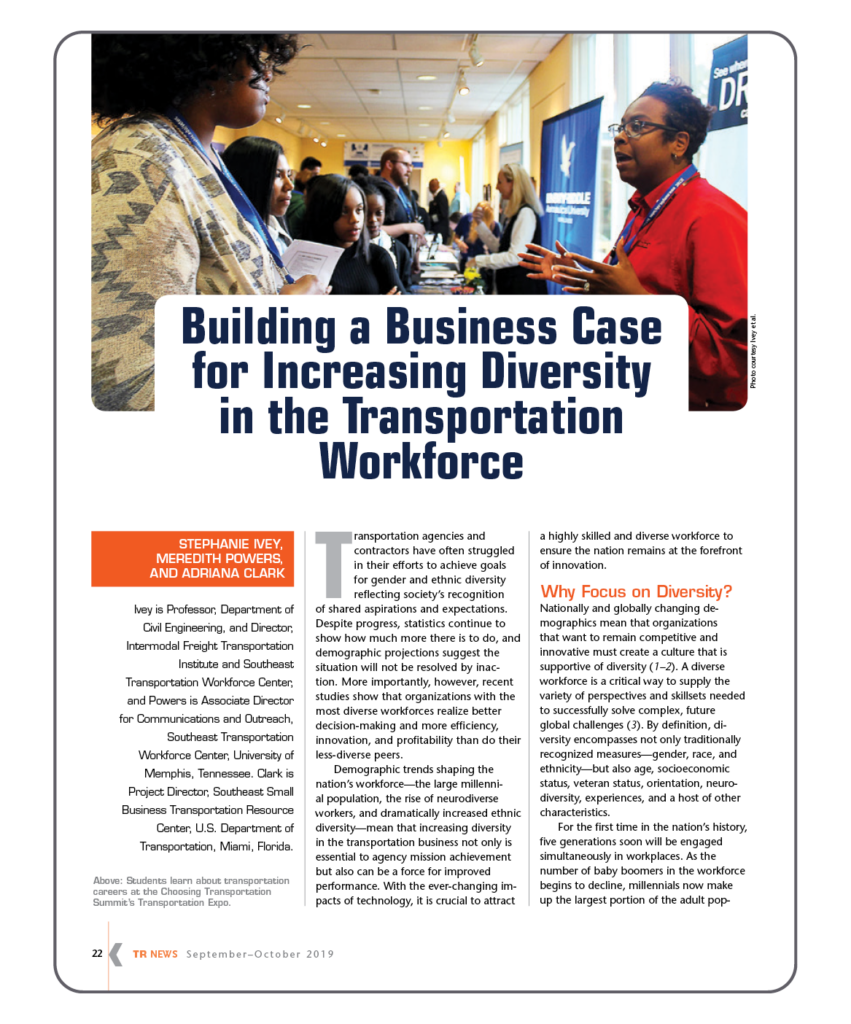
Building a Business Case for Increasing Diversity in the Transportation Workforce
This TR News article describes the importance of cultivating diversity in the transportation industry. It describes the current and future state of diversity in the country and workforce at large, and reviews existing research on the workplace benefits of diversity. It also provides several strategies for fostering diversity in the transportation industry and examples of transit stakeholders that have used those strategies.
Transportation Research Board
October 2019
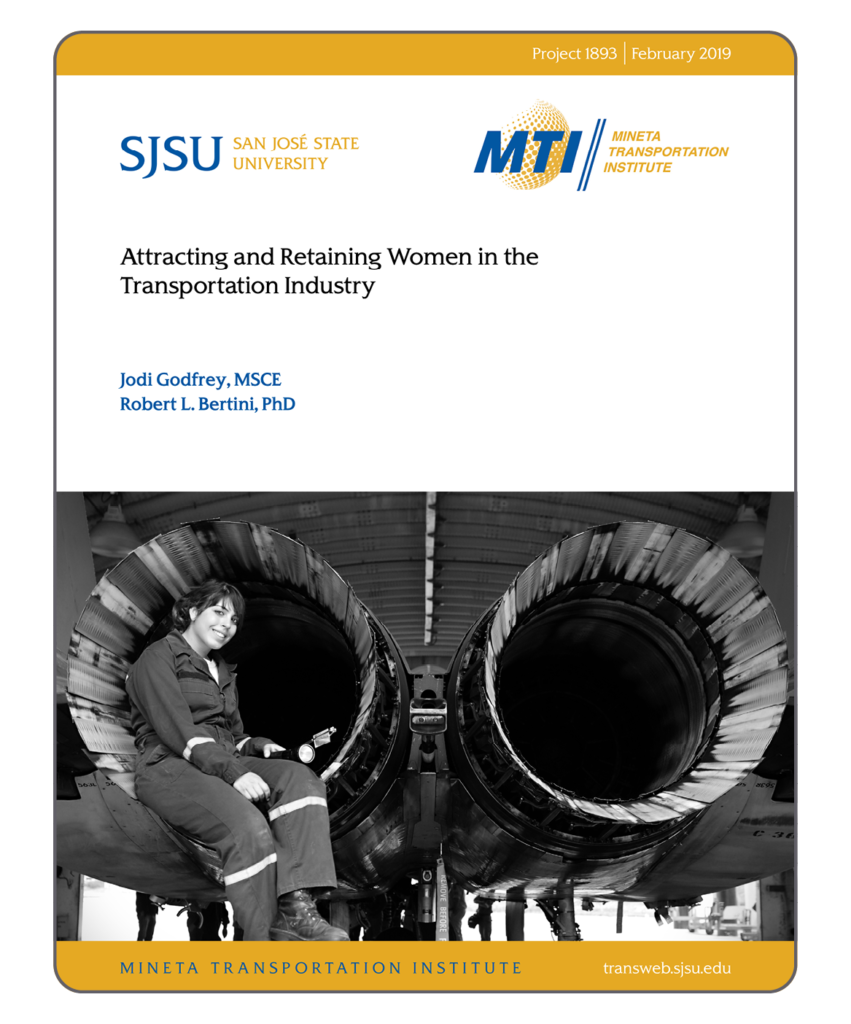
Attracting and Retaining Women in the Transportation Industry
This study synthesizes previously conducted research and identifies additional research needed to attract, promote, and retain women in the transportation industry, particularly emphasizing the importance of community-orientation and mentoring.
Mineta Transportation Institute
February 2019
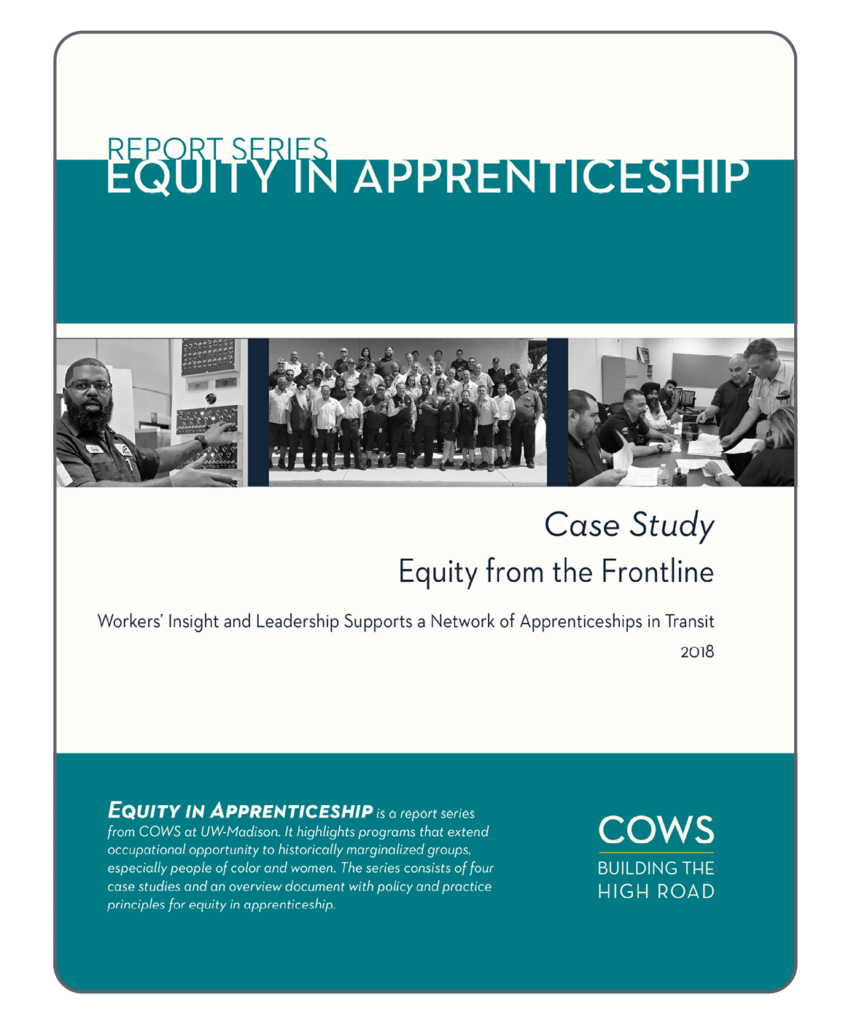
Equity from the Frontline: Workers’ Insight and Leadership Supports a Network of Apprenticeships in Transit
This case study, part of the Equity in Apprenticeship report series from COWS at UW-Madison, explores the Joint Workforce Investment in the South Bay Valley Transportation Authority, which has developed a web of apprenticeships and advancement opportunities. The series highlights programs that use apprenticeship and mentorship to extend occupational opportunity to historically marginalized groups, especially people of color and women.
COWS at University of Wisconsin
August 2018
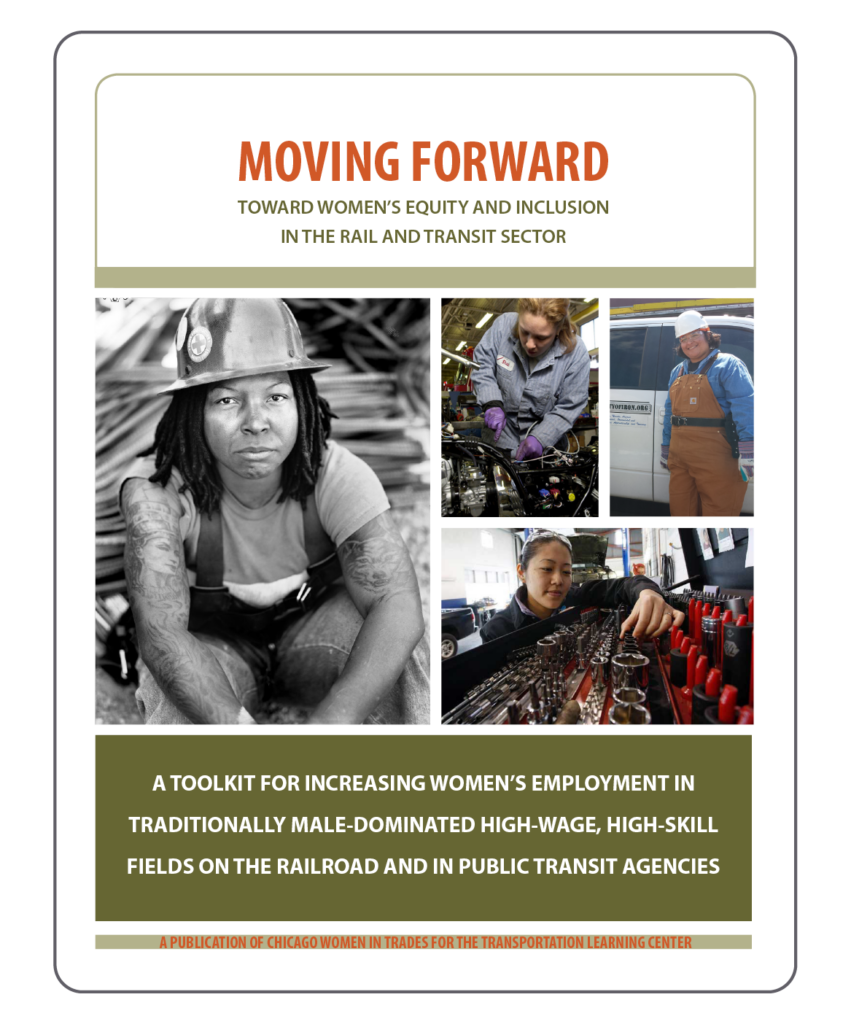
Moving Forward: Toward Women’s Equity and Inclusion in the Rail and Transit Sector
International Transportation Learning Center; Chicago Women in the Trades
July 2017
This toolkit is premised on the understanding that transit agencies have little knowledge of and tools for recruiting and assessing new female entrants to the workforce and promoting incumbent workers for skilled trade jobs in rail and transit. It also recognizes that women themselves have little information about the entry routes, requirements and benefits of jobs in these fields and without targeted and concerted effort from either the companies, agencies, unions, workforce development system, and educational institutions, most women will continue to be steered towards traditional female careers.
The resources in this toolkit will support the recruitment, training, and retention of women in nontraditional apprenticeship and jobs in the rail and transit sector. The toolkit can be used by program planners, managers, and frontline staff conducting outreach and assessment and training, to ensure that each stage of the employment process—from recruitment through retention—looks at how the workplace environment can be responsive to women of many backgrounds and how systems can be created or improved to address the barriers women face.
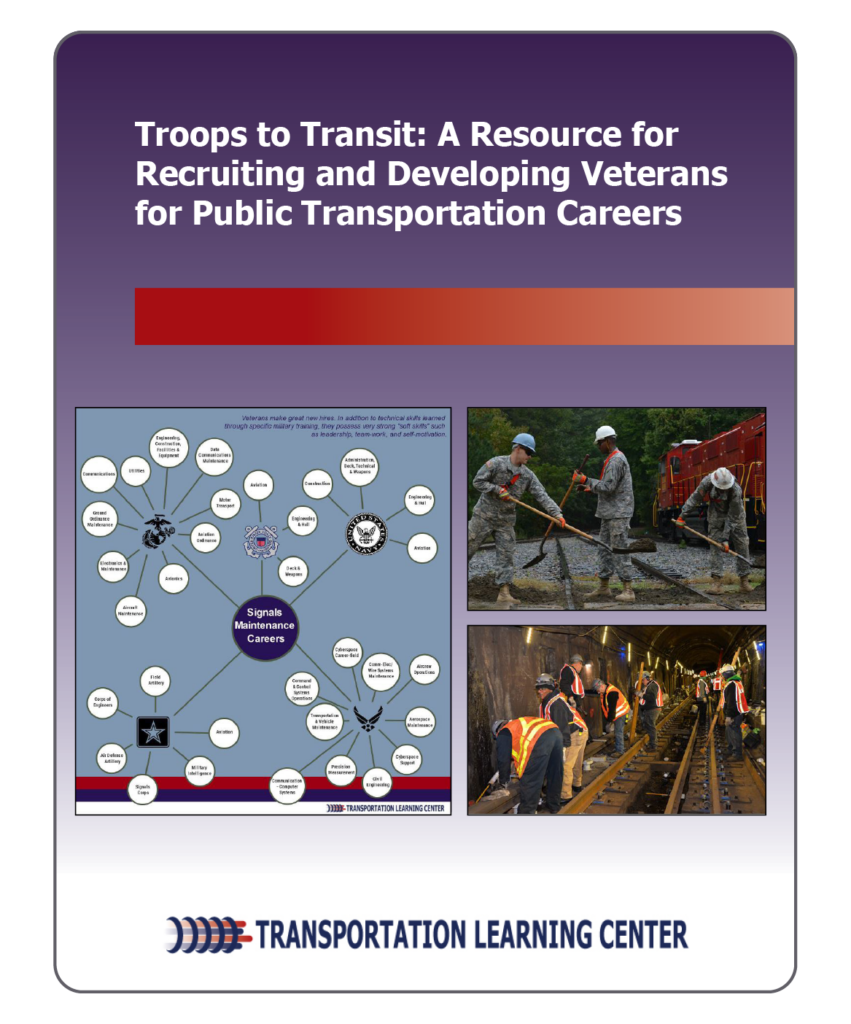
Troops to Transit: A Resource for Recruiting and Developing Veterans for Public Transportation Careers
The International Transportation Learning Center’s analysis of Bureau of Labor Statistics data has shown that the transportation industry in large will likely see a massive front-line labor shortage in the next ten years unless it is able to find and hire skilled workers. In fact, it is estimated that 126 percent of today’s transit workforce will have to be hired and trained in the next ten years.
In order to help fill this need, the center has produced a Veterans Crosswalk tool (see Excel document below) which matches skill-sets learned during military service with the kinds of skills that public transportation agencies look for when hiring signals maintainers. This product was produced in cooperation with a Veterans Taskforce made up of veterans who are also Subject Matter Experts in the field of Signals Maintenance. This detailed matrix has been distilled down into a user-friendly Veteran’s Factsheet (see PDF below) which provides at-a-glance information for both veterans interested in a signals career and for agencies looking to hire skilled veterans.
The tool is accompanied by a summary report.
International Transportation Learning Center
November 2016
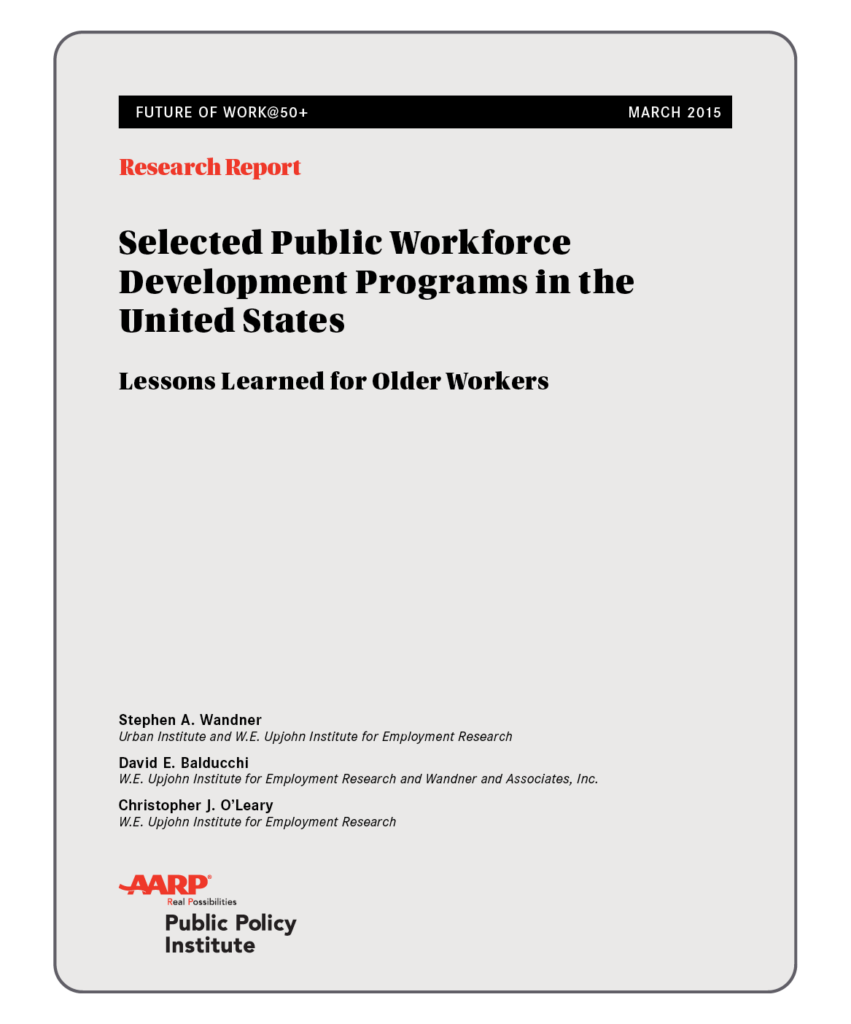
Selected Public Workforce Development Programs in the United States: Lessons Learned for Older Workers
This report provides a selective review of public workforce development programs in the United States over the past 80 years, placing special emphasis on the importance these programs have to older Americans. It discusses how the public workforce system developed, how it operates today, significant programs and target groups, common employment services and job training strategies, and what is known about program effectiveness.
American Association of Retired Persons
March 2015
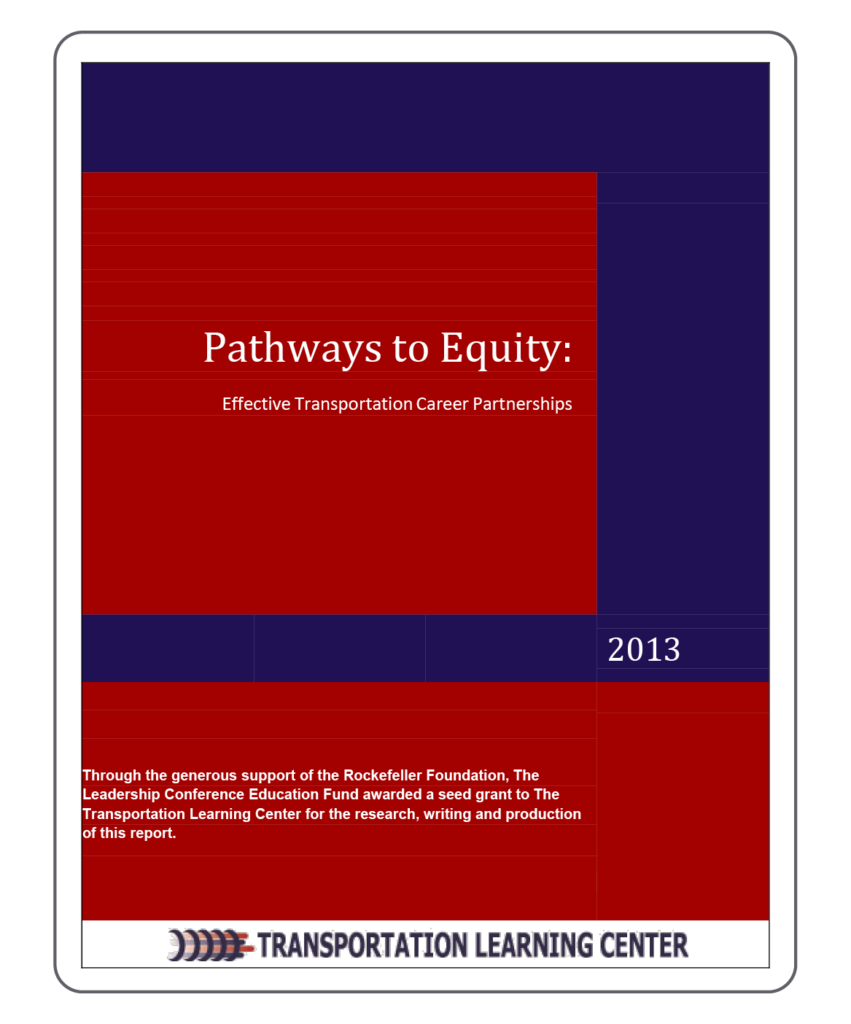
Pathways to Equity: Effective Transportation Career Partnerships
Expanding access to quality careers in transit systems and in transit capital construction has been the focus of innovative local programs around the country in recent years. This report presents case profiles of two of the most promising examples – one for youth Career Pathways into transit industry careers, and one for targeted construction hiring and training of disadvantaged workers for transit capital projects. The two local case profiles are a Project Labor Agreement in Los Angeles providing expanded access to jobs and training for public transportation capital construction and a youth Career Pathways partnership in Philadelphia linking career and technical education with future transit careers. Both of these models, if taken to scale in the transit industry, can have positive impacts, locally and nationally, for improving access to family-sustaining careers and training and for improving educational outcomes for disadvantaged groups – urban low-income and minority groups as well as women – who have previously been under-represented in these occupations.
International Transportation Learning Center
December 2013
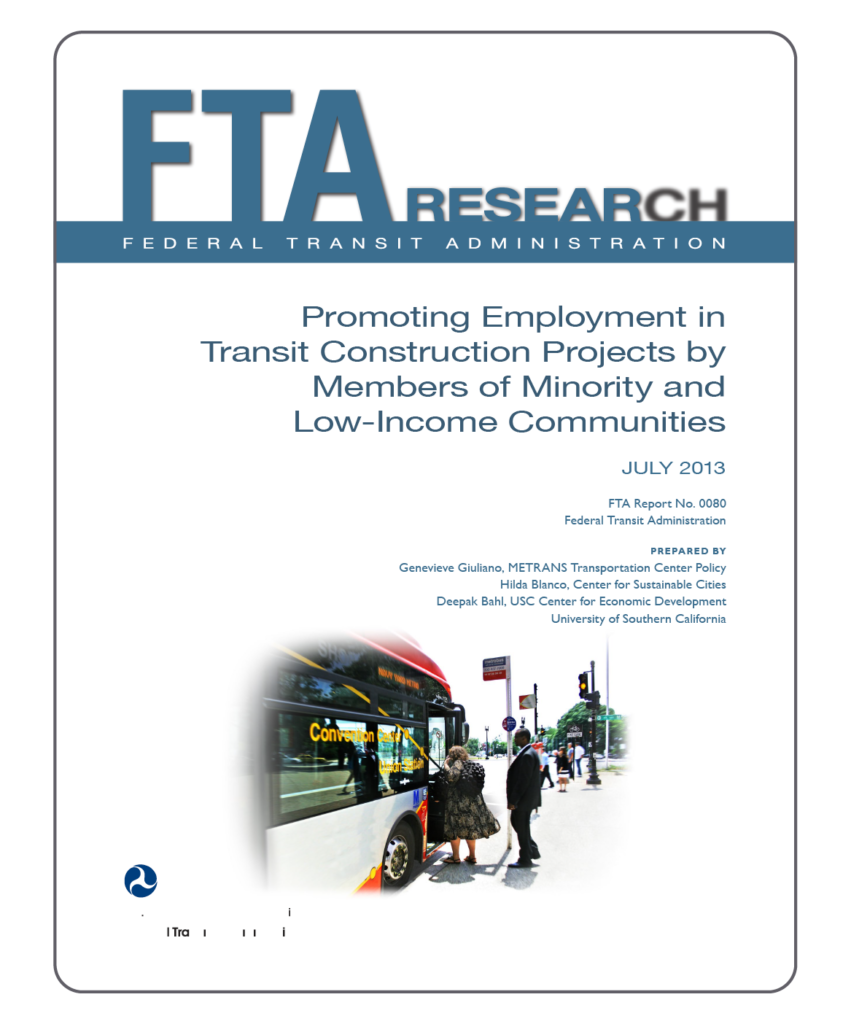
Promoting Employment in Transit Construction Projects by Members of Minority and Low Income Communities
This report summarizes research investigating the participation of members of low-income and minority populations in employment generated by transit projects and identifies practices to increase their participation. It features four in-depth case studies of light rail projects.
Federal Transit Administration
July 2013
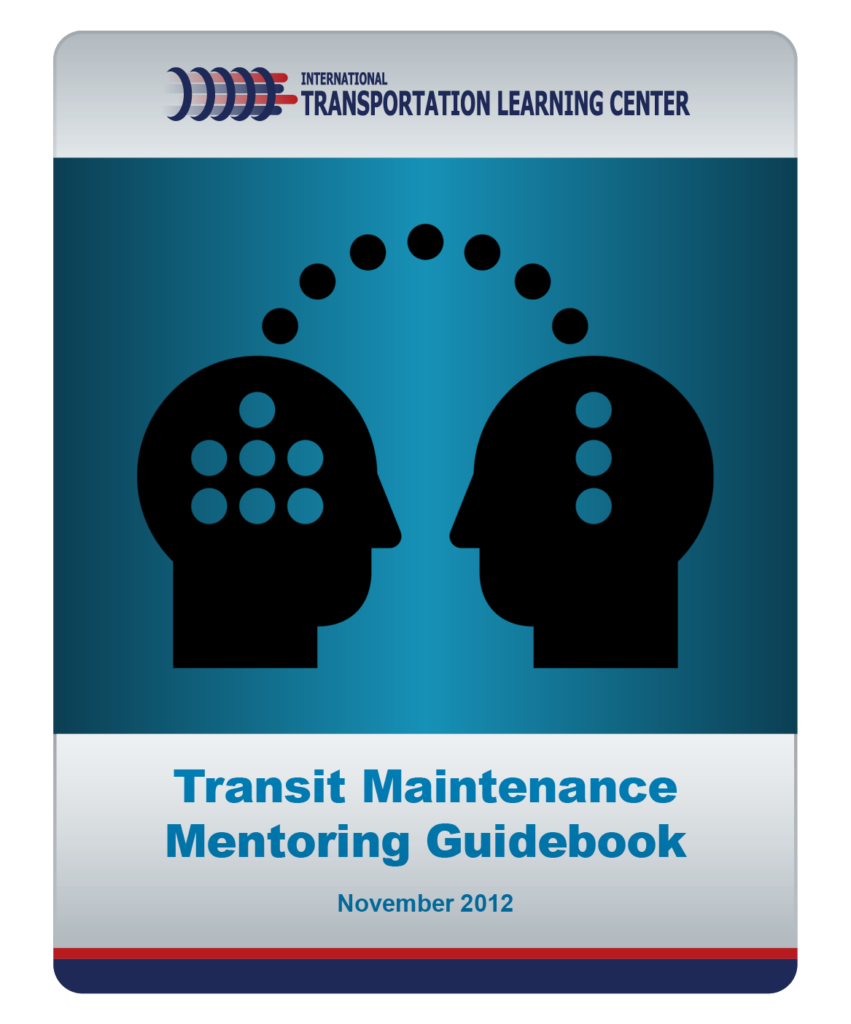
Transit Maintenance Mentoring Guidebook
The purpose of this report is to serve as a guidebook, offering information that transit agencies can use to establish mentoring as a training method with guidance, suggestions, and examples to implement or expand upon existing mentoring programs. It is based on a generic mentoring guidebook developed by the USDOT, modified and enhanced to reflect transit maintenance applications.
International Transportation Learning Center
November 2012
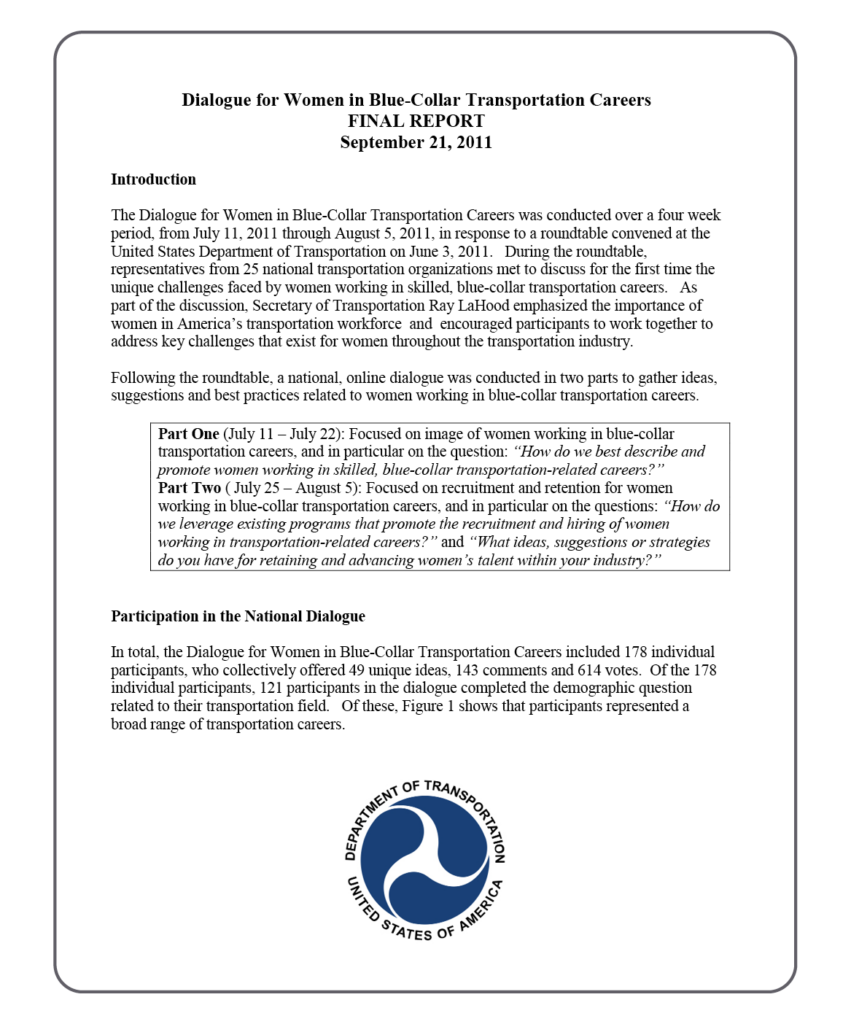
Dialogue for Women in Blue-Collar Transportation Careers
This short summary report describes unique challenges and recommendations regarding women in blue-collar positions in transportation.
US Department of Transportation
September 2011
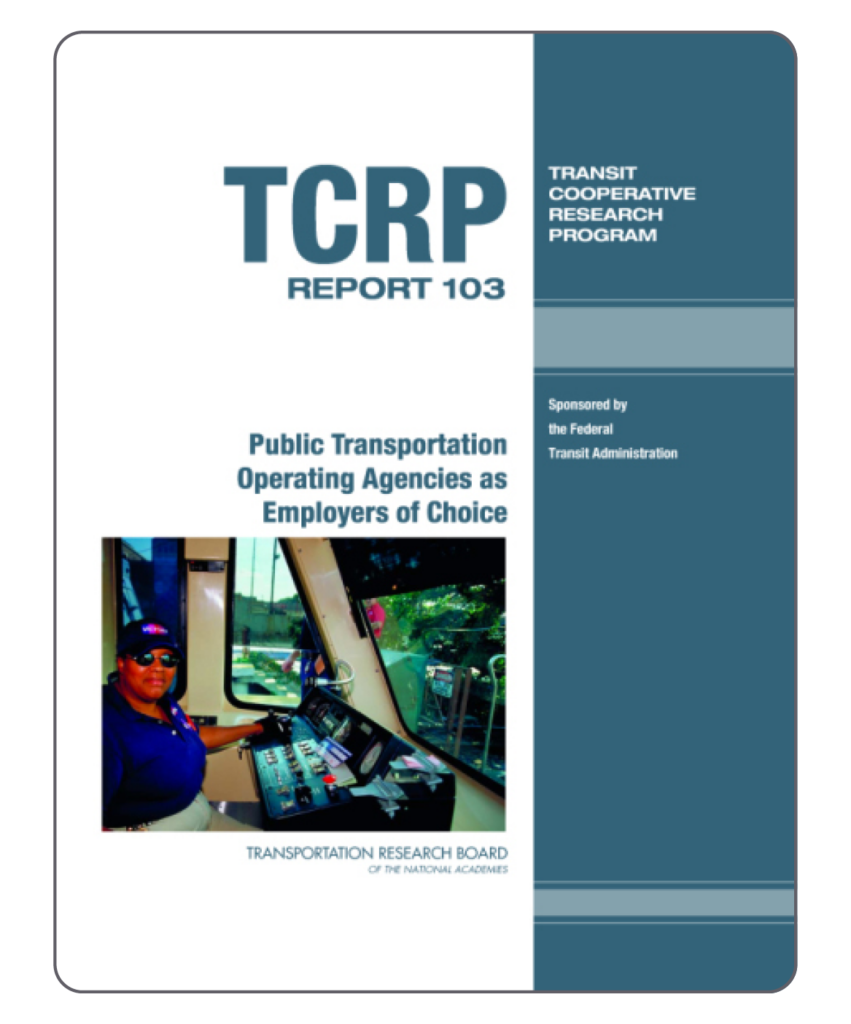
Public Transportation Operating Agencies as Employers of Choice
TRB’s Transit Cooperative Research Program (TCRP) Report 103 documents principles, techniques, and strategies that are used in workforce recruitment, development, and retention. The report includes a companion document, “Communications Strategy and Implementation Plan, Positioning the Public Transportation Operating Agency as an Employer of Choice” that describes strategies and solutions that offer the greatest potential for positioning public transportation operating agencies as an employer of choice.
Contributors: Watson Wyatt Worldwide and Focus Group Corporation
Transit Cooperative Research Program
January 2004

Appalachian Regional Initiative for Stronger Economies (ARISE)
Administering Agency: Appalachian Regional Commission (ARC)
Closing Date for Applications: Applications will be accepted on a rolling basis
Funding Range: $73.5M available total
Geographic Scope: Regional
Description: ARISE is an ARC initiative that aims to drive large-scale, regional economic transformation through multistate, collaborative projects across Appalachia.
With the additional funding provided by the Bipartisan Infrastructure Law, also known as the Infrastructure Investment and Jobs Act of 2021, ARC launched ARISE to strengthen Appalachian business and industry, and to grow and support the development of new opportunities across multiple states.
Posted January 20, 2023 to TWC Resource Center. Please refer to the link below for the most up to date information from the funder.
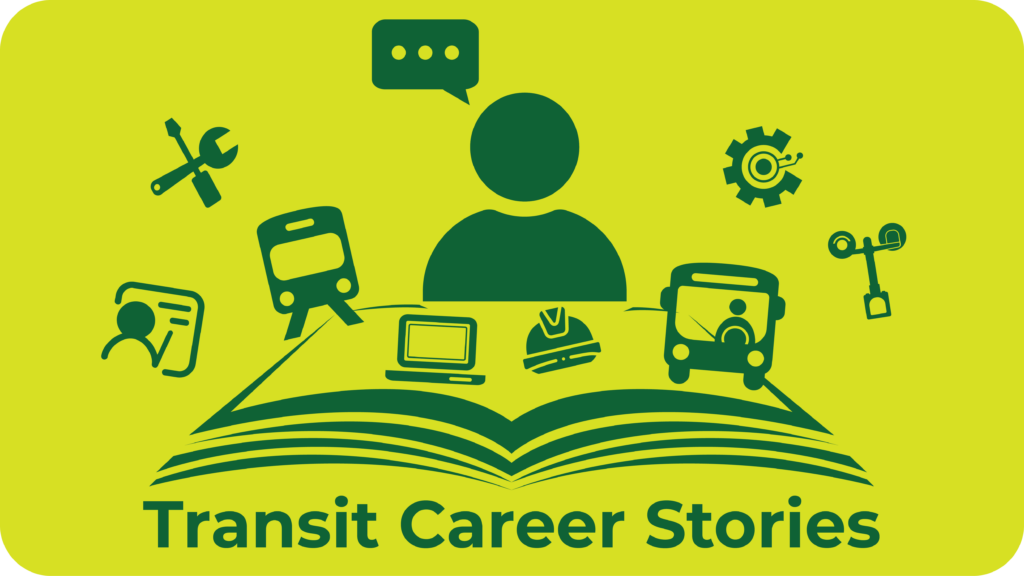
Transit Career Stories
Transit Workforce Center
Drawn from the TWC Blog and Pulse Newsletter, these Transit Career Stories showcase workers’ journeys and career pathways to help increase awareness of transit careers. Learn from these professionals and community leaders through their own telling of what they do, how they got there, and what makes their work exciting and rewarding.
 From Bus Driver to Finance Manager - Jerry Garcia's Drive to Succeed
From Bus Driver to Finance Manager - Jerry Garcia's Drive to Succeed
 Elevating Insights – ATU Local 689 Executive Board Member and Former WMATA Elevator/Escalator Journeyworker Leah Anderson
Elevating Insights – ATU Local 689 Executive Board Member and Former WMATA Elevator/Escalator Journeyworker Leah Anderson
 OT Orozco – Showcasing the Role of People With Disabilities in Transit
OT Orozco – Showcasing the Role of People With Disabilities in Transit
 Rich Diaz – Embracing the Power of Mentorship
Rich Diaz – Embracing the Power of Mentorship
 Dionna McCane – Mentoring With Heart
Dionna McCane – Mentoring With Heart
 Gwendolen Gibson – A Rail Mechanic Leading the Way
Gwendolen Gibson – A Rail Mechanic Leading the Way
 Unbreakable Bond – An Apprentice Mechanic With the Drive to Succeed
Unbreakable Bond – An Apprentice Mechanic With the Drive to Succeed






